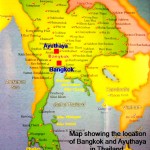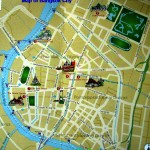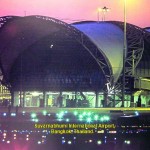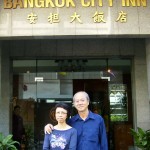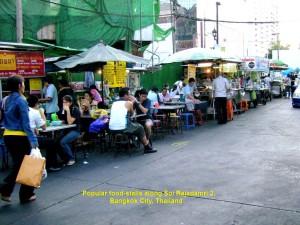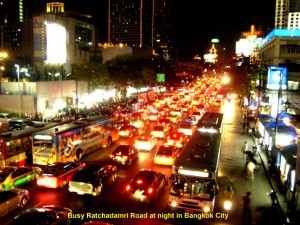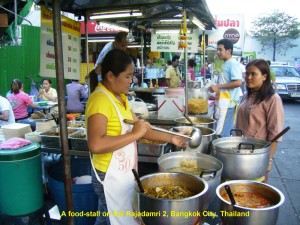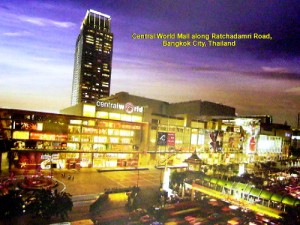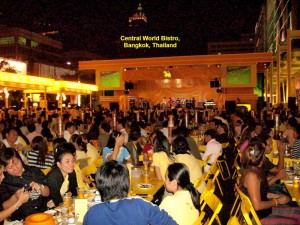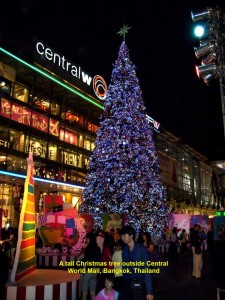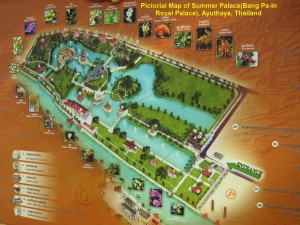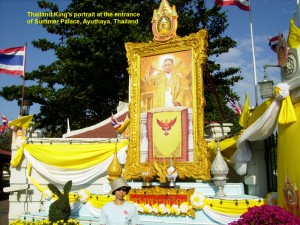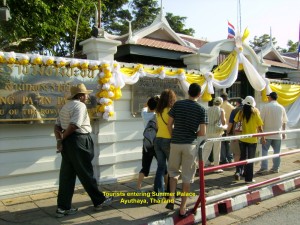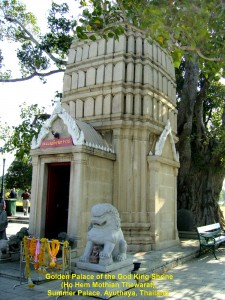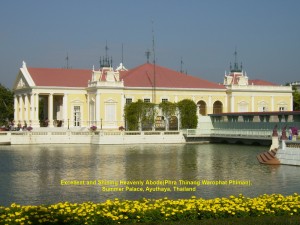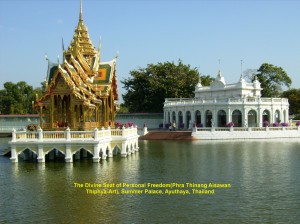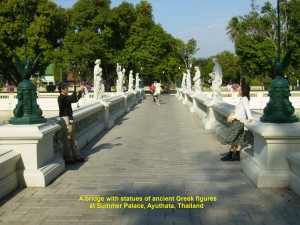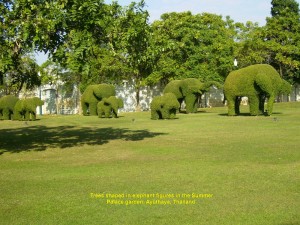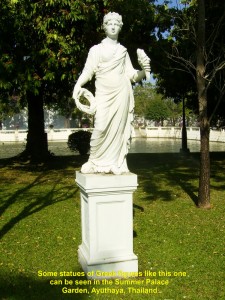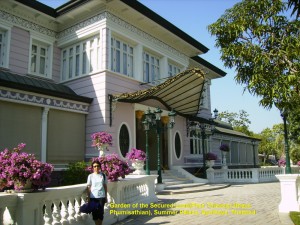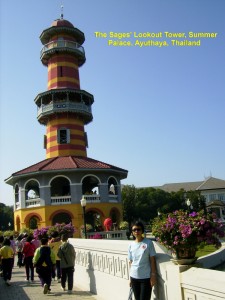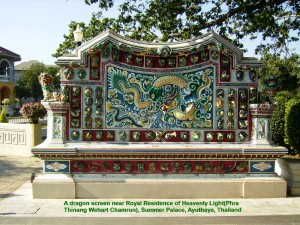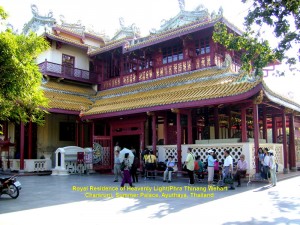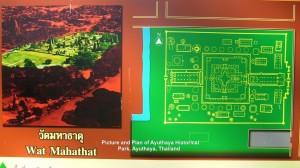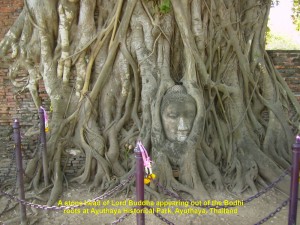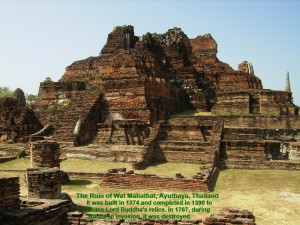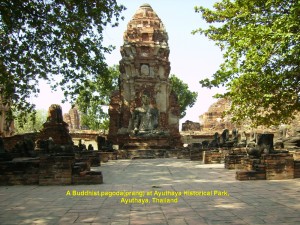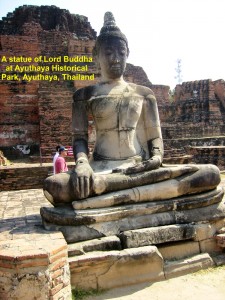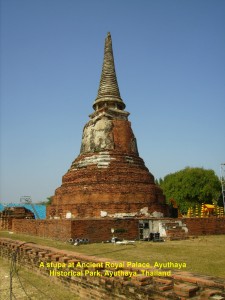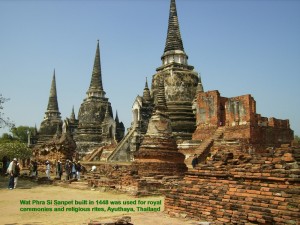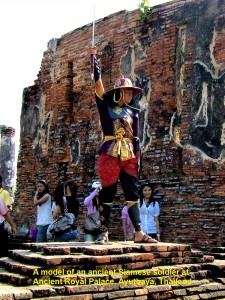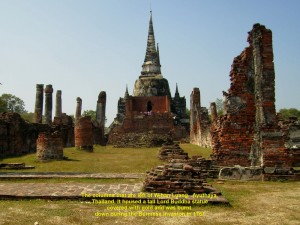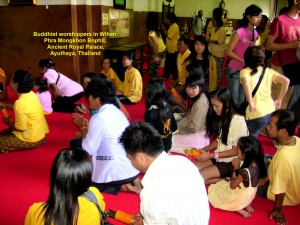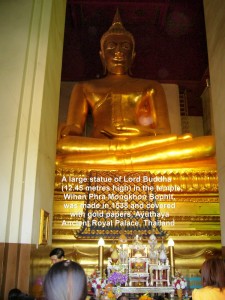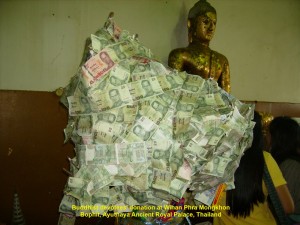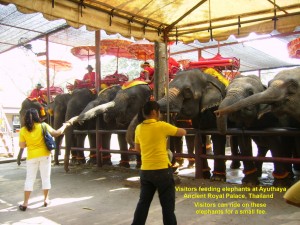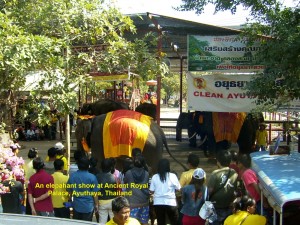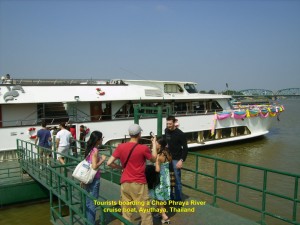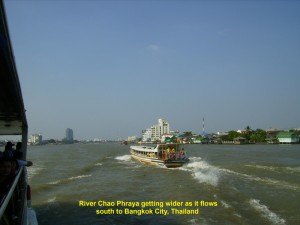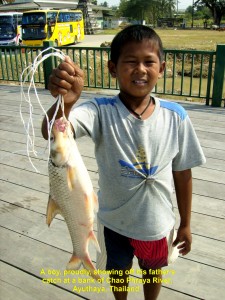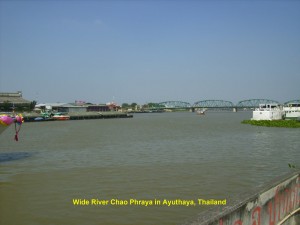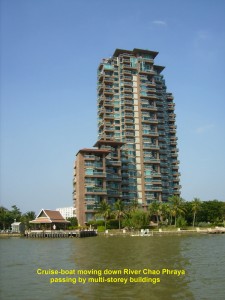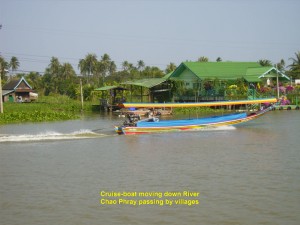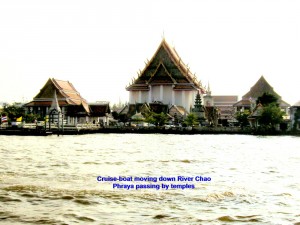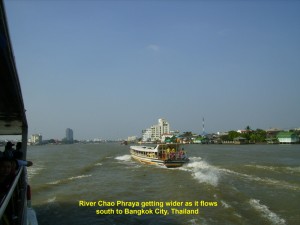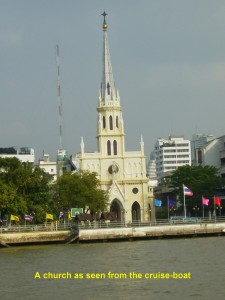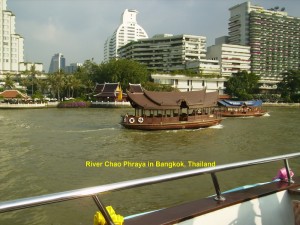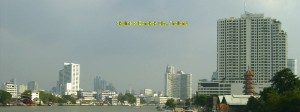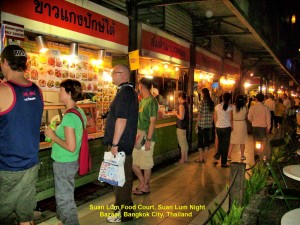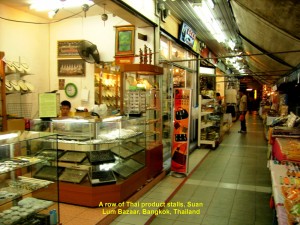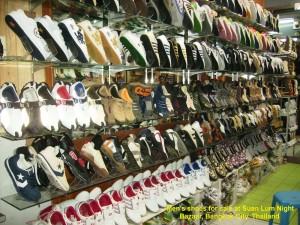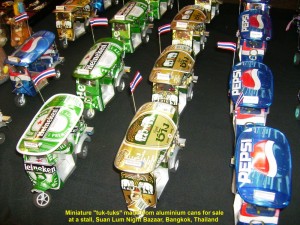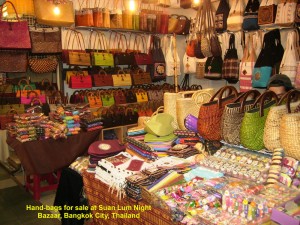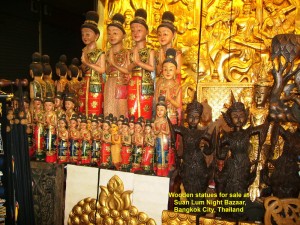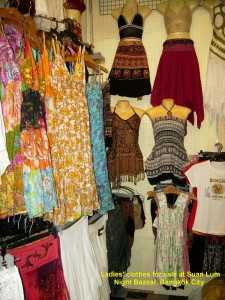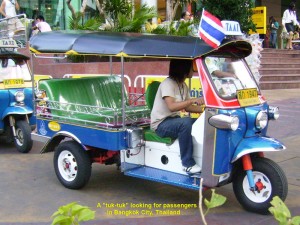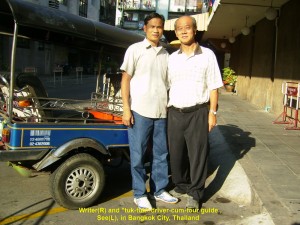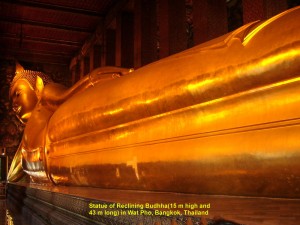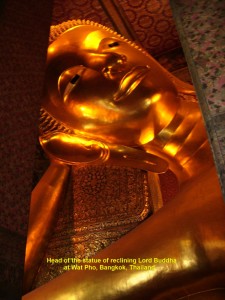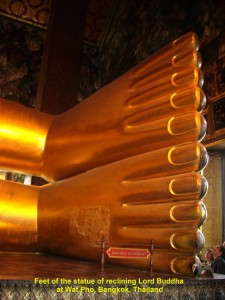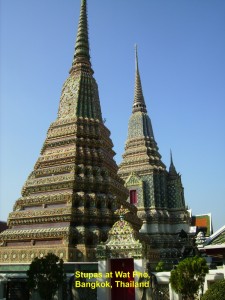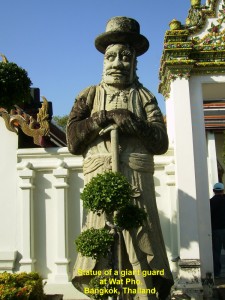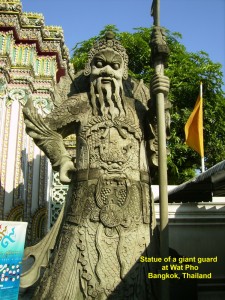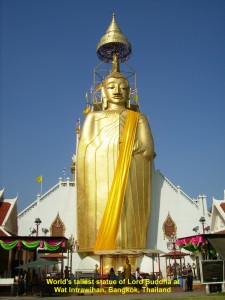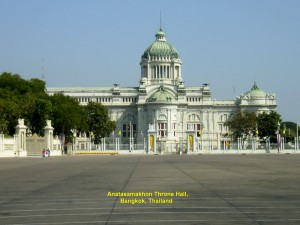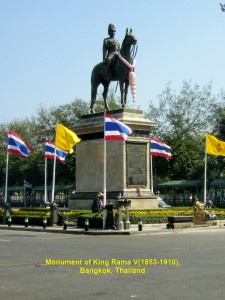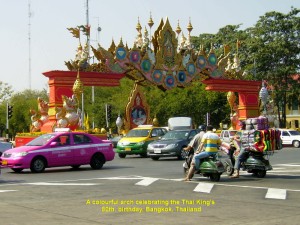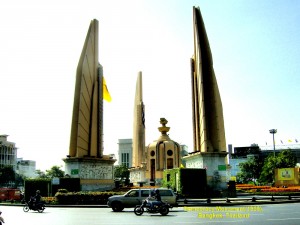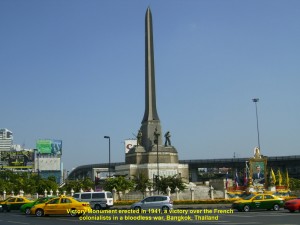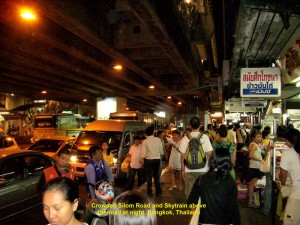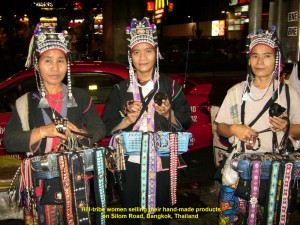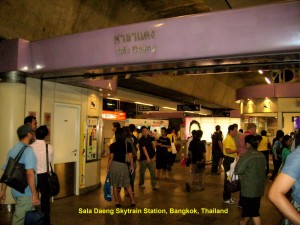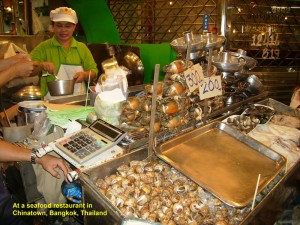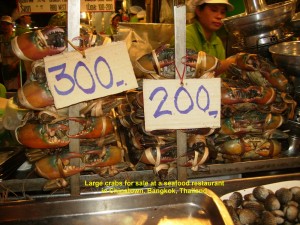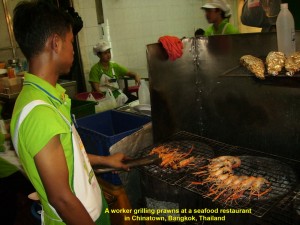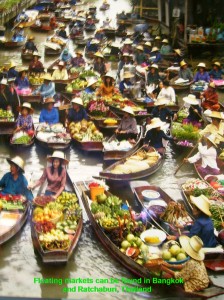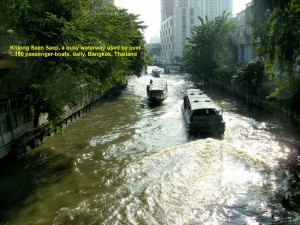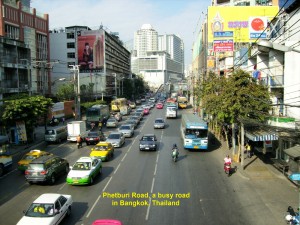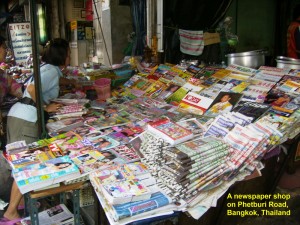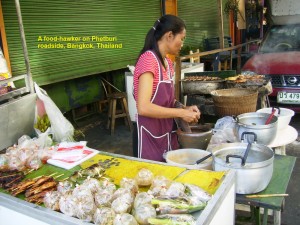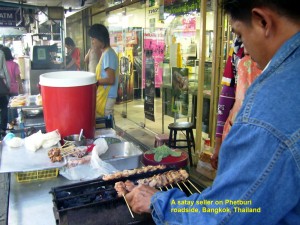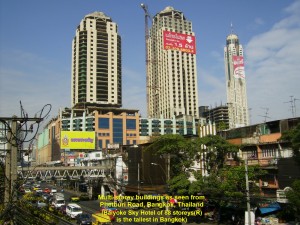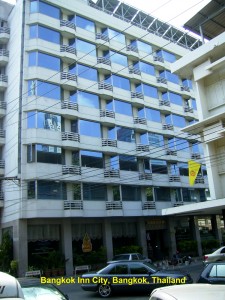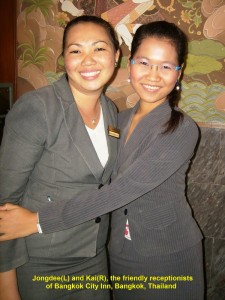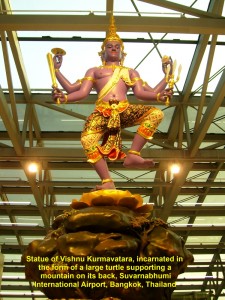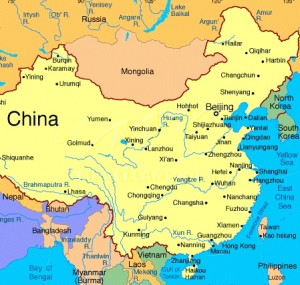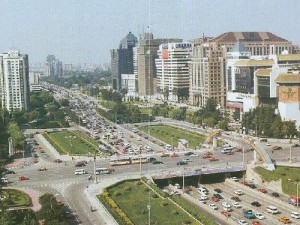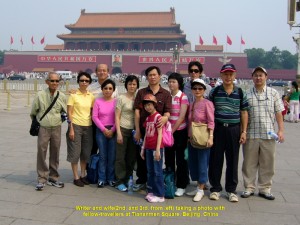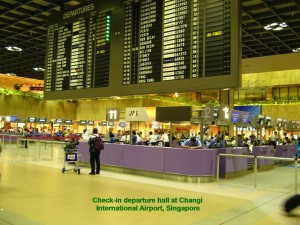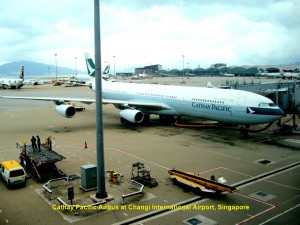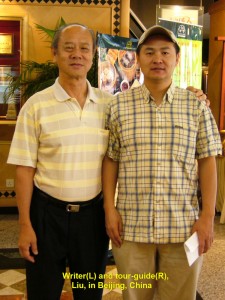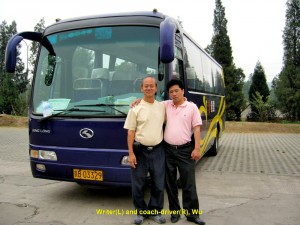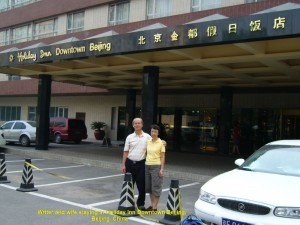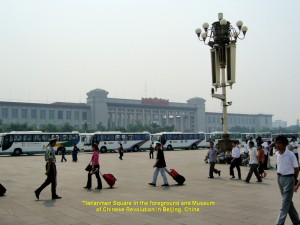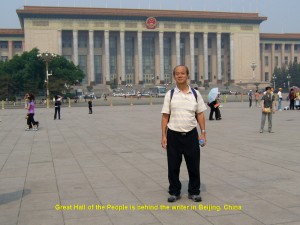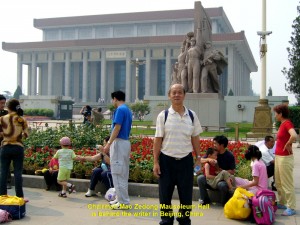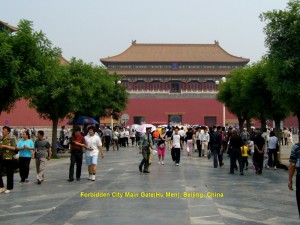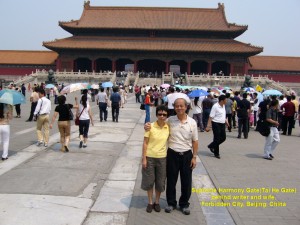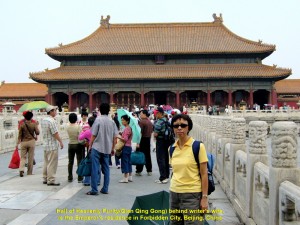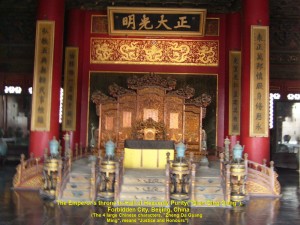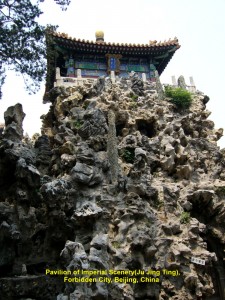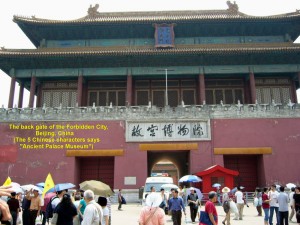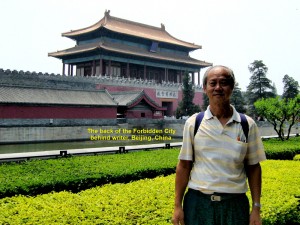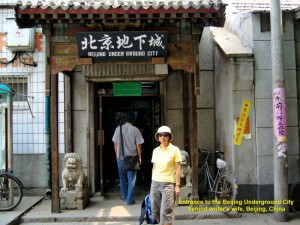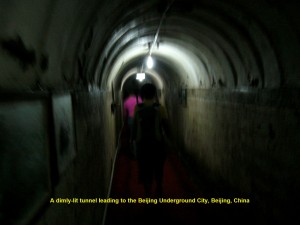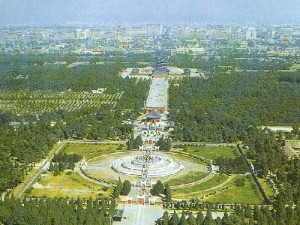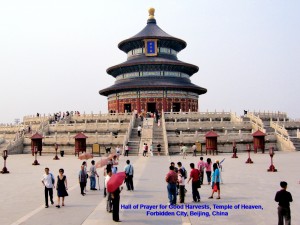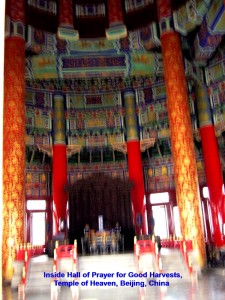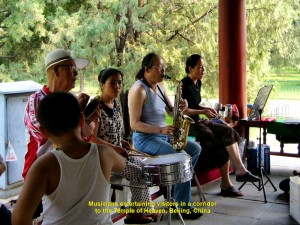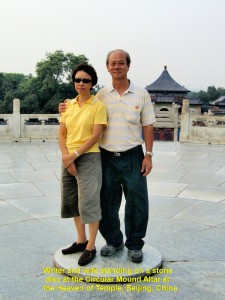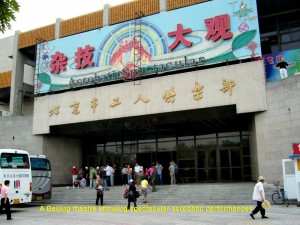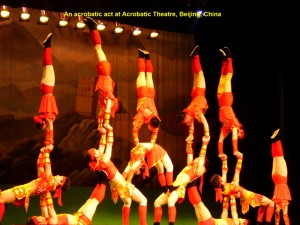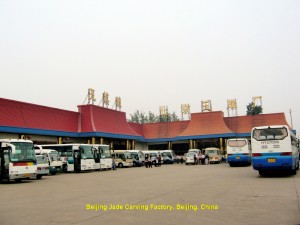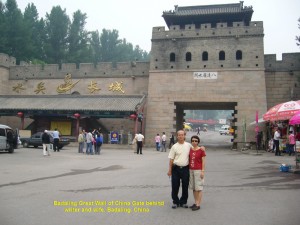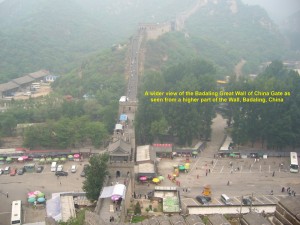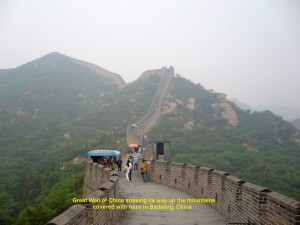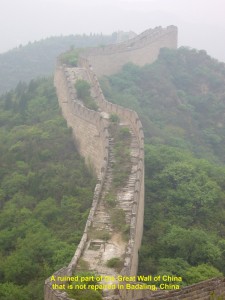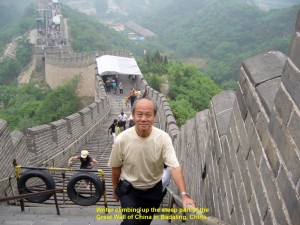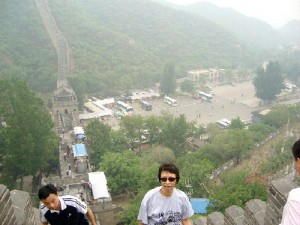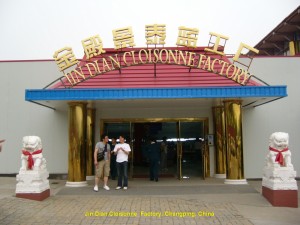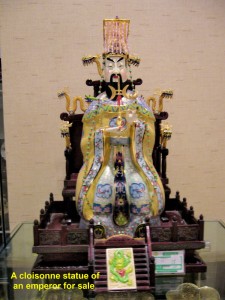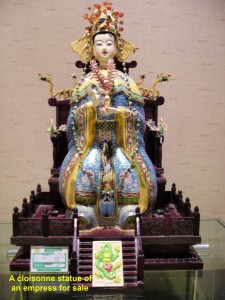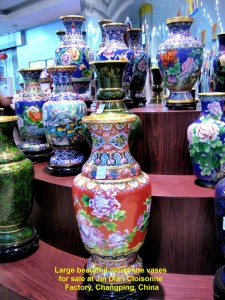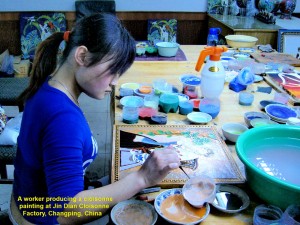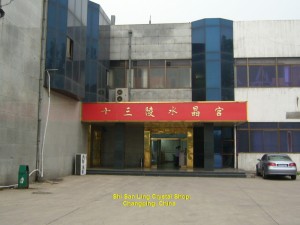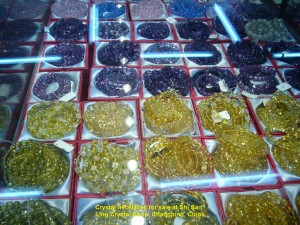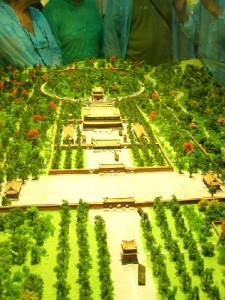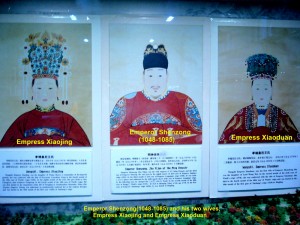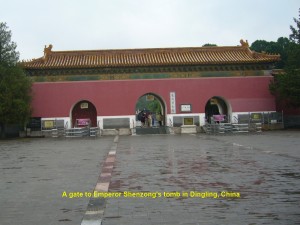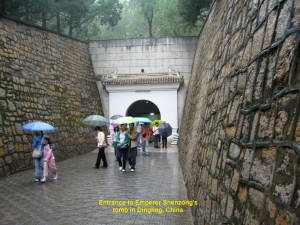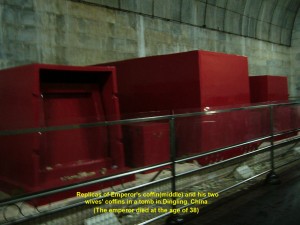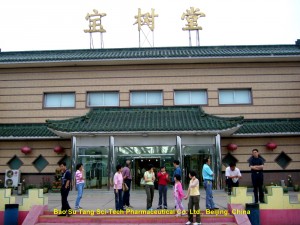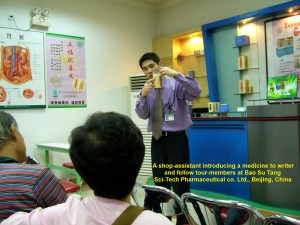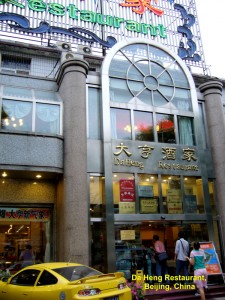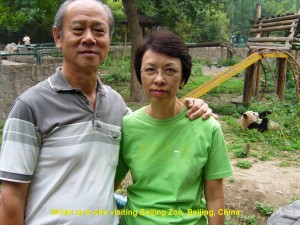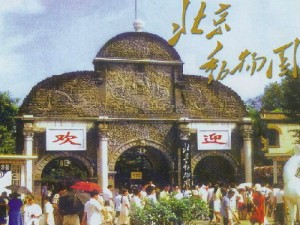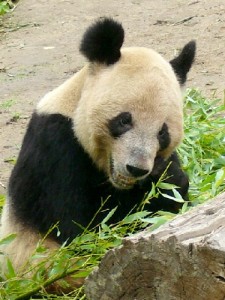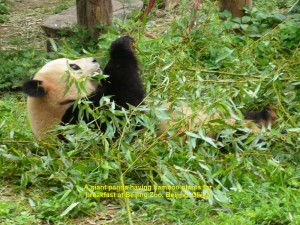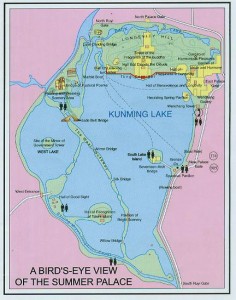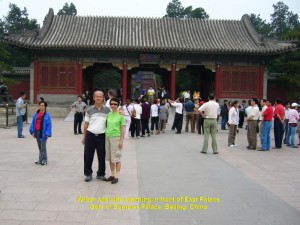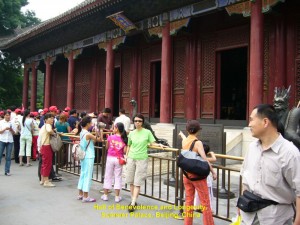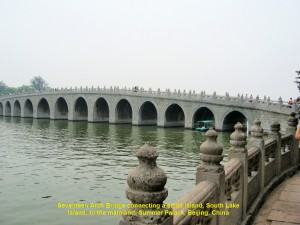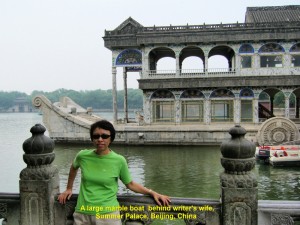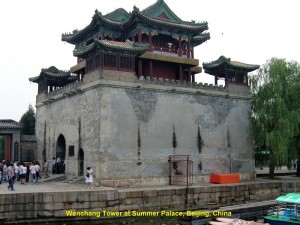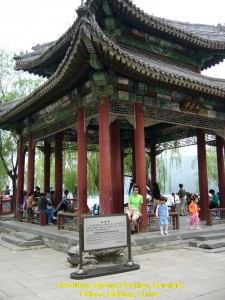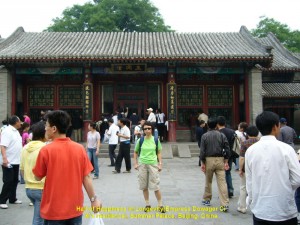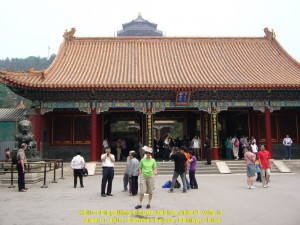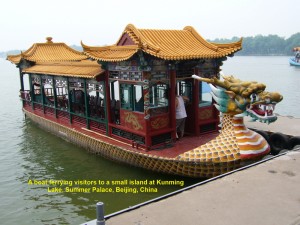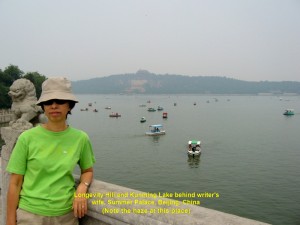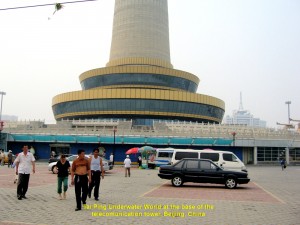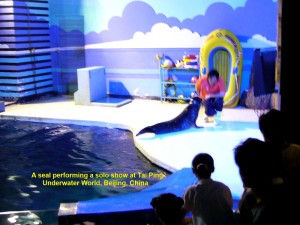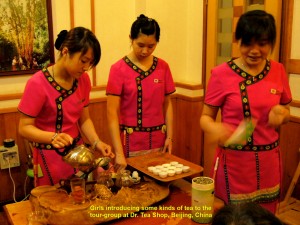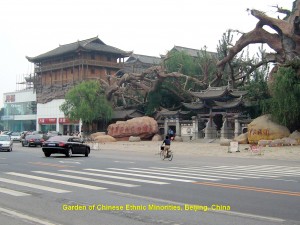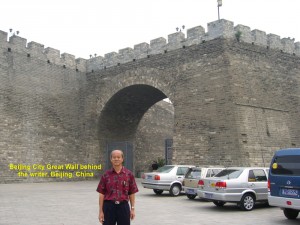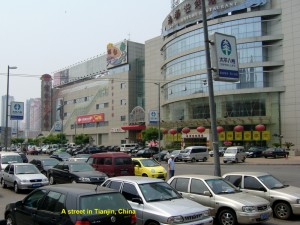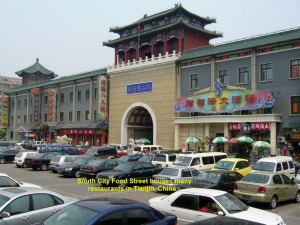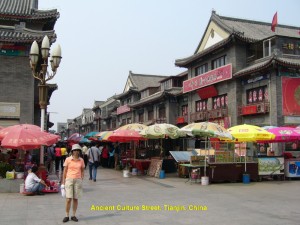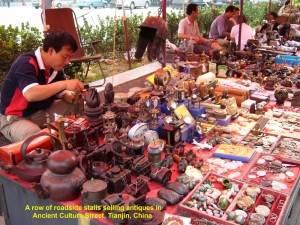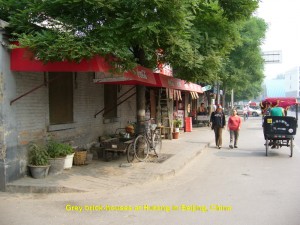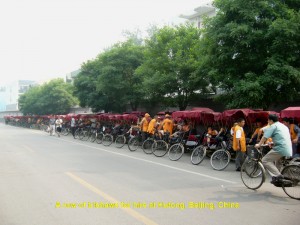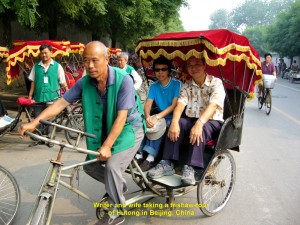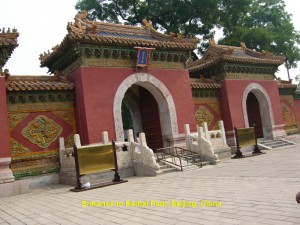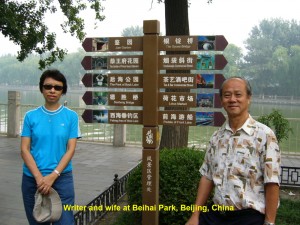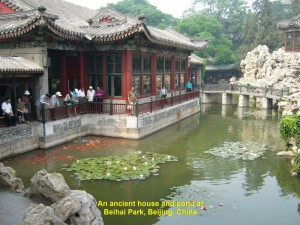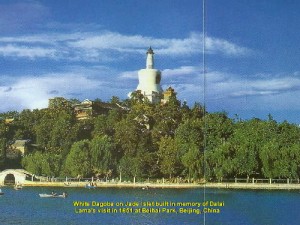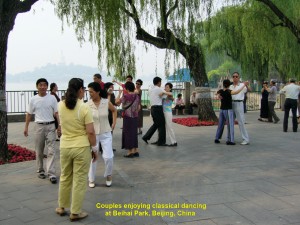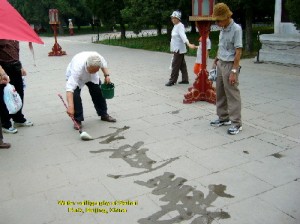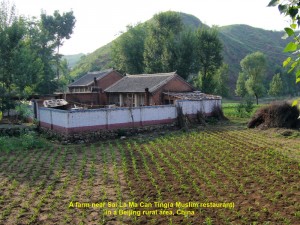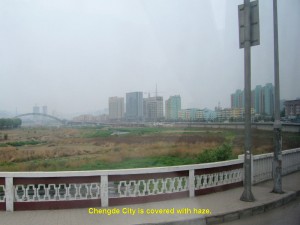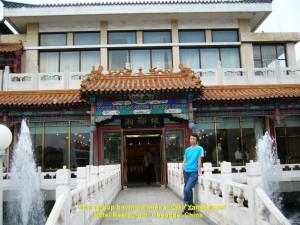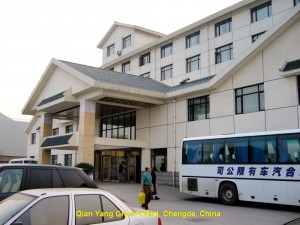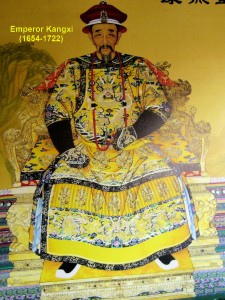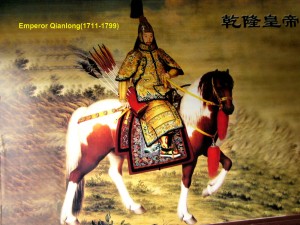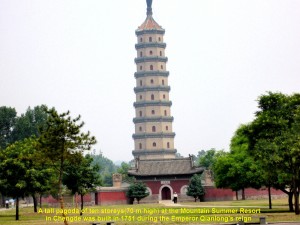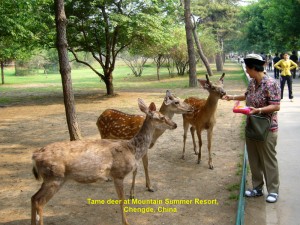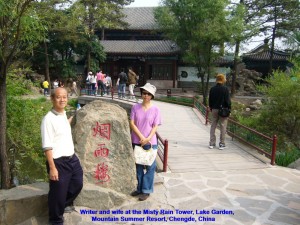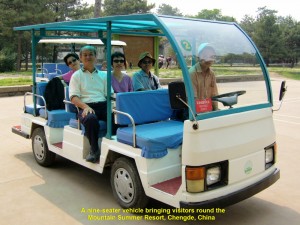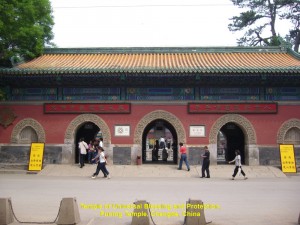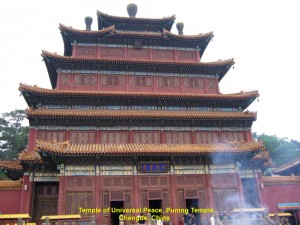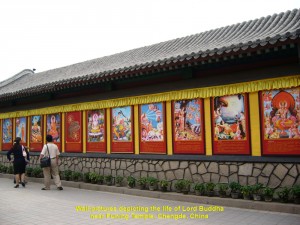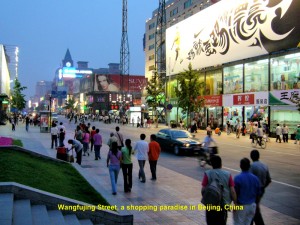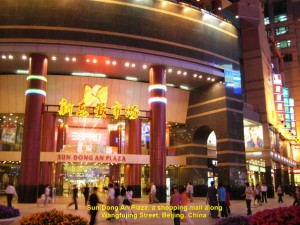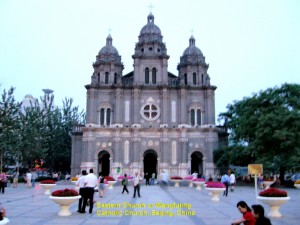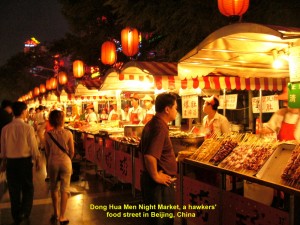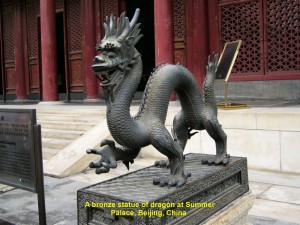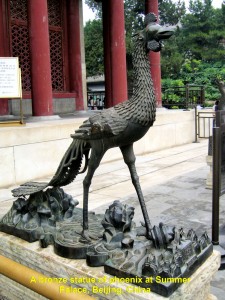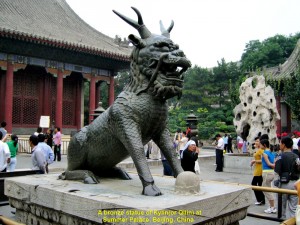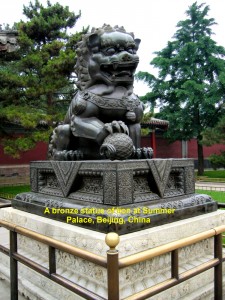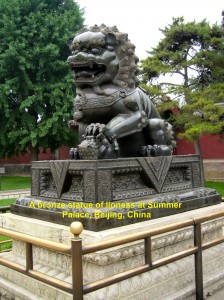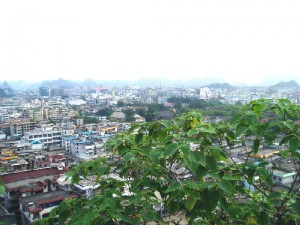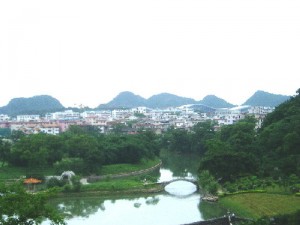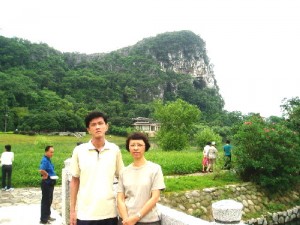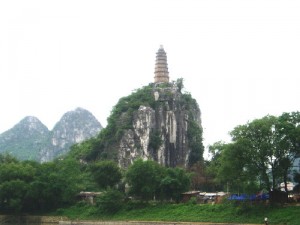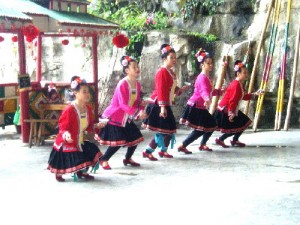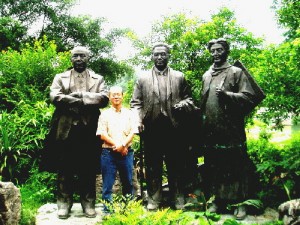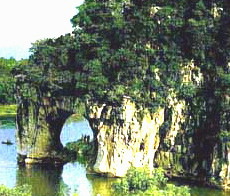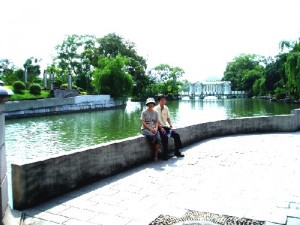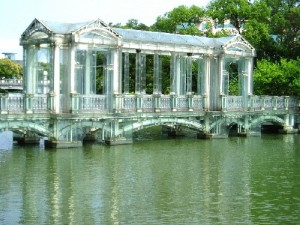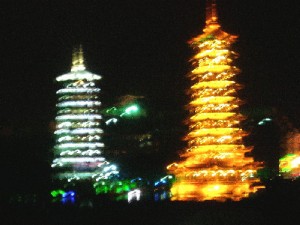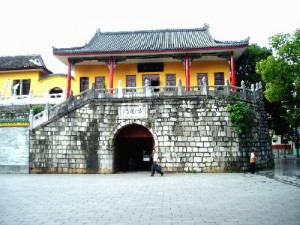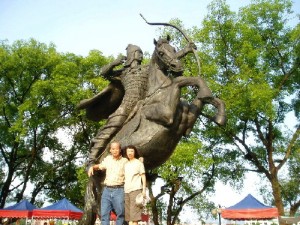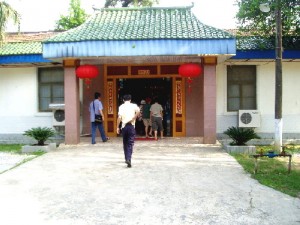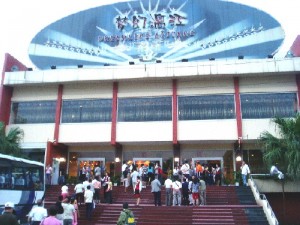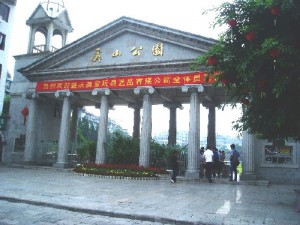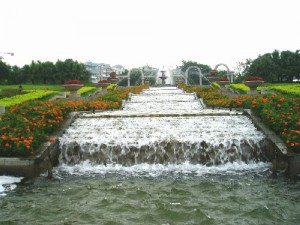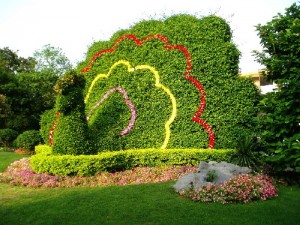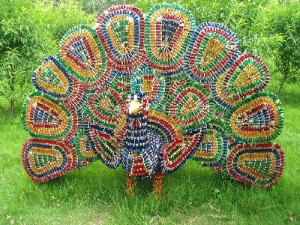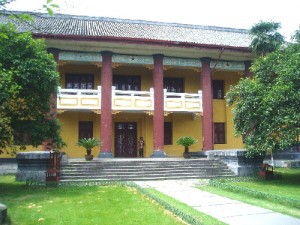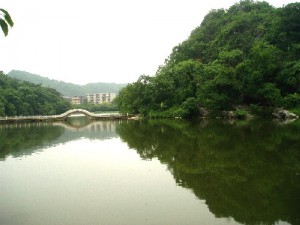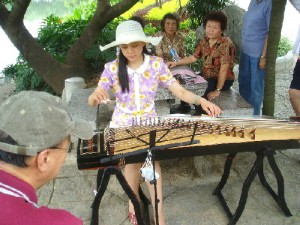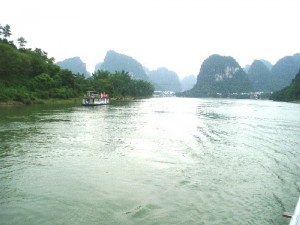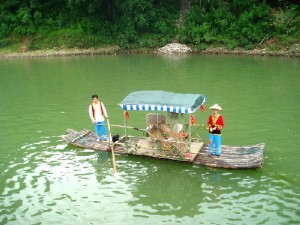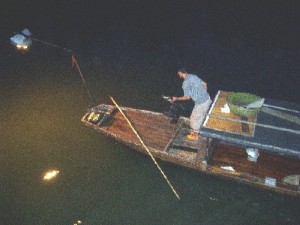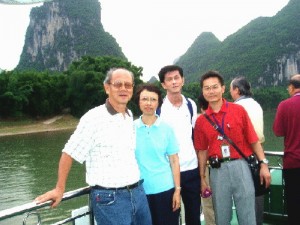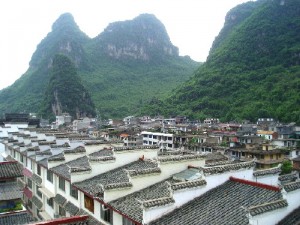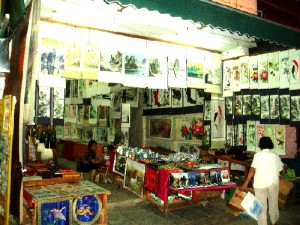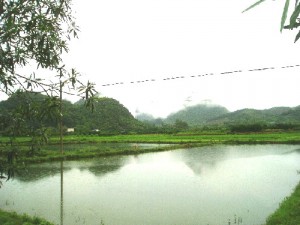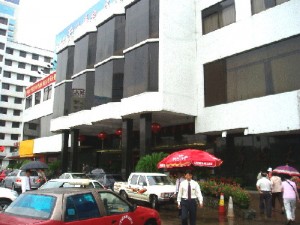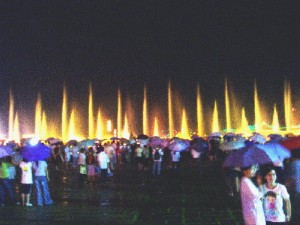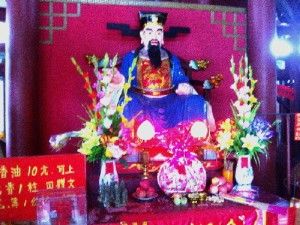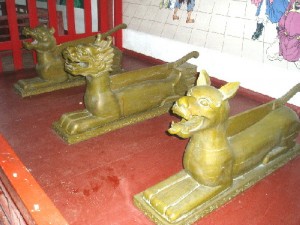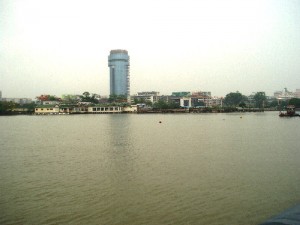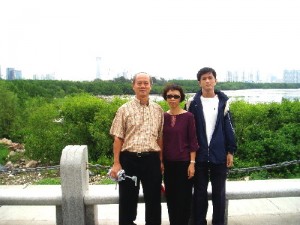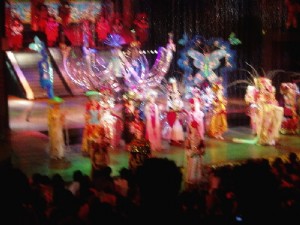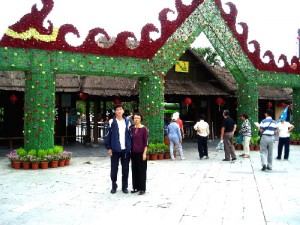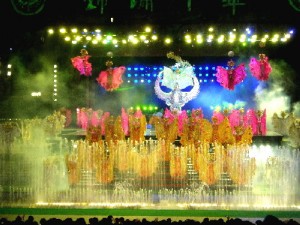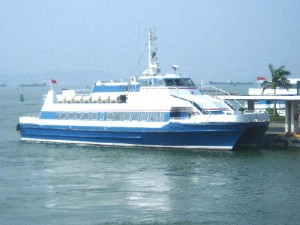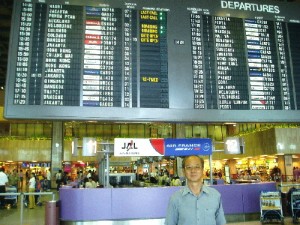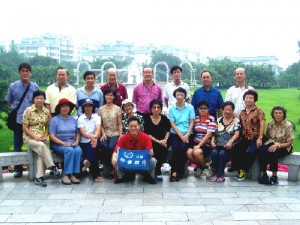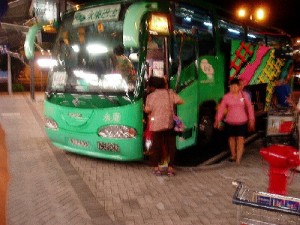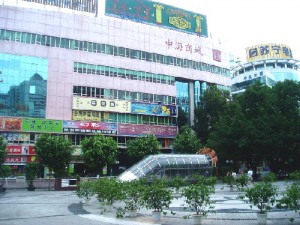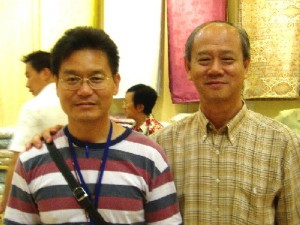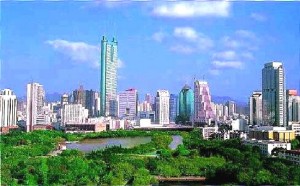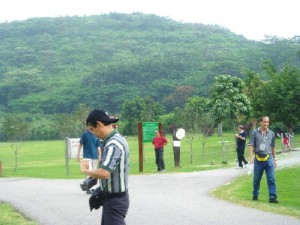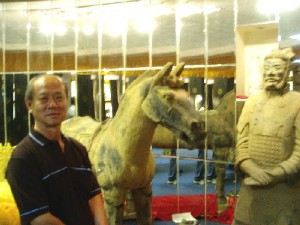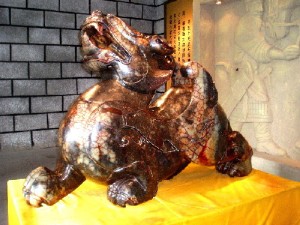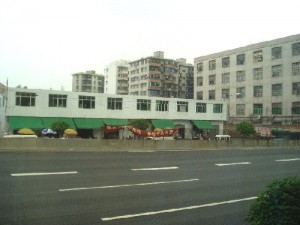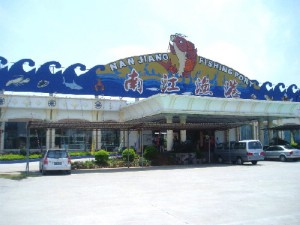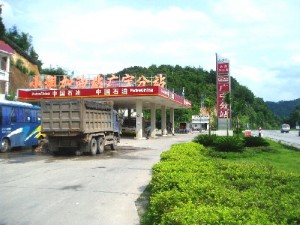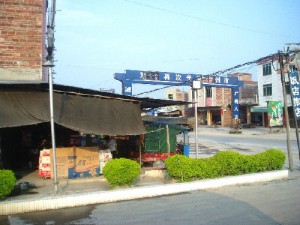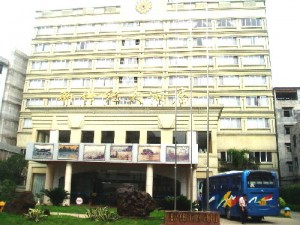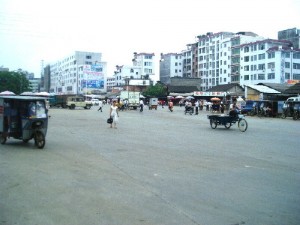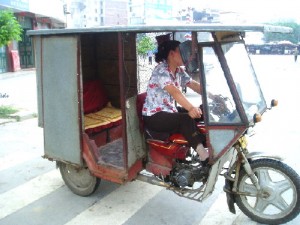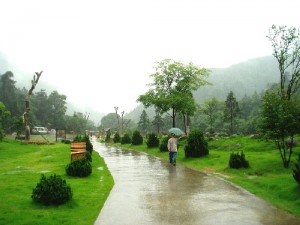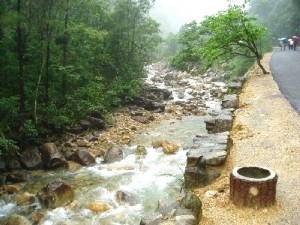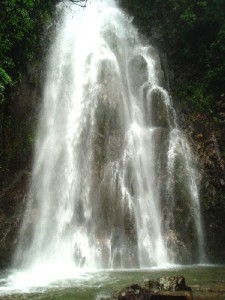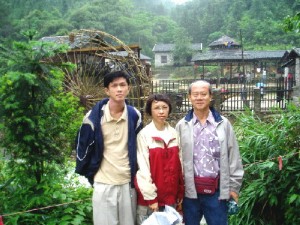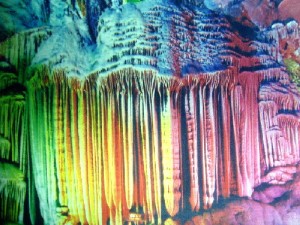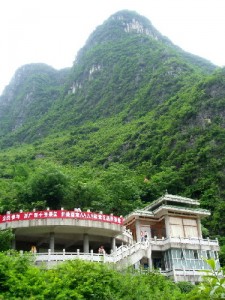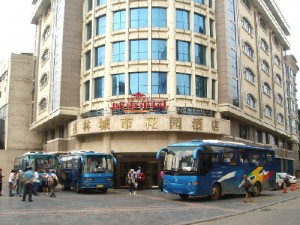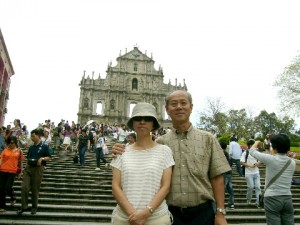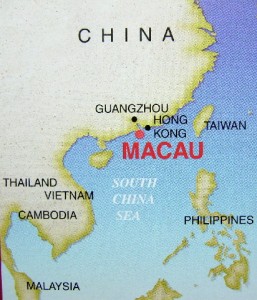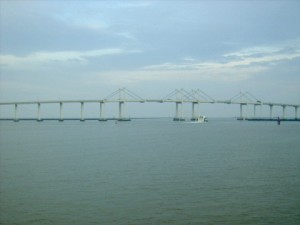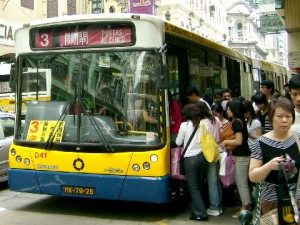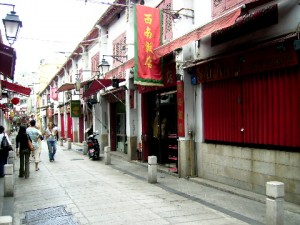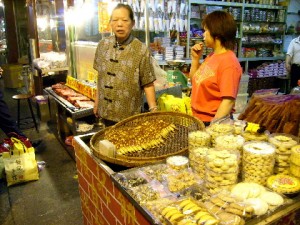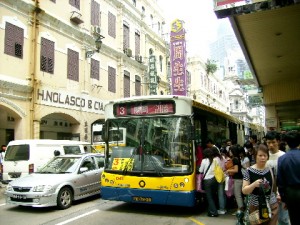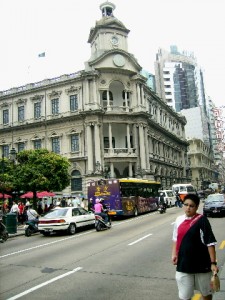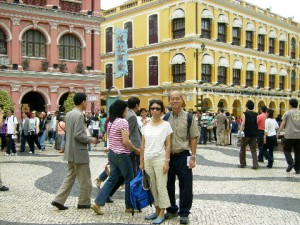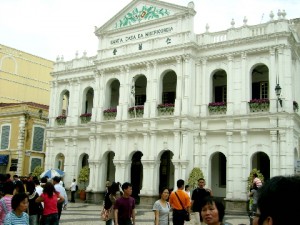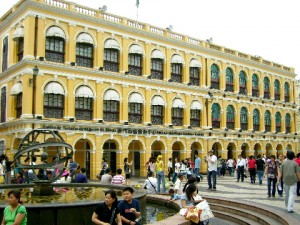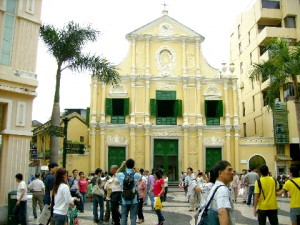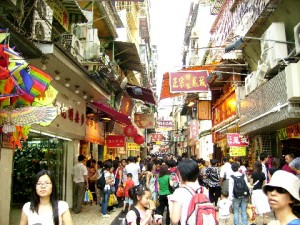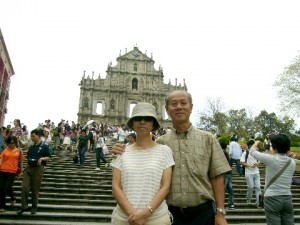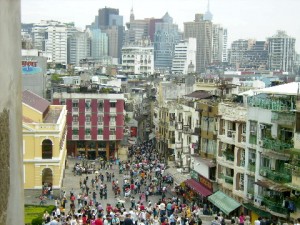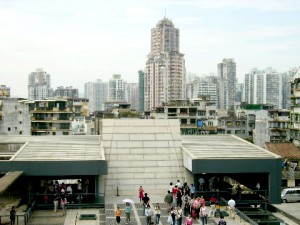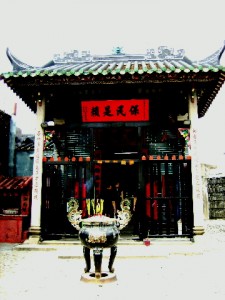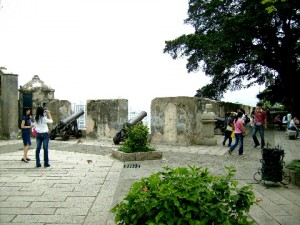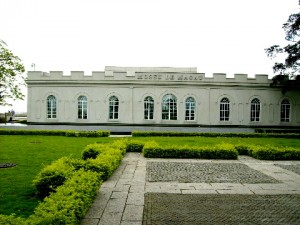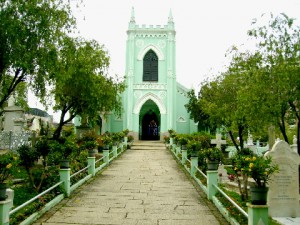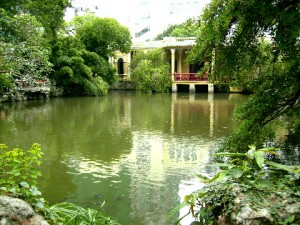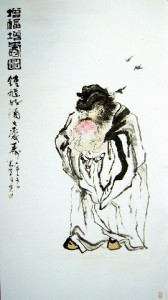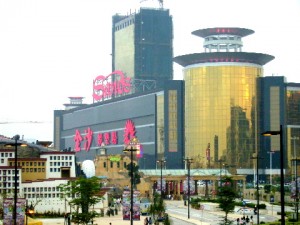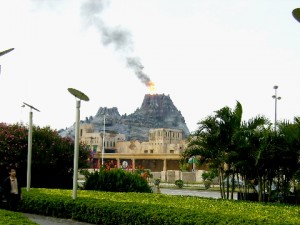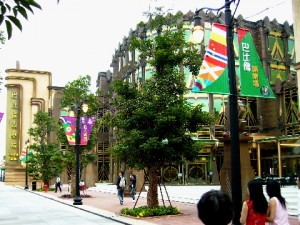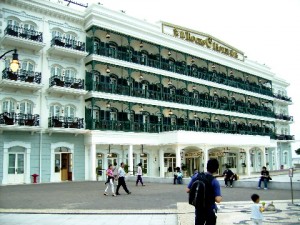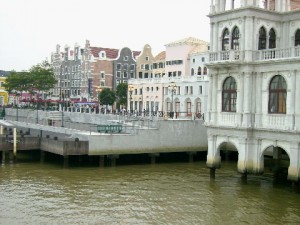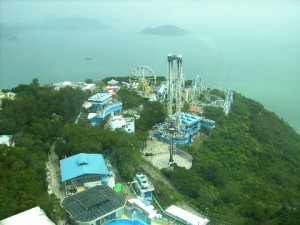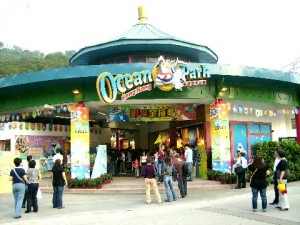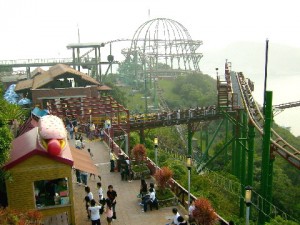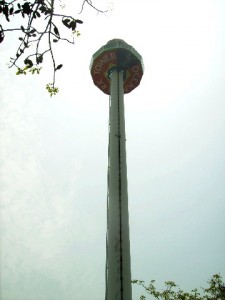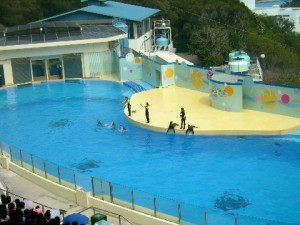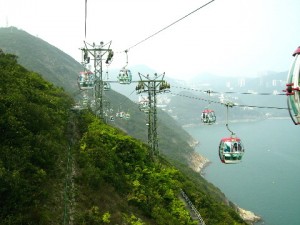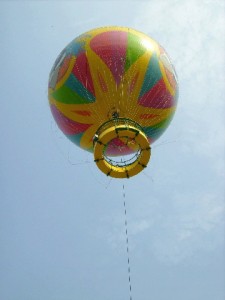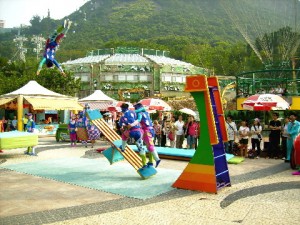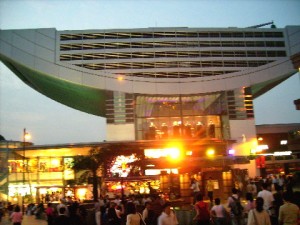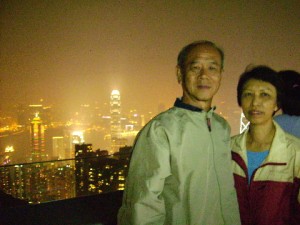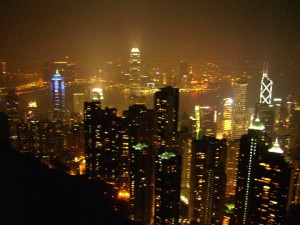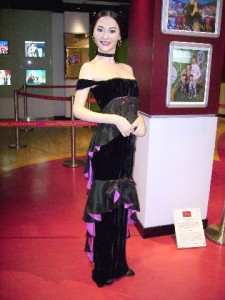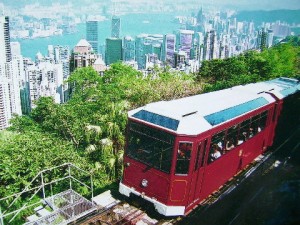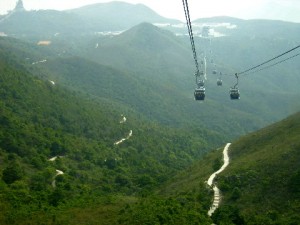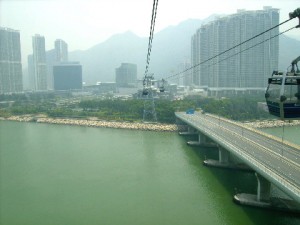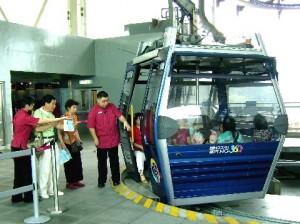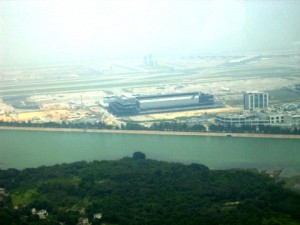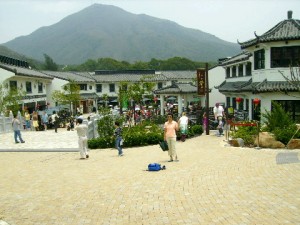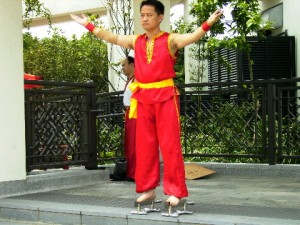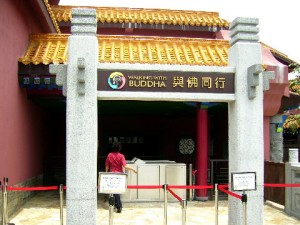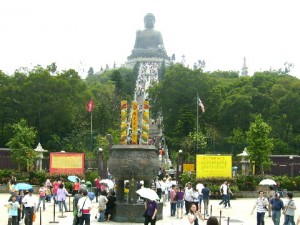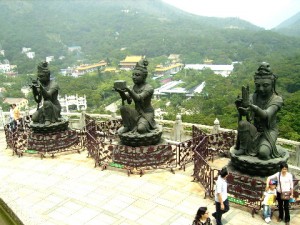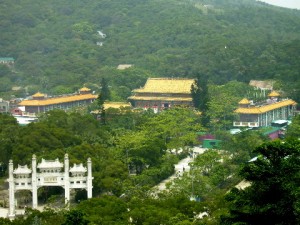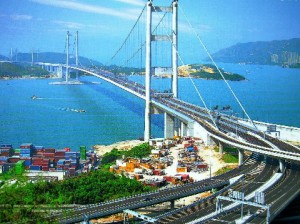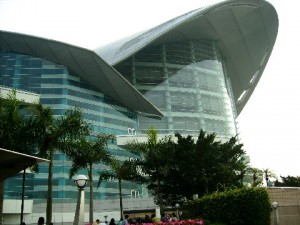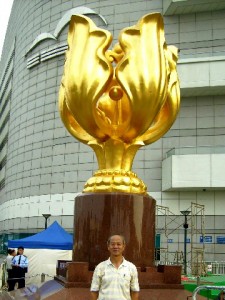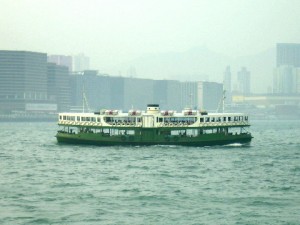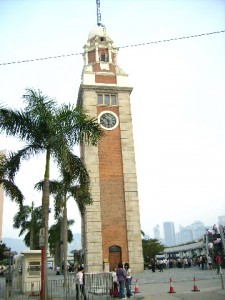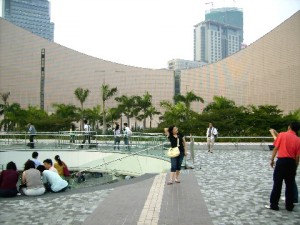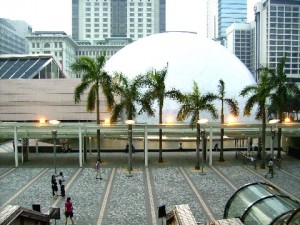Bangkok, Ayuthaya Travel (Part I)
Filed under: Ayuthaya Travel (Part I), Bangkok, Uncategorized
Bangkok began as a small village and later a trading centre. It developed rapidly when King Thaksin made it the new capital of Thailand in 1767. The old one, Ayutthaya, which is 80 km north of Bangkok, was captured by the Burmese soldiers in 1767.
People and Attractions
Bangkok has now become a fast growing city in Asia with a population of over 10 millions. Although it has become a financial and commercial hub of Thailand with modern, tall buildings, it still preserves the old ones which have historical, religious and cultural significance.
Known as the “City of Angels”, it attracts over 10 million tourists annually. It is well-known for Buddhist temples with unique architectural designs, food, shopping centres, night bazaars, roadside stalls, entertainment, historical and cultural sites.
Over 90% of its people of diverse races have a common religion, Buddhism and culture. There are about 400 Buddhist temples, 55 mosques, 10 churches and 2 Hindu temples in the city. As it has so many temples, it should also be known as the “City of Temples”. The Thais are helpful and friendly, and they live up to the country’s motto: “Land of Smiles”.
“Venice of the East”
Located on the east bank of River Chao Phraya in a low delta area with many rivers and canals (khlongs), Bangkok is known as “Venice of the East”. In olden days, canals or khlongs were built mainly for irrigating paddy fields and water transport. Many houses, shops and markets were built along those that were used as waterways. Some of them had floating markets. But nowadays many have been filled up to make way for roads.
Sinking Bangkok
Traffic jams and air-pollution are two major problems in the city now. Hopefully, the Thai government will find quick solutions to these problems, otherwise tourism will be affected badly. It is reported that the vibrant city is sinking and some parts of its land may be under water in 20 years’ time.
Bangkok and Ayuthaya, Writer’s Next Destinations
After an interesting trip to Chiang Mai, Chiang Rai and the Golden Triangle in Thailand in July 2006, my wife and I were off again to two more cities in Thailand in December 2007, i.e. Bangkok and Ayuthaya
On 4 December 2007, we left Kuala Lumpur Airport by an Air Asia airbus plane, A320 and, two hours later, we arrived safely at Bangkok’s new airport, Suvarnabhumi Airport, which was one year-old then. Built 28 km south-east of Bangkok, it is an airport which is comparable to other large international airports in the world. Its large, massive steel-roof looks like a row of curved and oval-shaped parachutes from a distance.
As a railway linking the airport and the Makkasan Station in the downtown was not ready yet, we took a taxi and in less than an hour to reach our budget hotel known as Bangkok City Inn in the downtown.
Below is the itinerary of our unforgettable Bangkok and Ayutthaya tour from 4 December 2007 till 7 December 2007.
1. Ratchadamri Nightlife and Central World
2. Ayutthaya : Bang Pa-In Palace
3. Ayutthaya : Wat Mahathat, Wat Phra Si Sanpet, Wihan Phra Mongkhon Bophit
4. Chao Phraya River Boat Cruise
5. Suan Lum Night Bazaar
6. The Grand Palace, The Emerald Buddha Temple, Temple of the Reclining Buddha, Wat Intrawihan
7. Anantasamakhon Throne Hall, King Rama V Monument, Democracy Monument, Victory Monument
8. Silom, Patpong and Chinatown
9. Thai Body Massage, Floating Market, Khlong Saen Saep and Phetburi Road
10. Bangkok City Inn, Vishnu Kurmavatara and Departure for Malaysia
Day 1 : Tuesday, 4 December 2007
Ratchadamri Road Nightlife
After checking in at Bangkok City Inn in Bangkok City we left the hotel in the evening and went to look for roadside food-stalls nearby to savour the cheap but nutritious Thai food for dinner. We found a row of them along Soi Rajadamri 2 which was nearby and tried their spicy, sweet and sour “tom yam”, fried rice, grilled chicken as well as fresh coconut drinks to cool our body system. Later, we found out that almost every street in the downtown had cheap roadside food-stalls.
Having finished our sumptuous meal we started our city sightseeing tour in Bangkok. The first place we visited was the busy Ratchadamri Road. The traffic was heavy on the road. As it was already evening, we saw lots of small stalls along both sides of the road selling all kinds of goods. They attracted a large number of both tourists and local people. The walkway was made narrow by the stalls and was so crowded that we had to be careful all the time not to bump into other people.
Central World
Then we walked to Bangkok’s largest shopping mall which is known as Central World. Located at the junction of Phloenchit Road and Ratchadamri Road, the modern multi-storey building houses many shops selling branded goods, such as watches, electrical and electronic products, jewellery, silverware, clothes, shoes, perfumes, cosmetics, etc. Besides, it has 21 cinema screens, 18 karaoke rooms and 28 bowling lanes. It is a place worth patronizing if you have lots of money.
Outside the Central World, we saw hundreds of people chill-out at two open-air bistros which had bands playing loud musics and local singers singing English and Thai songs. Adjacent to the bistros was an open space where there were many decorations including a tall Christmas tree lit with hundreds of small coloured bulbs that gave an atmosphere of Christmas festivity. This area was a popular place for families and young couples.
Day 2 : Wednesday, 5 December 2007
Travel to Ayutthaya
On the morning of 5 December 2007, we joined a group of tourists from different parts of the world for a tour in the ancient Ayutthaya to learn about its interesting past history, heritage and culture. At about 8.30 a.m. we departed Bangkok by a coach and headed north to the city.
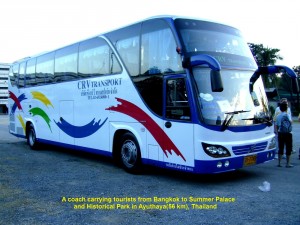
A coach bringing visitors from Bangkok City to the Summer Palace and Ancient Royal Palace in Ayuthaya, Thailand
Ayutthaya
Ayutthaya, located 86 km north of Bangkok, was founded in 1350. Since then it had been the capital of the Siamese Kingdom for 417 years before it was beseiged by the Burmese in 1767.
After the Burmese attack many buildings especially the temples were left in ruins and not much work has been done to restore them.
Ayutthaya has been declared as a World Heritage Ancient City as the ruined sites are a testament to its rich history and culture in its heyday.
Arrival at Summer Palace(Pang Pa-In Palace)
After travelling for about an hour we arrived at a famous ancient royal palace known as Bang Pa-In Palace or Royal Summer Palace which is 30 km south of Ayutthaya.
Before entering the palace a large portrait of the present Thai king greeted us. When we were inside the palace complex we were amazed to see a beautiful landscape of large manicured garden, neat rows of trees and flowers, lakes and mansions of European and Asian architectural styles.
Summer Palace (Pang Pa-In Palace)
In 1632 King Prasat Thong (1629-1659) was the first Thai king to build a palace as his residence there. Later, it was abandoned until King Mongkut or King Rama IV (1851-1868) restored it and made it as his residence. Subsequently, more mansions were built at the site by other kings. Many existing buildings were constructed during the reign of King Chulalongkorn or King Rama V (1868-1919) who loved European architectural styles.
The present king, King Bhumibol Adulyadej or King Rama IX, who lives at Chitralada Palace in Bangkok, occasionally, lives there and holds receptions and banquets.
After studying a pictorial map showing the locations of the mansions we toured the palace. Our Thai tour guide, Chamrong, who preferred to be called “James Bond” led us to the important mansions and patiently told us their histories. We toured the palace complex for an hour and found some buildings fascinating and worth mentioning below.
There are two parts of the Summer Palace: the outer and the inner.
1. The buildings in the outer part of the palace include:
a. Golden Palace of the God King Shrine (Ho Hem Monthian Thewarat)
Standing under a large old Bodhi tree is a small stone structure in the form of a Khmer-styled shrine. It was built by King Rama V in 1880 and dedicated to King Prasat Thong.
b. Assembly Hall for Ronal Relatives (Saphakhan Rajaprayon)
A royal residence built in 1879 for King Rama V’s brothers
c. The Divine Seat of Personal Freedom (Phra Thinang Aisawan Thiphya-Art)
This beautiful, brightly-coloured Thai architectural styled pavilion with 4 porches and a spire roof was built in a pond by King Rama V in 1876. It houses a bronze statue of King Rama V in a Field Marshal uniform that was placed there by his son, King Rama VI.
d. Excellent and Shinning Heavenly Abode (Phra Thinang Warophat Phiman)
A royal residence built in a neo-classic architectural style by King Rama V in 1876 as his residence and throne hall. Oil paintings depicting important events in Thai history and scenes from Thai literature can be seen in the audience chambers and ante-rooms.
e. Statues and Tree Sculptures in Summer Palace Garden
In the Summer Palace Garden there are several statues of ancient Greek figures and tree sculptures in animal figures. There is a bridge with some white marble statues of Greek figures and some in the garden. Besides, trees have been shaped into animal figures, like elephants and rabbits.
2. The buildings in the inner part of the Palace include:
a. Garden of the Secured Land (Phra Thinang Uthaya Phumisathian)
This is a large royal residence built at the expressed wishes of the present queen, Queen Sirikit. In 2006 Queen Elizabeth II of England was invited to stay there by the Thai king. She went to Thailand to celebrate his 60th. anniversary reign. This mansion replaces the wooden one which was accidentally burnt down during repair in 1938
b. The Sages Lookout Tower (Ho Withun Thasana)
This is a tall observatory tower built by King Rama V in 1881 for viewing the scenery of the countryside.
c. Royal Residence of Heavenly Light (Phra Thinang Wehart Chamrun)
It is a large two-storey Chinese-styled mansion given by a group of local Chinese businessmen as a gift to King Rama V in 1889
A Russian prince who visited the mansion in 1889 aptly described the striking red and yellow building as follows:
“It is really a palace of romance, with ornamented tiled floors, massive ebony furniture, gold, silver, and porcelain freely used for decorative purposes, and delicate fretwork on the columns and on the windows.”
There is a Chinese-styled throne on the ground floor. Besides, the building has an altar enshrining the plates with the names of King Rama IV, King Rama V and their respective queens. This mansion was a favourite residence of King Rama VI (1910-1925).
Journey to Ayuthaya
After a tour of the splendid Summer Palace we continued our journey to Ayuthaya which is well-known for ruined ancient temples
Ayutthaya was an important religious centre until the Burmese captured it in 1767. Many temples were burnt down by the enemies. Some large ruined ancient temples can still be seen in the city and are now a tourist attraction.
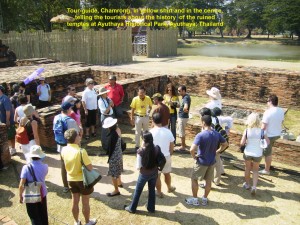
Chamrong, the tour-guide, telling the tourists about the ruined temples at the Ayuthaya Historical Park
On arrival at Ayuthaya, we visited some of the famous places of worship including the following:
a. Wat Mahathat
This ruined temple was built during the reign of King Boram Rachathirat in 1374 and completed during the reign of King Ramesuan (1388-1395) in 1390 to house the Lord Buddha’s relics. It was also used for the royal religious ceremonies as well as a place of worship by the locals and visitors.
During the Burmese attack in 1767 it was burnt down. Since then it was left in ruins. In the centre of the temple there was a large corn cob-shaped pagoda or prang (built in a Khmer-styled tower) that contained the Buddha’s relics. It collapsed in the reign of King Songtham (1610-1628). During the reign of King Prasat Thong (1630-1655), its restoration was completed and its height was greatly increased to 50 metres . Later the pagoda collapsed again due to an earthquake that happened during the reign of King Rama VI. The collapsed pagoda can still be seen at the temple.
Surrounding the pagoda are large and small stupas or chedis as well as large and small statues of Buddha. Many of these statues are either headless or torsoless. According to our tour Thai guide, Chamrong, looters had decapitated the statues and sold the heads to antique collectors. Besides, many relics of Buddha and other artifacts were stolen from the temple. Even the bricks were not spared. But visitors can still see some of the valuable temple artifacts recovered by archaeologists at the Chao Sam Phraya National Museum in Ayutthaya, e.g. Buddha statues, votive tablets, fish-shaped boxes and golden plaques in the shape of animals.
At the temple we were fascinated by a stone head of Lord Buddha image which appears out of the exposed roots of an old, large Bodhi tree. It is believed that the rest of its body is buried in the roots. A guard standing a few metres away from the head advised us not to let our heads be above that sacred head if we wanted to go near it to have a closer look.
Then we left that temple and went to another one nearby. It was Wat Phra Si Sanpet.
b. Wat Phra Si Sanpet
This temple was built in the large compound of a royal palace in 1448 without a monastery. It was used for royal ceremonies and religious rites. Besides, its compound was used for cremating the bodies of kings and royal family members.
Three large pagodas (stupas) were built to house the remains of the Siamese kings ( King Boroma-Tri-Loka-Nat, King Boroma-Rachathirat III and King
Ramathibodi II) and smaller ones the remains of the royal members.
Adjacent to this temple was a grand hall (Wihan Luang). It housed a tall golden Buddha statue (16 metres tall) known as Phra Si Sanpet. The statue covered with a layer of about 172 kg of gold was built by King Rama Thibodi II in 1500.
Unfortunately, in 1767 the Burmese came and burnt down the hall as well as the temple nearby. They also removed the gold from the large Buddha statue. A few tall pillars are the only remains of the grand hall that a visitor can see now. The large Buddha statue has been moved to the Phra Si Sanpet chedi in Wat Phra Cetuphon (Wat Po) in Bangkok.
c. Wihan Phra Mongkhon Bophit
This temple located in the old royal palace compound houses a large statue of Buddha known as Phra Mongkhon Bophit (12.45 metres high) and the latter is covered with gold leaves. This statue was made in 1538 on the order of King Chairachathirat.
Besides foreign tourists who thronged that ancient royal palace, lots of local people also visited the place as it was a public holiday in celebration of their king’s 80th. birthday.
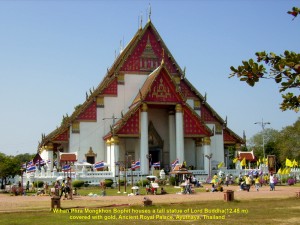
Wihan Phra Mongkhon Bophit houses a large golden statue of Lord Buddha at Ancient Royal Palace, Ayuthaya, Thailand
Elephant Show and Elephant Ride
Nearby, there was a mini elephant show and many people both foreign and locals alike were enjoying riding elephants. There were some who bought bananas and sugarcane to feed some hungry elephants in a large tent. The whole place looked like a carnival then.
Chao Phraya River Boat Cruise
After a tour of Ayutthaya’s two ancient ruined temples, viz. Wat Mahathat and Wat Phra Si Sanpet, and a grand hall, Wihan Phra Si Sanpet, we travelled south in our coach to Wat Chong-lom Pier in Nonthaburi. On arrival, we boarded a luxurious cruise boat of about 50 metres in length belonging to Grand Pearl Company Limited at Bangkok. It would take us down the large River Chao Phraya for a river-sighthseeing cruise.
Before the boat started, I was standing on the pier and busy snapping photos of the river sceneries. Then a boy appeared in front of me proudly showing off a large fish. I understood what he wanted me to do. So I snapped a photo of him with the fish and he grinned. Then his father holding a fishing rod came and teased him.
Soon the boat left the pier. As it was cruising slowly down the river, we enjoyed the sights and sounds of the river. We saw boats of different shapes and sizes past by, water hyacinth plants floating down the river, villages and towns on both sides of the river and anglers standing on river banks hoping for a big catch. Occasionally, large fish were seen jumping out of the water.
As we were getting nearer to Bangkok City, we saw lots of landmarks, historical and modern and went under a few old and modern bridges.
When we reached Bangkok we saw a spectacular sight of the city. It is a city of tall buildings of different heights, shapes and sizes. They are hotels, government buildings, shopping centres and condominiums. Many brightly-painted Siamese temples, a few churches and the famous Grand Palace can be seen too. Besides, the river is bustling with boats that ferry passengers across the river and carry tourists for a river-sightseeing tour.
After over two hours of the enjoyable river boat cruise we finally arrived at the River City Shopping Complex Pier and went back straight to our hotel to rest.
A Walk to Suan Lum Night Bazaar
In the evening, my wife and I decided to visit Suan Lum Night Bazaar. The bazaar is near the crossroads of Witthayu (Wireless) Road and Rama IV Road. Looking at the city map we thought it was not far from our hotel. So we decided to walk there. On the way, we came across a few groups of loyal hotel staff with burning candles standing in front of their hotels and waiting to celebrate their king’s 80th. birthday. After walking for half an hour we were surprised that we had not reached the bazaar yet. We realized the map we used was not drawn to scale. It took us another 15 minutes of walking before reaching our destination.
It was a sight of relief when we arrived at Suan Lum Night Bazaar. Feeling tired and famished, we made a beeline to the Thai food court, ordered some food and gobbled down all of it quickly. Then we took our time to browse a few hundreds of stalls.
Suan Lum Night Bazaar
This night bazaar which opens from 3 p.m. till midnight daily is a place where hundreds of stalls sell a wide variety of Thai products ranging from accessories, shoes and clothes to antiques, souvenirs, watches, arts and handicrafts. Besides, a traditional Thai puppet theatre, pet stalls, restaurants, pubs, food court, foot massage rooms and many more are found here. In other words, this night bazaar offers practically anything a visitor wants.
At a stall we were surprised to see aluminium cans made into objects for sale, like alarm clocks and “tuk-tuks”. Thais are truly creative and enterprising people.
After buying some articles at bargain prices and window shopping at the bazaar, we decided to go back to our hotel by a “tuk-tuk” (a three wheeled vehicle which runs on liquefied petroleum gas or LPG) instead of walking back.
Continue in Ayuthaya Travel (Part II)
Bangkok , Ayuthaya Travel (Part II)
Filed under: Ayuthaya Travel (Part II), Bangkok, Uncategorized
[continued from Bangkok , Ayuthaya Travel (Part I)]
Bangkok , Ayuthaya Travel (Part II)
Day 3 : Thursday, 6 December 2007
On the morning of 6 December 2007, we hired a “tuk-tuk” to bring my wife and I around the city for sightseeing. A young Thai man named See was our “tuk-tuk” driver and our tour-guide too.
The first place he brought us was the famous Grand Palace. When we arrived there we felt extremely disappointed to be informed that the palace, a Thai’s icon, was closed to public then. It was going to hold the Thai King’s 80th. birthday celebration. The palace is truly a grand and stunning one. Below is the description of it:
The Grand Palace
Located on the eastern bank of River Chao Phraya in the Rattanakosin District, this beautiful palace in a large area of over 200 000 sq. metres is surrounded by a high and unfriendly-looking white wall.
The Grand Palace was built in 1782 during the reign of King Rama I (1737-1802) who used it as his royal residence. Subsequently, other Thai kings lived there too from the 18th. century till the middle of the 20th. century.
The last king to live there was King Rama VIII or King Ananda Sun Mahidol(1925-1946). The present king, King Bhumibol Adulyadej (King Rama IX), who succeeded him (his brother) does not live there. Instead, he lives at another place not far from the old one and is known as Chitralada Palace.
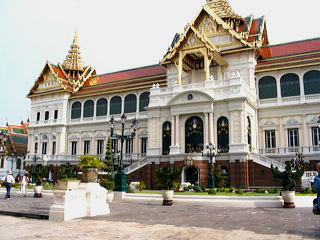
The Grand Palace, Bangkok
The Grand Palace is now used for religious, state and royal ceremonies. It has several buildings built in unique Siamese architectural style.
The Emerald Buddha Temple (Wat Phra Kaew)
In the compound of the Grand Palace is Thailand’s grandest and most sacred Buddhist temple known as Wat Phra Kaew. Built in 1785, it houses a Buddha statue known as Emerald Buddha Statue. There are other statues, such as monkey kings and giants resembling the characters in the Ramayana mythology, around the golden temple. Besides, artworks from art masters during the Rattanakosin era are displayed here.
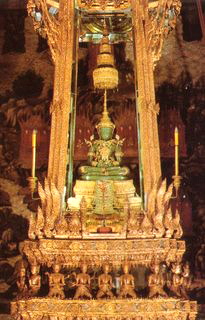
The Emerald Statue of Buddha, Bangkok
As we could not visit the Grand Palace and Wat Phra Kaew we visited a famous temple known as Wat Pho or Wat Phra Chetuphon nearby.
Wat Pho or Wat Phra Chetuphon (Temple of the Reclining Buddha)
Wat Pho houses a large reclining Buddha statue of 46 metres long. The walls inside the temple are beautifully painted with colourful pictures depicting the Buddhist way of life of the Thai people.
This temple has a monastery for the monks. Besides, it is the birthplace of the traditional Thai massage school. Around this temple are several beautiful stupas and large statues of guards with serious looks at some entrances of the temple.
Having completed the tour of this temple, we headed north-east to another famous temple, Wat Intrawihan
Wat Intrawihan
Located at 114, Wisutkasat Road in Phra Nakhon District, Wat Intrwihan was built towards the end of the Ayutthaya Period. Standing tall in the compound is a large golden statue of Buddha. It was built in the reign of King Rama IV in 1867 and completed in the reign of King Rama VII. It claims to be the world’s tallest standing Buddha statue and is known as Phra Si Ariyamettraiya or Luangpor Toh.
While we were at the temple we were shocked to see many cats and dogs roaming
freely in the compound and their excreta was all over the place. As we walked around the temple we were careful not to step on it.

Wat Intrawihan
Anantasamakhon Throne Hall
Located in the Dusit District is a majestic building of marble built in the Italian Renaissance style. It was constructed during the reign of King Rama V and completed in the reign of King Rama VI.
It receives foreign dignitaries and holds the Royal Advisory Council meetings. It was once used for parliamentary meetings.
In 2006, royal personages from 25 countries celebrated King Bhumibol Adulyadej’s 60th. anniversary of monarchy reign at this building. He is the world’s longest reigning king.
King Rama V Monument
In front of Anantasamakhon Throne Hall is a large open space known as Royal Plaza. In the centre there is a monument of an equestrian statue of King Rama V (King Chulalongkorn) in a field marshal uniform. The Thai people loved him so much that they raised fund to get the statue cast by a French sculptor in Paris and placed it there in 1908 when he was still alive.
King Rama V (1853-1910) succeeded his father in 1868. He had travelled to many foreign countries in Asia and Europe and learned about their reforms and governments. With that knowledge he modernized his government. Besides, he abolished slavery in his country. In 1896 he built the first railroad in Thailand connecting Bangkok and Ayutthaya. His subjects called him “The Great Beloved King”.
During his reign he had four queen consorts and some royal common wives. He was the only Thai king who had the most number of children, about 77. His second son, Vajiravudh (1881-1925), succeeded him as the sixth king (King Rama VI) of the Chakri Dynasty in 1910.
Not far from the monument, we saw a colourful arch with a large royal emblem at its top at the crossroads of Ratchadamnoen Nok Road and Si Ayutthaya Road. It was erected to celebrate the Thai king’s 80th. birthday. We also saw four horsemen, police and many people lining the roads from Chitralada Palace to the Grand Palace. They were wearing yellow T-shirts and holding national flags and yellow royal flags waiting to cheer their king. The king who would pass them while he was on his way to the Grand Palace to celebrate his 80th. birthday.
{To the Thais, yellow symbolizes devotion to their beloved king. On the evening of the previous day (5 December 2007), the king’s birthday was celebrated nationwide with festivities and prayers, and thousands of people packed the streets near the Grand Palace to watch a spectacular firework display.}
Democracy Monument
Located on a large roundabout where Ratchadamnoen Klang Road, Prachathipatai Road and Bandinsor Road meet, is the Democracy Monument. It was erected in 1939 to commemorate the June 1932 military coup which resulted in the establishment of the constitutional monarchy.
In the centre of the monument is a turret which has two golden offering bowls on its top. The “1932 Constitution” is on the top bowl. There are four wing-like structures standing round the turret. They represent the army, navy, air force and police guarding the Constitution.
Victory Monument
There is another monument not far from the Democracy Monument. It is known as the Victory Monument which was erected in 1941 on Bangkok’s largest roundabout where Phahon Yothin Highway, Phaya Thai Road, Ratchawithi Road and Din Daeng Road converge. This monument commemorated the Thai victory in a brief, bloodless war with the French colonialists in Indo-China. The victory led to Thailand annexing some territories in western Cambodia, and northern and southern Laos. Some of these territories were formerly Thailand’s and ceded to France in 1883 and 1904.
The monument has 5 human statues standing round a tall obelisk. The statues symbolically represent the army, navy, air force, police and civilians.
Mahboonkrong Centre(MBK Centre)
After the interesting Bangkok City tour, we went to a popular shopping centre known Mahboonkrong Centre(MBK Centre) which is near BTS Central Station (Siam).
There are a few more shopping centres near it, e.g. Siam Centre, Siam Discovery Centre and Siam Paragon. Later, we went back to our hotel to have a rest.
Silom Road
In the evening, my wife and I went to Silom Road by “tuk-tuk” again as it could manoeuvre easily in a traffic jam and reach any place quickly.
Silom Road is in the heart of the Central Business District of Bangkok. Multi-storey buildings line the road. They house banks, trading companies, insurance companies, finance companies, law firms, shopping centres, luxurious hotels, etc.
The road is full of traffic and the walkways are always crowded during day and night. This place is easily accessible by either Rama 6 Road (an expressway), Rama 4 Road or the Skytrain.
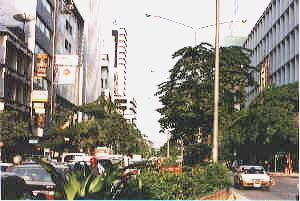
Silom Road during the day
When night falls roadside food stalls and other stalls appear and attract influxes of visitors both locals and tourists. Most of the tourists would head for the red light district of Patpong which is very near to the Sala Daeng Skytrain Station.
Patpong
Patpong has two short roads, Patpong 1 Road and Patpong 2 Road, which are parallel to each other and sandwiched in between Silom Road and Surawong Road.
Patpong belongs to the Patpongpanich family. It is estimated to be worth over US $100 millions! When the family bought it in 1946 they built a road, Patpong Road, and shophouses for rent along the road.
A Red Light District
Later in 1968 the whole area was transformed into a red light district catering mainly for the U.S. soldiers who needed recreation and recuperation (R & R) after their duties in Vietnam during the Vietnam War (1965-1975). Its notoriety spread far and wide by word of mouth in the 1970s and 1980s. In fact, the place has been featured in many western movies such as Deer Hunter (1978) and Miss Saigon(1989). Besides, many authors have written about it in their novels.
Since the Vietnam War was over in 1975 the place has become a tourist attraction and many foreign tourists as well as Thais like to patronize the bars there.
Night Market
In the 1980s, the enterprising Patpongpanich family set up stalls for rent in the middle of Patpong 1 Road. These stalls are now a busy night market selling goods ranging from souvenirs, caps, T-shirts and shoes to jewellery and watches. Their presence has affected the night entertainment business of the bars there.
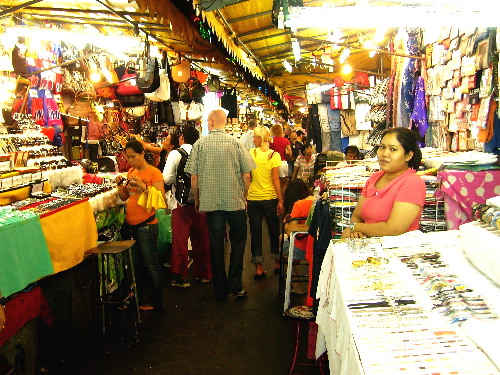
Night market in the Patpong Red Light District
Hard Bargain
From Silom Road, my wife and I walked to Patpong 1 Road. There were many stalls on the latter road which was closed to traffic. Stopping at one of them, my wife thought of buying a child’s frock for our grand-daughter. She was shocked when she was told by the seller that it cost 850 baht! After a few minutes of bargaining she was finally offered 200 baht. Tourists should make a hard bargain there if they want to buy something, otherwise they may be fleeced by unscrupulous sellers.Then we decided to see the bars along Patpong Road. As we were walking past a few of them and trying to get a glimpse of some activities inside, some touts were inviting us in for a sleazy show. As we had no intention of watching it we did not heed them but kept on walking. I remember what our Ayutthaya tour guide had told us about these Patpong bars. He said, “If you go inside with a lot of money, you will come out without a cent!”
Chinatown (Yao Wa Rat)
Having seen the Patpong area, we left for Chinatown that is not far from Patpong. It is a place where shops sell all kinds of products which are mostly Chinese and Thai, such as herbs, jewellery, clothes, watches, handbags, electrical and electronic gadgets, etc.
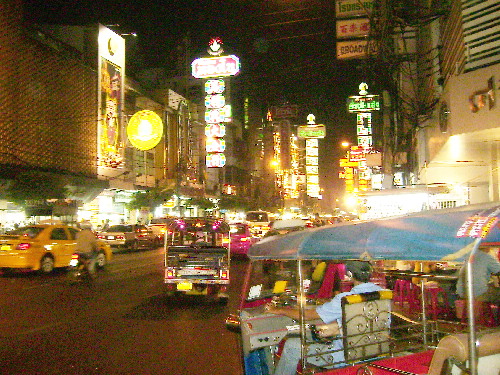
Chinatown at night, Bangkok
Sea Food
When night falls, roadside stalls in Chinatown suddenly appear and do brisk businesses, especially those that cater to food lovers like us. When we were there we looked for a sea food restaurant. We found one which was selling crabs, prawns, squids, snails, fish and cockles. The cooks could grill, steam and fry them for customers. Although they were not cheap we asked for a large crab and told a waitress to get it grilled over red hot charcoal. We tried other dishes too. We finished the delicious meal with some fleshy Siamese durians and a refreshing fresh coconut drink . Then we left Chinatown for our hotel.
Day 4: Friday, 7 December 2007
Thai Body Massage
On the morning of our last day in Bangkok, we went for a Thai body massage at a shop, Mr. Feet, which is a few doors away from our hotel, Bangkok City Inn. While we were fully clothed, our young masseuses expertly massaged our limbs and the back of our bodies. Occasionally, we felt a little pain in some parts of our bodies when strong pressure was applied. After having been massaged for an hour we felt relaxed and energized. All our muscular and joint pain due to walking too much during our last three days in Bangkok and Ayutthaya miraculously disappeared. Before we left the shop I saw a floating market in one of the large pictures printed by the Thai Tourism Board on a wall. We regretted to give it a miss as we had to depart for Malaysia in the evening.
Floating Market
In the early days, there were many floating markets in rivers and man-made canals or khlongs which were lined with dwelling-houses in Thailand. Later, when supermarkets were opened and people found it more convenient to shop at these places. Consequently, the number of floating markets dwindled a lot. Nowadays, there are few floating markets left in Thailand and they attract many tourists.
At a floating market, ladies in straw hats row about their small boats laden with fruits, vegetables, food, flowers, groceries, etc. looking for customers who usually live along the waterways. A busy floating market is a fascinating sight as you can see it in the photo on the left.
The largest floating market in Thailand is at Ratchaburi which is 101 km west of Bangkok. Small floating markets can be found in Bangkok, e.g. Tailing Chan and Wat Sai floating markets.
After a Thai body massage, we decided to walk to Phetburi Road nearby. While crossing a bridge over a large canal or khlong known as Khlong Saen Saep, we saw boats plying on the waterway.
Khlong Saen Saep
Khlong Saen Saep is a long canal connecting Khlong Phadung Krungkasem which flows into River Chao Phraya in the west to Prachinburi and Chachoengsao in the east. Today, it is a busy waterway which has 30 stops for over 100 passenger boats.
Originally, the canal was built to transport soldiers and weapons to Cambodia which was in conflict with Thailand during the reign of King Rama III.
After crossing the bridge we came to a long road, Phetburi Road.
Phetburi Road
Phetburi Road is a busy road lined with large buildings. It has a lot of traffic during day and night. Lots of stalls selling cheap food and snacks can be found on the roadside and five-foot ways in the morning. It is indeed a bustling place. Photos below show different types of stalls along the road.
From the Phetburi Road three tall building could be seen in the distance. One of them which was 88 storeys high, Baiyoke Sky Hotel, was the tallest in Bangkok.
Thailand General Election
While we were in Bangkok, the Thai people were gripped with a general election fever. The previous government of Prime Minister, Thaksin Shinawatra, was toppled by a military coup in 2006.
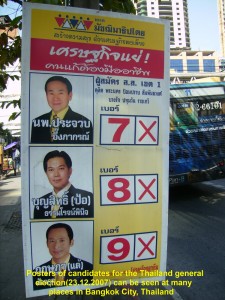
Posters of candidates for the Thailand general election 2007 can be seen at many places in Bangkok City
Posters of candidates standing for the coming Thailand general election on 23 December 2007 could be seen along major roads in the city. The photo on the right showing three candidates was taken along Phetburi Road. Besides, large portraits of the Thai king were put up in front of large buildings like hotels and government buildings in celebration of the king’s 80th. birthday.
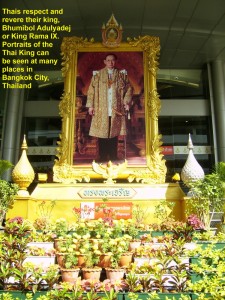
Thai King’s portraits can be seen at many places in Bangkok City, Thailand. The king is respected and revered by Thais.
While walking along Phetburi Road we were surprised to see lots of electric cables and telephone wires hanging untidily high above the road. It was undoubtedly an unpleasant sight.
Later we walked back to the budget hotel, Bangkok City Inn, claimed our luggage and took a taxi to the airport at 2.00 p.m. to check-in earlier before we departed for Malaysia at 6.00 p.m.
Bangkok City Inn
Located in Bangkok downtown, Bangkok City Inn is surrounded by many shopping centres which are within walking distance, including Central World, Zen, Big C, Siam Paragon, Siam Discovery, Siam Square, Siam Centre, MBK Centre, Gaysorn Plaza, Peninsula Plaza, Pratunam Complex and Amarin Plaza. In addition, bustling markets
and entertainment establishments are also nearby. The area is easily accessible by the Skytrain and some main roads. Taxis, tuk-tuks and buses are easily available here day and night.
We had stayed at Bangkok City Inn for three days and concluded that it is worth staying there. The rooms are clean and the bathrooms are large. The accommodation is inexpensive and free breakfast is provided daily in the clean and comfortable dining room. Its staff are helpful, friendly, and always smiling. They have made our stay a memorable one.
Check-In at Suvarnabhumi Airport
After checking-in at the airport we walked a long way to a place to wait for our plane. On the way, we came across a model of a royal Thai throne. Opposite the throne is a sculpture of a long serpent with a few heads, known as Vasuki, the “King of Serpents”. It is being pulled by several demigods and demons. There is a statue
of Vishnu Kurmavatara with four hands standing on a “mountain”. The “mountain” with the serpent round it is carried on a “tortoise’s” back. It is a beautiful sculpture.
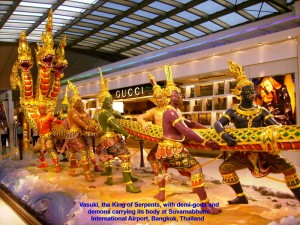
Sculpture of King of Serpents, demigods and demons at Suvarnabhumi International Airport, Bangkok, Thailand
Vishnu Kurmavatara
According to a legend about Vishnu Kurmavatara written on a board placed in front of the sculpture, I quote:
“This scene depicts Vishnu Kurmavatara and the churning of the Milk Ocean. The naga, Vasuki, (the King of Serpents) curled around the mountain, Mandara. Vishnu, incarnated in the form of a great turtle, supports the mountain on his back. Devas (demigods) and Asuras (demons) pull the naga’s body to churn the water of the ocean for thousands of years in order to produce the nectar of immortality, Amrita. From the churning, numerous opulent items are produced, including Dhanvantari carrying the pot of Amrita. In the end, the cooperation between Devas and Asuras is shattered. The Devas fulfill their plan of acquiring all Amrita and disperse the Asuras out of Heaven to the Underworld.”
Departure for Malaysia
Our air flight back to Malaysia was supposed to be at 6 p.m. but we departed Suvarnabhumi Airport at 7 p.m. On the way to Malaysia, my wife and I agreed that our three days’ stay in Bangkok was too short as we had missed many places of interest there. Anyway, we are now planning to visit another foreign place soon.
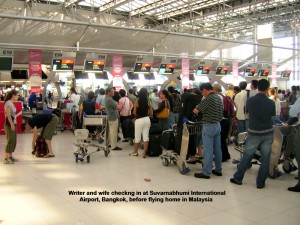
Writer and wife checking in at Suvarnabhumi International Airport before departure for home in Malaysia
Thank you for reading this travelogue and hope the information is useful to you.
Written by: Choo Chaw, Kluang, Johor, Malaysia
Chiangmai, Chiang Rai, The Golden Triangle Travel (Part I)
Filed under: Chiangmai Travel I
Chiangmai, Chiang Rai, The Golden Triangle Travel (Part I)
Thailand (Free Land) is dubbed “The Land of 65 Million Smiles”. It is well-known for its many tourist spots. And Chiang Mai is one of them.
Location of Chiang Mai Chiang Mai is in North Thailand and is about 750 km north of Bangkok. It is over 310
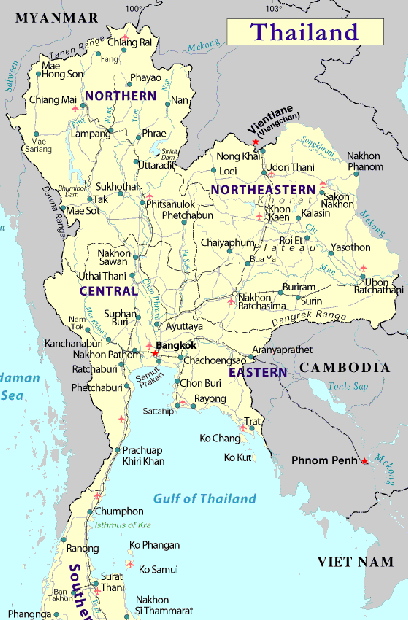
Map of Thailand
metres above sea-level and located in a large flat Slain surrounded by dense monsoon forest-covered mountains in the east , north and west. A river, Ping River, flows from north to south through the plain to join the Thailand’s longest river, Menam Chao Phraya.
Climate It has a Tropical Monsoon climate with the temperature ranges from 13 to 28 degrees C between mid-November and January and 17 to 36 degrees C between February and mid-November. The raining season starts from June to mid-November.
Population It is the second largest city in Thailand with a population of about 250,000. Most of the inhabitants are Thais and majority of them embrace Buddhism.
Hill-Tribes Chiang Mai also has several small hill-tribes living in the rural areas, such as the Karen (Kariang, Yang), Akha (Ekaw), Lisu (Lisaw), Lahu (Mussur), Yao (Mien) and Hmong (Meo). These hill-tribes are steeped in traditions and cultures. They live on subsistence agriculture like planting paddy, maize, fruits and vegetables.
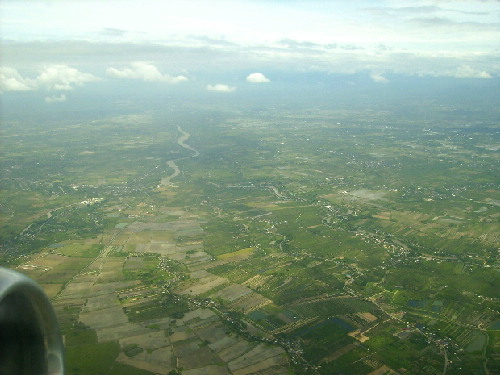
Chiang Mai in a plain
In spite of the rapid growth in the last 10 over years Chiang Mai is still a charming and quaint city. It is dubbed “The Rose of the North” and North Thailand is known as “The Kingdom of a Million Rice Fields”.
Tourism Chiang Mai is well linked to Bangkok by road, rail and air. Tourism is now a fast growing industry in Chiang Mai. Its charm, beauty, tranquility and rich culture attract hundreds of thousands of domestic and foreign tourists every year. Besides, the people are kind, friendly and hospitable. Tourism is an important industry to the local people as it provides them lots of jobs in hotels, transport, restaurants, cottage industries and recreational and entertainment activities.
History According to the Siamese history, Chiang Mai was established by King Mengrai in 1296. Later, in 1558, it
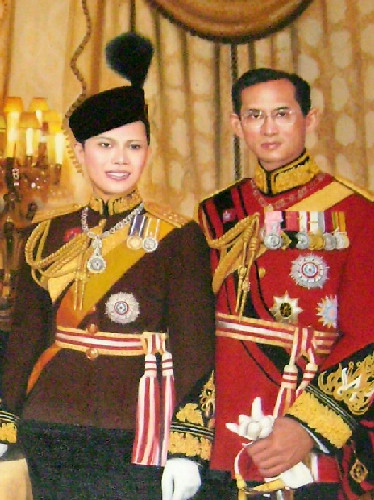
King and Queen of Thailand
was captured by a Burmese king, King Bayinnaung of Pegu,. Since then it was ruled by the Burmese for about a quarter century. Then in 1799 it was recaptured by a Siamese prince, Prince Kawila.
The present King of Thailand is King Bhumibol. He was born on 5th. Dec 1927 and acceded to the throne on 9th. June 1946. He is fondly loved and respected by his subjects because of his compassion, warmth and commitment to his country’s progress. He is the world’s longest reigning, living monarch.
New and Old City The city is divided into two parts by the Ping River. To the west of the river is the old part of the city whereas to the east the modern one. The former offers more interesting tourist attractions.
In the old part of the city there is a rectangular moat (1.8 km x 2 km) which surrounds a wall made of bricks and earth. The wall was built to protect the
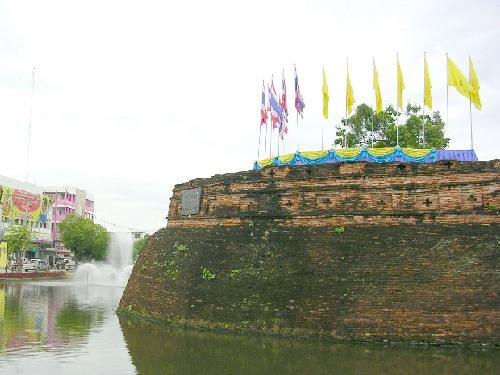
A moat and wall in the Chiang Mai old city
royal city during the reign of King Mengrai. This part of the city is more than 700 years old.
Buddhist Temples Buddhist temples can be seen all over the city and also in the outskirts. It claims to have more than 300 temples which the Thais called them wats. A large number of them are restored and used for religious purposes. Saffron-robed monks are a common sight in the city.
Most of these temples have common features. They have a consecrated ceremonial hall which houses a large Buddha figure and other artifacts. The walls of the hall are beautifully decorated with murals depicting scenes of Buddha’s life. Near the hall is a monks’ living quarter and a general purpose
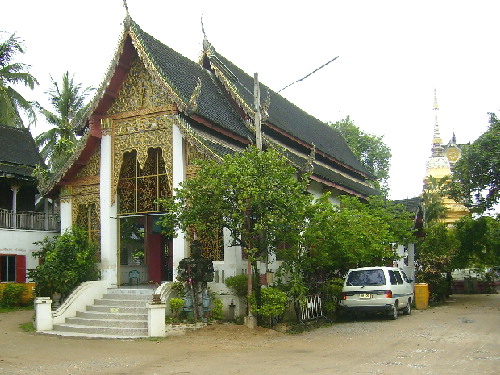
A Siamese temple
hall. Besides, a temple has a tall tower (chedi or stupa) which is either in the shape of a bell or stepped style (prasat style). Some temples have a school in their compound.
Buddhism is based on the teachings of Siddhartha Gautama who lived in North India in the 6th. Century B.C. (Before Christ). The religion spread to Thailand via the Khmer Empire and the Silk Route from China.
Temples play an important role in the ritual and social life of the Thais. It is a normal practice for every Thai male to take up monkhood at least once in his lifetime.
My wife, our big son and I wanted to enjoy the sights and sounds of Chiang
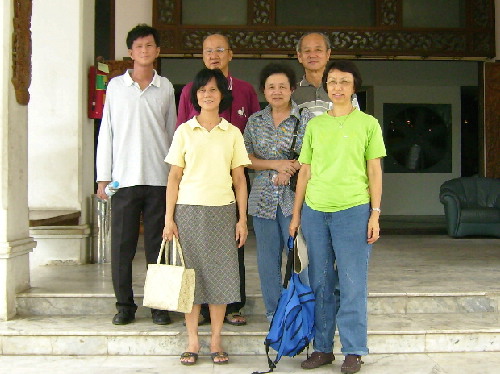
Writer and his tour group. (The writer is the first person from the right in the back row)
Mai very much. So, on 4 July 2006, we joined three of our friends from our hometown and flew together on a low budget plane, Air Asia, from Kuala Lumpur straight to Chiang Mai. The journey took less than three hours.
The Travel Itinerary The following is the itinerary of our unforgettable Chiang Mai experience:
Day 1 Travel to Chiang Mai City
Cottage Industries I
Cottage Industries II
Day 2 Travel to Chiang Rai
Hill-Tribes of Northern Thailand I
Hill-Tribes of Northern Thailand II
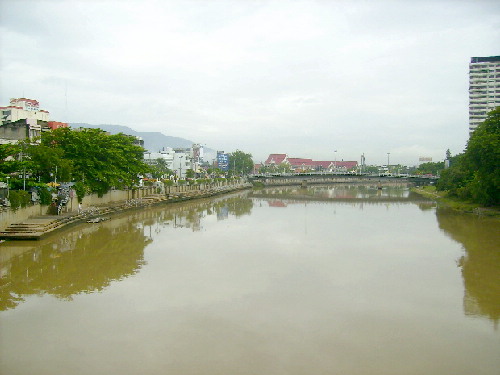
Ping River in Chiang Mai
The Golden Triangle
Mae Sai (BorderTown)
Day 3 Maesa Elephant Camp
Mae Ram Orchid Farm
Mae Sa Snake Farm
The Monkey Centre
Wat Phratat Doi Suthep
Chiang Mai Arts & Cultural Centre (Museum)
Chiang Mai Night Bazaar
Day 4 Warorot Market
Departure to Malaysia
Day 1 Tuesday 4 July 2006 Travel to Chiang Mai City
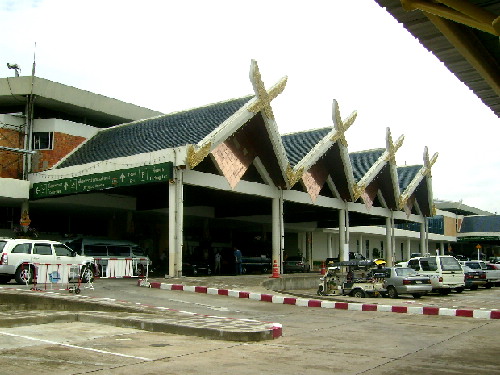
Chiang Mai Airport Terminal
Upon arrival at the Chiang Mai airport before noon, we took a ‘minibus’ to the downtown. In the city we saw large pictures of the Thai king, King Bhumibol, and Thai flags flying everywhere. The whole nation was celebrating the 60th. anniversary of their king’s accession to the throne.
Lai-Thai Guest House We checked in at a hotel known as Lai-Thai Guest House which we had booked earlier through Internet. It is at 111/4-5, Kotchasarn Road, Chiang Mai 50100 (www.laithai.com). It is a three-storey semi-wooden building that is in a U-shape and has a clean swimming pool in the centre. The building is built in Siamese architechural style.
‘Tuk-Tuks’ After lunch, six of us hailed two ‘tuk-tuks’ to bring us to see
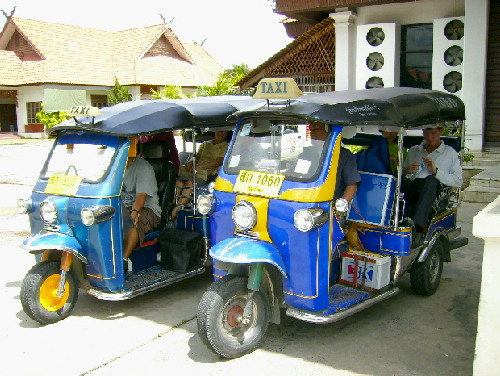
“Tuk-Tuks”- A cheap popular mode of transport in Chiang Mai streets
some famous cottage industries located along Chiang Mai-Sankampaeng Road. Our two friendly ‘tuk-tuk’ drivers introduced themselves as Yau and Pantip.
A ‘tuk-tuk’ is a small three-wheeled vehicle which runs on petrol and can carry three passengers at the back. The only problem with this type of vehicle is that its roof is too low.
Chiang Mai Cottage Industries
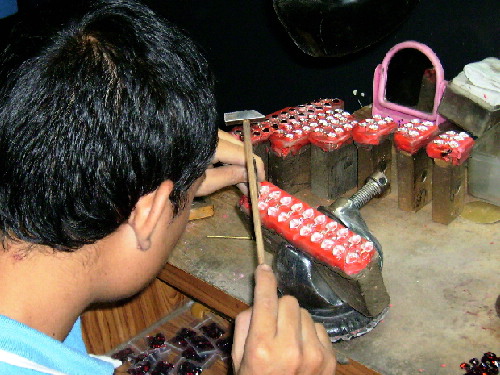
A jewel maker fixing a gem in a ring at International Fine Creation Co. Ltd.
Our ‘tuk-tuks’ we hired brought us to the Chiang Mai-Sankampaeng Road to visit some cottage industries. This road is also known as “Handicrafts Highway” as there are countless cottage industries of handicrafts on both sides of the road such as silverware, copperware, lacquerware, woodcarving, parasol making, leather goods and many more.
Silver Factory The first industry we visited was P-Collection Factory which makes all kinds of silverware. In the factory, artisans can be seen busy making silver articles like jewellery and figurines.
Jewellery Factory International Fine Creation Co. Ltd. was the next factory
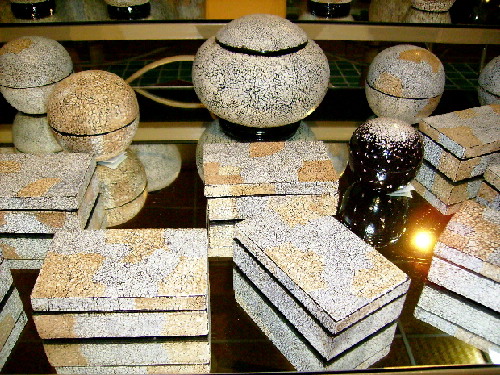
Egg-Shell Covered Containers
we went to. It makes and sells jewellery with precious stones which are beautifully cut, like sapphire (pink, blue), emerald (green). topaz (orange), opal (mixed green and blue), garnet (red), diamond, ruby, amethyst and many more.
Leather Factory S.K. Leather Co. Ltd. produces goods made of skins of snakes, crocodiles, deer and cows such as bags, handbags, belts, shoes, wallets and clothes. It exports most of its goods.
Lacquerware Factory Then we went to another factory known as
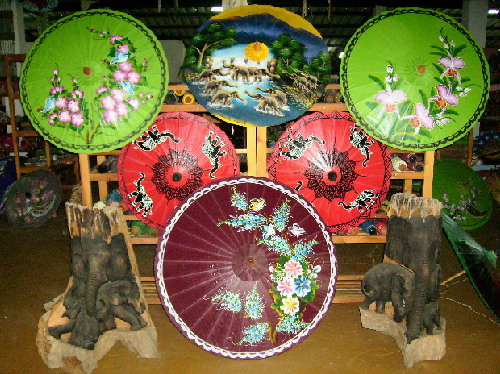
Beautifully-Painted Umbrellas
Lantong Factory Ltd. where lacquerware is made. Here wooden objects are sculptured, painted and finally lacquered so that they look shinny. At that factory, I watched a worker painstakingly gluing small pieces of egg shell on to a seven-sided black board and then pressed them into smaller pieces giving the board an artistic pattern. That was an interesting and unusual piece of art.
Parasol Factory Sankampaeng Umbrella & Handicraft Industry produces silk, cotton and paper umbrellas of different sizes. The umbrellas are beautifully painted by talented local artists. They usually paint flowers and elephants on the umbrellas.
Woodcarving Factory Chiang Mai Sudaluck produces teak and
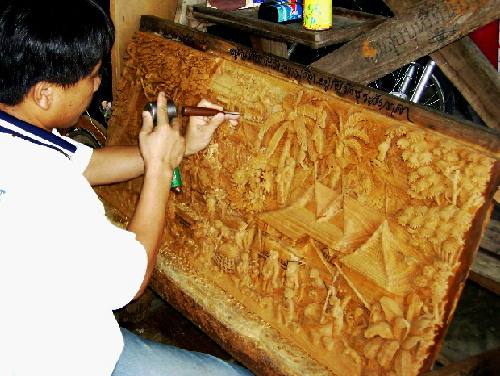
A wood-carver painstakingly carving a 3 D-picture
rosewood furniture with beautiful carvings. Besides, its skilful and artistic workers are able to produce 3-dimensional pictures of Siamese villages on rosewood and wooden sculptures. Carving a 150 cm x 50 cm three-dimensional picture of a village usually takes an expert-carver two months to complete.
Carpet Factory Heritage International Ltd. sells beautifully designed carpets for use and carpets with semi-precious stones sown on them for wall decoration. Besides, it imports bronze antiques from India for sale.
Jade Factory Siam Gifts House of Jade was the last factory we visited. It
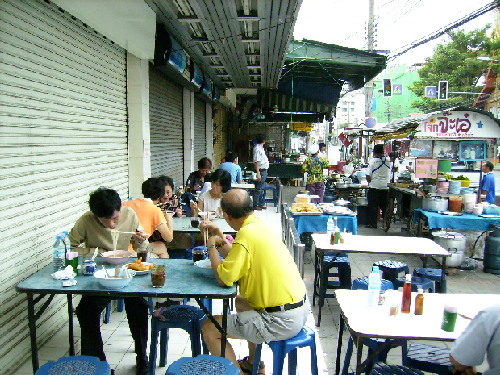
A Siamese Roadside Noodle-stall
sells a variety of products using jades of all kinds of colours, like jewellery, figurines and large and small objects.
Day 2 : Wednesday 5 July 2006 Travel to Chiang Rai
Our Coach Driver and Guide At about 7 a.m. a coach we had hired earlier came to our hotel. The coach driver introduced himself as Mr. Nom and the tour guide, a young fresh university Thai graduate, as Mr. Hacks. As we had not taken our breakfast, our kind driver brought us to a popular roadside noodle-stall not far from the hotel. We sat tha tables on the five-
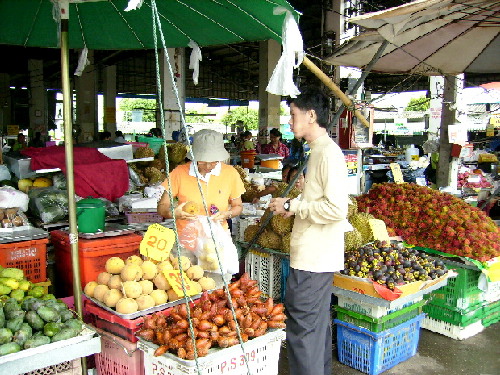
A fruit stall at Bandu Municipality Market, Chiang Rai
foot way and soon we were served with hot Siamese noodle soup. After the delicious meal, we began our long journey to the north to Chiang Rai.
Chiang Rai On the way, we passed through a scenic mountainous region. When we reached Chiang Rai we stopped at a market known as Bandu Municipality Market, Fresh local vegetables and fruits were bountiful there. We bought big, juicy and sweet lychees, durians, rambutans and cut pineapples. Besides, we bought some local snacks to munch while travelling in the coach.
A Baby Elephant At the market we were surprised to see a baby elephant. It was following its owner who was selling some snacks. Kind
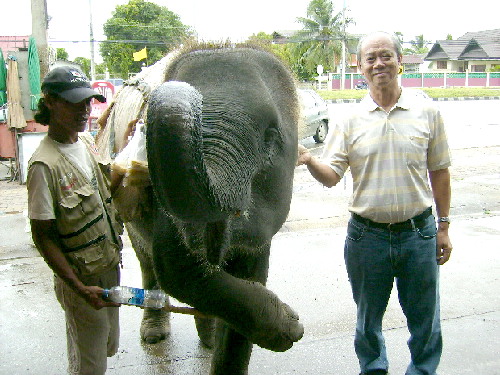
Writer posing with a baby elephant which made a curtsey at the Bandu Municipality, Chiang Rai
vegetable and fruit sellers who found the animal so cute and lovable gave it some of their produce. Foreign tourists and I asked the friendly owner for permission to take a photograph with the tame elephant. We were amused when it curtsied.
Union of Hill-Tribe Villages Then we moved on again. The next stop was a well-known place, Union of Hill-Tribe Villages, which is 12 km from Chiang Rai. At this place one will see five types of hill-tribes in their traditional costumes, namely Akha, Yao, Mussur, Palong and Karen. They stay at their mini-villages which are at different spots but near to each other. They are there during tourists’ visiting hours only as the place is just a showcase of Thailand’s different hill-tribes.
Hill-Tribes in Northern Thailand In the olden days, the hill-tribes
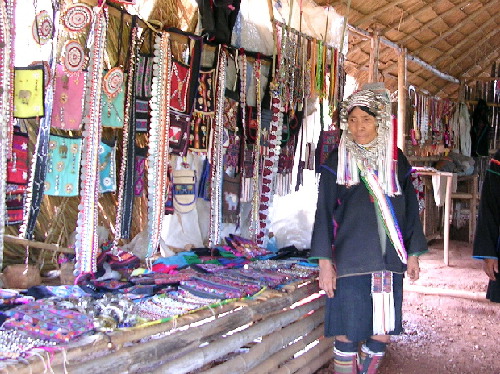
An Akha lady selling handmade articles
migrated from southern China to Myanmar, Thailand, Laos and Vietnam.
Now, there are six major hill-tribes in Northern Thailand belonging to the Thai national minorities, namely Karen (Kariang, Yang), Akha (Ekaw), Lisu (Lisaw), Lahu (Mussur), Yao (Mien) and Hmong (Meo).
These hill-tribes are steeped in traditional cultures and live on subsistence farming. They use simple tools like hoes to cultivate hill paddy and plant cash crops, such as maize, fruits and vegetables on a small-scale. They also raise domestic animals like fowl, goat and buffalos.
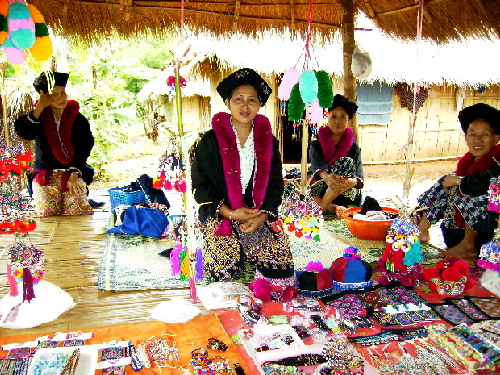
Yao ladies selling handmade articles
Most of these tribes live in poverty. Their wooden houses are small and the roofs are made of dry large leaves or fronds of palm trees. They have bare necessities inside their houses.
Each tribe has its own distinctive culture, religion, language, art and traditional costumes.
The hill-tribes believe in territorial spirits for forests and fields, tutelary spirits for houses and towns, and ancestral spirits.
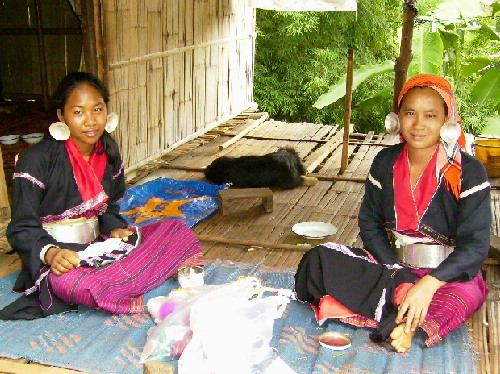
Palong ladies
These tribes are good at making handicrafts. They sell them in Chiang Mai and other towns to earn extra income.
Union of Hill-Tribe Villages Located 12 km from Chiang Rai, the Union of Hill-Tribe Villages is a showcase of five hill-tribes, namely Akha, Yao, Mussur, Palong and Karen.
Before we entered the villages, a man at the main entrance asked us to look at a dirty, old map and told us the route we had to take to visit the five hill-tribes. As it had rained earlier the ground was wet, soft and slippery. So, he
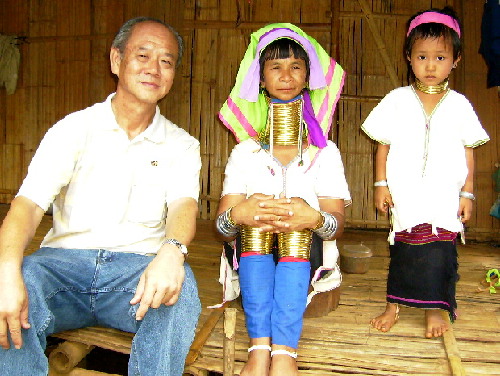
Writer sitting with the Karens with brass coils
asked us to take along a long stick each.
Akha Village The first village we came across was the Akha village where we were greeted by a few young and old ladies in their traditional clothes. They were sitting on raised bamboo platforms in front of their houses. They were wearing black headgears covered with silver coins. We felt frustrated as we could not converse with them in their language or Thai. All we could do was to smile, say “Hello” and wave our hands to mean “Goodbye”. Then we walked to a larger house where a group of Akha ladies entertained us with their simple traditional musical instruments.
Yao Village The next village we visited was the Yao’s. The Yao
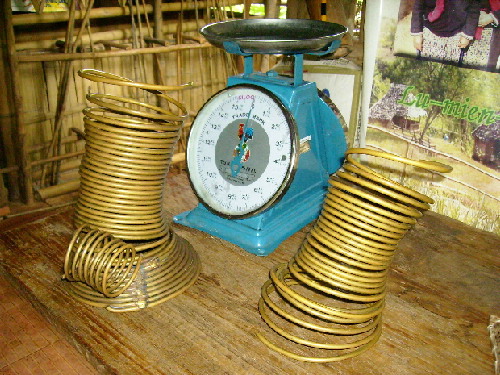
Use a weighing machine to find out the weight of a Karen brass coil
ladies looked well-dressed in their traditional costumes. They wore black turban-like headgears. When they saw us, they greeted us with a big smile. We were surprised that two of them could talk to us in Chinese. After a short conversation with them, we had a good look at their handmade purses. jewellery, trinkets, etc.
Palong Village Then we visited the Palong hill-tribe. We noticed the Palong people were wearing simple black clothing and some ladies were wearing simple coloured head-scarves. They entertained us with a lively traditional dance. Their children joined them too.
Karen Village The last hill-tribe we visited was the well-known Karen. We were fascinated and amazed to see only female children and women
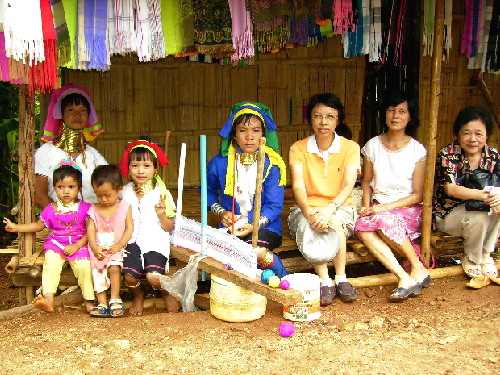
A large Karen “family”
wearing shiny brass coils round their necks. They were very friendly and loved to take photos with us.
Female Karens are the only people in the world having very long necks. They start wearing coils round their necks when they are a few years old. As they grow older more turnings are added to their coils. Some say they wear the coils to prevent tigers from biting their necks and others think they wear them for beauty hoping to get a life-long partner easily.
I left the Karen hill-tribe with a big question in my, i.e. “How do they eat, drink, bathe, sleep and get up from their beds with the heavy metallic coils round their necks?”. A large neck coil may weigh about 5 kilograms!
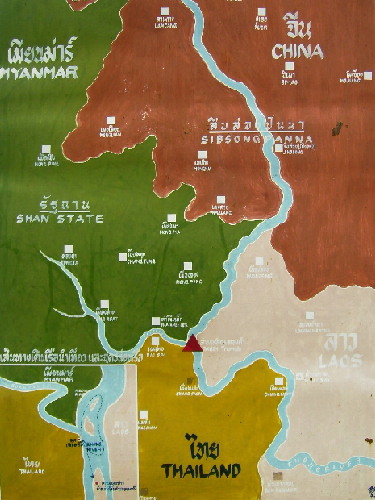
Map showing the location of the Golden Triangle
After visiting the hill-tribes, we went to a place where we sprayed water on the soles of our shoes to get rid of the mud which we had collected while walking in the hill-tribe villages. Soon we left the place and continued our journey to the well-known Golden Triangle in the north.
The Golden Triangle The Golden Triangle was actually a notorious region for the harmful opium trade. It covered a large area of 350, 000 sq. km. including the northern parts of Thailand, Laos and Vietnam, and eastern part of Myanmar. As the governments of the four countries knew that drug addiction would ruin their people’s lives and cripple their economies, they constantly cracked down on drug barons and encouraged their people especially the hill-tribes to plant cash crops instead of opium poppies. Now, they have successfully eradicated poppy-growing
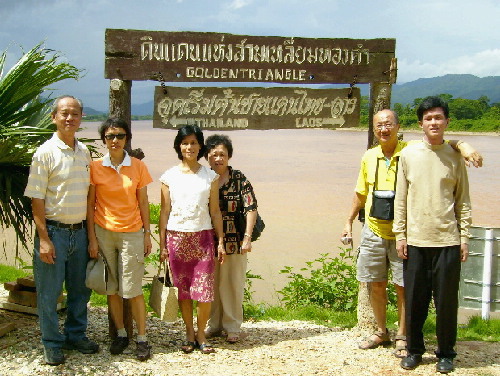
Writer and his tour members at the Golden Triangle
in many parts of their countries. They are always on the look out for illegal planting of the poppies, especially in the jungle areas.
Now the Golden Triangle is a small area around the confluence where River Mekong (or Mae Khong- 4,184 km long) and River Ruak meet. These two rivers form the common border for Thailand, Myanmar and Laos. The Golden Triangle is now a popular tourist attraction that reminds visitors of the past busy and lucrative opium trade there.
Sop Ruak A small old Thai town known as Sop Ruak exists in the Golden
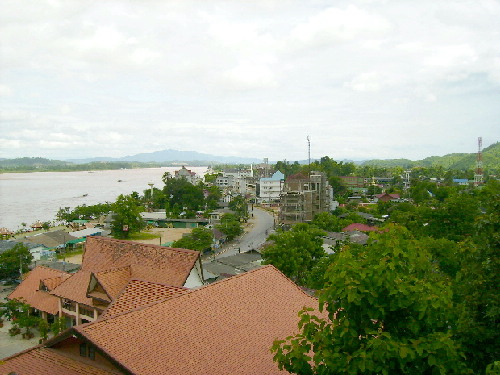
Sop Ruak Town in the background and Mekong River on the left
Triangle and is 9 km north of Chiang Saen. It is located by the Mekong River. Small restaurants, souvenir shops and other types of shops line the roads of the town.
On arrival at the Golden Triangle we noticed that the place has a picturesque view of the two wide rivers, the lush green forest-covered mountains in the distance, the quaint Sop Ruak town and the old and new temples.
An Open Air Temple There is a beautiful open air temple at the confluence where a huge golden statue of Buddha sits cross-legged on its large altar. It is about 8 metres high. At the back of this statue is a smaller white statue of a
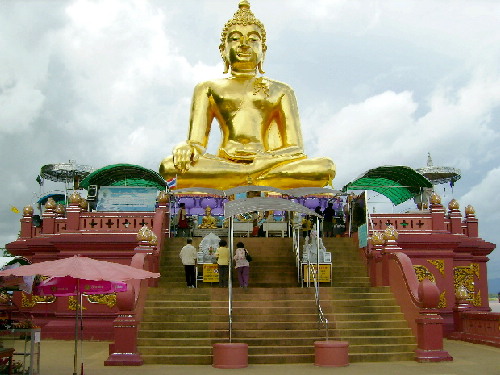
A Large Golden Statue of Buddha at the Golden Triangle
Chinese version of Buddha, “Tuah Peh Kong”. In front of the golden Buddha are three smaller golden statues of Buddha and a large statue of a black elephant carrying Buddha’s relics. Further down the Mekong River bank are six golden columns with beautiful and intricate Siamese designs which I think are monuments to the great Siamese kings. On the Myanmar river bank in the distance are some red-roofed buildings which are known as Paradise Resort. It has a casino to attract foreign tourists.
It is a frustration for a foreign tourist not to know the names of the temples, the structures and the statues at the confluence as all the writings there are in Thai. I hope the Thai government will translate them especially in English for foreigners.
Wat Phrathat Pukhao On top of a small hill near the confluence is a small, old
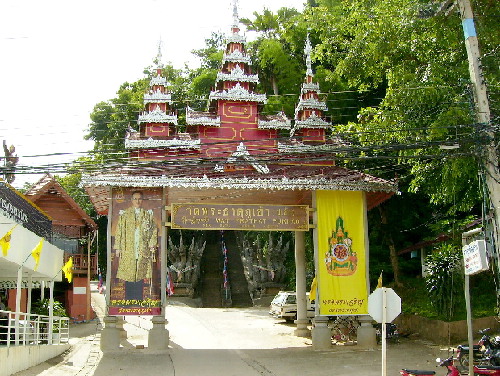
Wat Phratat Pukhao Arch
and simple temple which is over 1000 years old. It is known as Wat Phrathat Pukhao. To go up to the temple, I walked up a flight of 104 steps alone. These steps are lined with two long Siamese legendary grey dragons each with five heads. Each head has a long crooked horn projecting from its forehead.
When I reached the top, I realized I was the only person around. Fearlessly, I looked around and walked to the doorstep of the temple. I looked inside and saw a large statue of Buddha looking down at me. After taking a few photos at the temple, I walked to a vantage point nearby. From that point I could see a scenic panoramic view of Sop Ruak town, the wide Mekong River and the
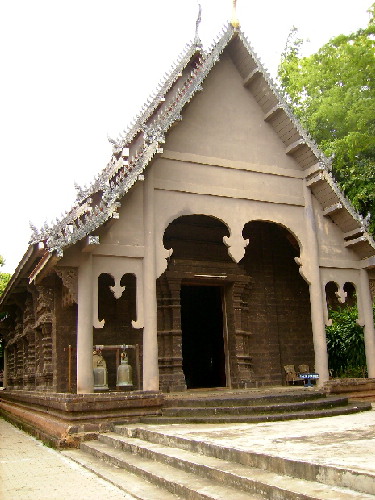
Wat Phratat Pukhao (A temple of over 1,000 years old)
lush green mountains in Laos. Then I went down the hill to join my tour group.
Hall of Opium Museum Owing to time constraint, we did not visit a museum at the Golden Triangle. It is known as Hall of Opium where one can gain an insight into the history of opium trade there and harmful effects of opium. The museum provides photographs, films and videos about opium and other types of dangerous drugs from other countries. It should be a worthwhile visit there if one has some time to spare.
Our next destination was a Thai border town known as Mae Sai which is 28 km by road from the Golden Triangle.
Mae Sai (A Border Town) Mae Sai is the northern-most town in North
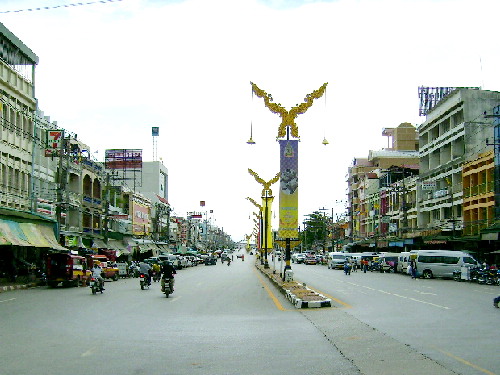
Mae Sai, aThai border town
Thailand. It is a small town near the Myanmar border. It has a large arcade where lots of stalls are selling a myriad of things ranging from accessories and clothes to watches and electronic goods. Near the place is a brightly and heavily-decorated temple which houses a large statue of Buddha. Besides, it has colourful murals inside depicting the Buddha’s life.
Mae Sai has an immigration checkpoint at the border between Thailand and Myanmar. To cross over the border to a small town known as Tha Kwee Lek in Myanmar, one may pay 300 Thai baht to a Thai motorcyclist who will bring one
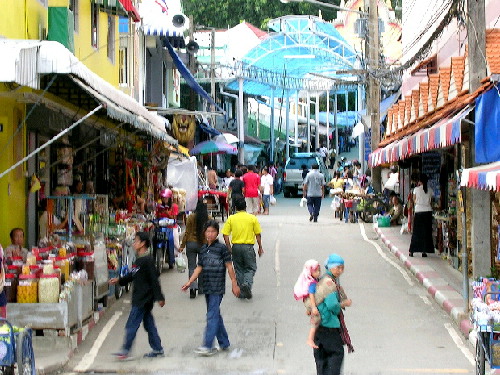
Mae Sai Shopping Arcade
over there. One may extend one’s Thai visa when one comes back to Mae Sai from Tha Kwee Lek.
At about 4 p.m. I saw many Myanmar vendors pushing their carts with unsold goods to the the immigration checkpoint. They were going back to their country after a day’s business at Mae Sai Town.
Chiang Rai Hot Spring After spending an hour at Mae Sai, we headed back to Chiang Mai City. On the way, we stopped at Chiang Rai to see natural hot spring water in three wells. The steam coming out of the wells has a little bit of sulfur smell. As the temperature of the water is 90 degrees C, local
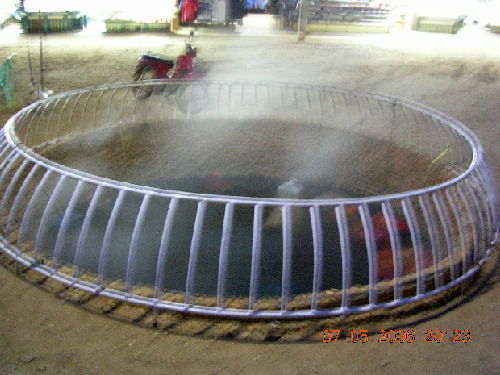
A Hot Spring Well at Chiang Rai
people immerse bags of sweet-potatoes and corns in the hot water for half a day to get them cooked. Then they take them out and either sell or bring them home to feed their families.
One can buy some eggs from lady-vendors near a well, borrow their bags for the eggs and slowly lower them into the well using strings attached to the bags. If one waits for a few minutes, one will get to eat the hard-boiled eggs.
Many stalls selling souvenirs, jewelleries, accessories, handicrafts, clothes, etc. are found near the wells.
Dinner at Anusarn Market At 9 p.m. we finally reached Chiang Mai. We had late dinner at Anusarn Market where there are many open-air restaurants. After dinner we visited a few stalls along Chan Klan Road. An hour later we went back to our hotel.
Chiang Mai, Chiang Rai, The Golden Triangle Travel (Part II)
[continued from “Chiang Mai, Chiang Rai, The Golden Triangle Travel (Part I)”]
Chiang Mai Travel
Day 3 : Thursday 6 July 2006 Maesa Elephant Camp
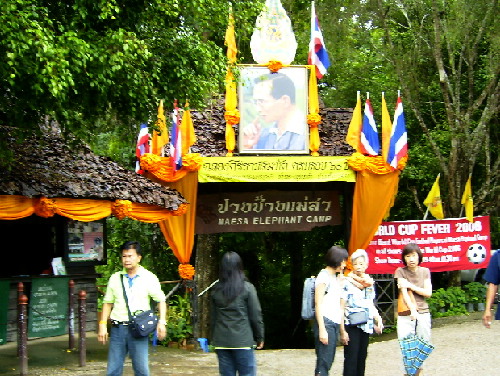
Maesa Elephant Camp Entrance
The tropical monsoon forests in north Thailand produce durable hardwoods. The best wood is teak as it has great durability, strength and immunity to shrinkage, fungus and insect attack. It is usually used for making furniture and building houses, ships and bridges.
Elephants are the Thais’ cultural icon. To the Thais, elephants are a symbol of fortune. According to their beliefs, one will get good luck if one passes under an elephant.
As elephants are large and strong many of them were used in the tropical monsoon forests to haul logs from the forests to the collecting points. Nowadays, as there are less forests to be logged some are used in the
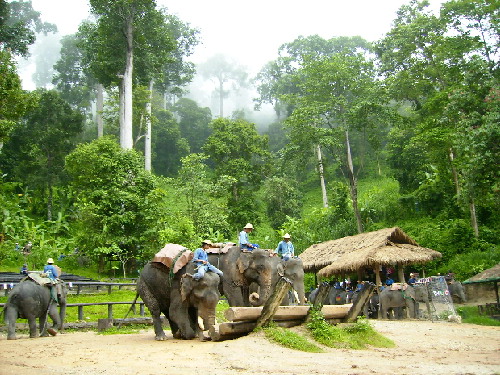
Maesa Elephant Camp in the lush green tropical monsoon forest
Thailand tourist industry. They are used to carry tourists for joyrides and show them their skills in logging, painting, dancing, etc Their amusing and amazing tricks are often greeted with rapturous applause from the spectators.
Maesa Elephant Camp To watch an elephant show, we went to Maesa Elephant Camp near Chiang Mai. On entering the camp, we saw several elephants bathing in a river. After bathing, they walked to an open space nearby where they would perform a show.
As we walked to the show ground, I saw a large board with a list of 77 elephants’ names and their ages ranging from 2 to 48 years old. Then we walked to a small stall and saw lots of drawings by elephants for sale. Each drawing had a photo of a
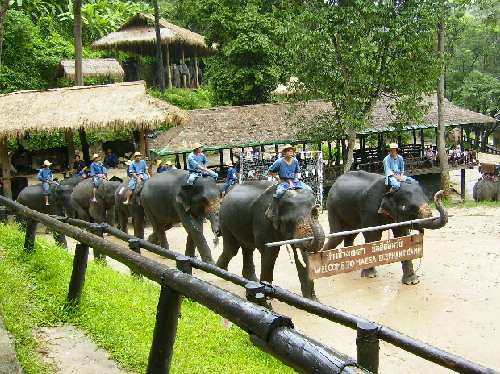
Elephants welcoming the spectators
proud artist and cost a few thousand Thai baht! Entering the elephant show ground, we saw lots of people who had already taken their seats.
An Amazing Elephant Show Soon the show started with two elephants walking majestically and carrying a big signboard round the place. The signboard said “WELCOME TO MAESA ELEPHANT CAMP”. It was followed by a few elephants.
After the welcoming ceremony, the elephant show began. The animals performed some interesting and entertaining acts like blowing harmonicas and dancing at
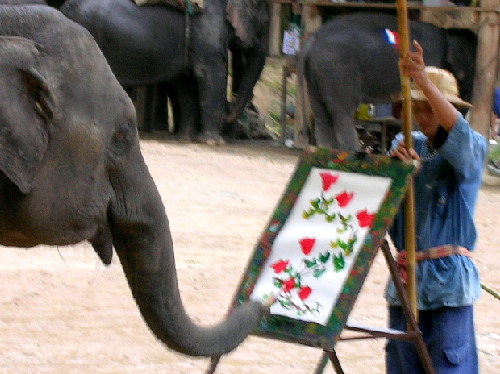
A Talented Artist
the same time, kicking a large football into a goal-mouth, painting, showing off massaging skills, playing a pick-up-stick game and logging. The show ended with the same elephants carrying another signboard which said “THANK YOU. HAVE A NICE DAY”.
The Amazing Elephant Artists There were two performances that amazed the spectators and me too, namely the painting session and the football penalty shoot-out. It was fascinating to watch six elephants using water-colours to paint trees, flowers and their own species in the centre of the ground. With the paint brushes in their trunks, they slowly painted on white papers on the easels. They painted like a professional without any help except dipping their brushes in
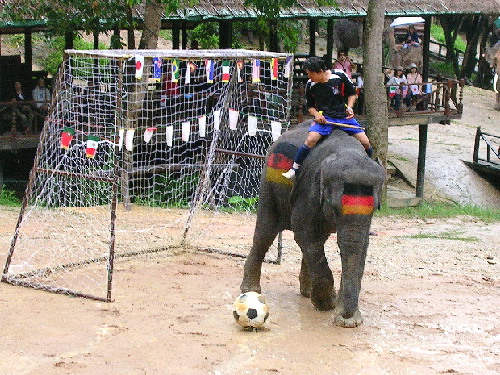
A “German’ Goalkeeper
water-colours by their masters. As soon as the elephants finished their painting, we were surprised to see a middle-aged European lady in the audience jumped up, pointed at a drawing with red flowers and shouted repeatedly, “I want to buy that painting.”
Penalty Shoot-Out by Elephants The penalty shoot-out by two elephants was an entertaining one. One of them had a France flag painted on its body while the other a Germany flag. After a few shoot-outs, guess which elephant won the penalty shoot-out? It was the one with the Germany flag as the score was 1 – 0. We cheered and clapped loudly as the elephant that won kept on swinging its trunk in jubilation. But, the coming World Cup Final on 9 July
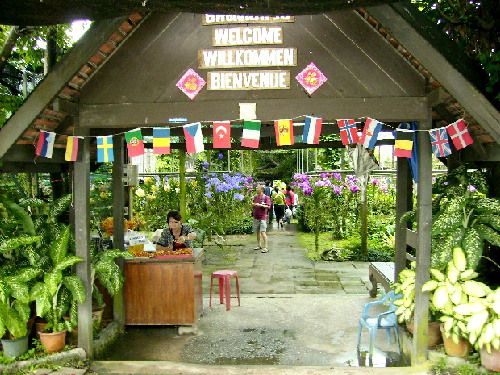
Mae Ram Orchid Farm Entrance
2006 was between Italy and France. ( Italy won the World Cup 2006 on penalty shoot-out : 4 – 2)
The elephant show is worth seeing. I think the elephant-masters should get the credit for the fantastic show.
After the elephant show we went to an orchid farm known as Mae Ram Orchid.
Mae Ram Orchid Farm Mae Ram Orchid Farm is located along Mae Rim – Samoeng route. It has a large collection of different types of orchids of different colours, shapes and sizes.
Orchids are flowering plants belonging to over 800 families (genera) which
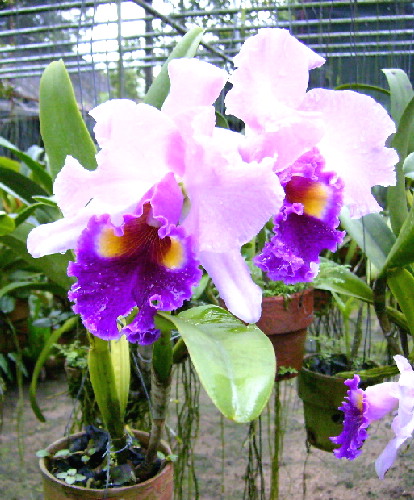
White and purple orchid flowers
have over 25,000 species. Their flowers of different colours are beautiful to look at.
At the orchid farm, we saw quite a number of them blooming with colourful flowers. They were so beautiful that we wasted no time snapping photographs of them. Unfortunately, we cannot remember their long names.
Having seen all the stunning orchid plants, we went to the back of the farm to see butterflies. Unfortunately, we saw workers pulling down the butterfly enclosures. We guessed they were going to build new ones for the butterflies.
We left the orchid farm for an exciting and thrilling snake show at Mae Sa Snake Farm which is nearby.
Mae Sa Snake Farm Mae Sa Snake Farm is located along Maerim-Samerng Road. It is the largest snake farm in 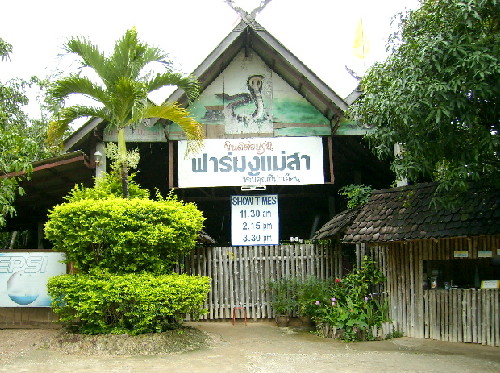 northern Thailand. Many kinds of poisonous and non-poisonous snakes are found here. To attract tourists, it offers three snake shows a day.
northern Thailand. Many kinds of poisonous and non-poisonous snakes are found here. To attract tourists, it offers three snake shows a day.
When we entered the farm, we were in a place where a snake show had just started. We sat on long wooden blanks with other tourists and watched the show. It was performed by two young, energetic and brave men in a ring.
In the show a performer showed us the way he milked the snake’s venom. After that
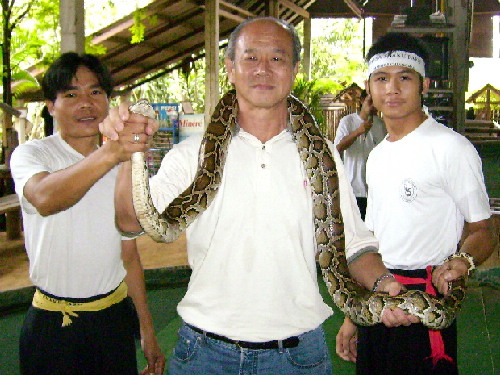
Writer holding a large python
the two fearless men performed dangerous tricks with other poisonous snakes that kept us on edge most of the time.
A Large Python In the middle of the show, the two men encouraged us to enter the ring and hold a large python. At first I did not think of getting near one as I was always wary of it. But when I saw two young boys entering the ring and holding the snake bravely, my fear for snakes suddenly disappeared. Without hesitation, I entered the ring and asked the two men to allow me to hold it. While holding the head of the snake in my right hand and its tail in my left, I posed fearlessly with the tame snake. That was my first unforgettable experience of holding and touching a cold-blooded creature.
“A Jumping Poisonous Snake” Dring the last trick of the show, the performers told us that there was a jumping
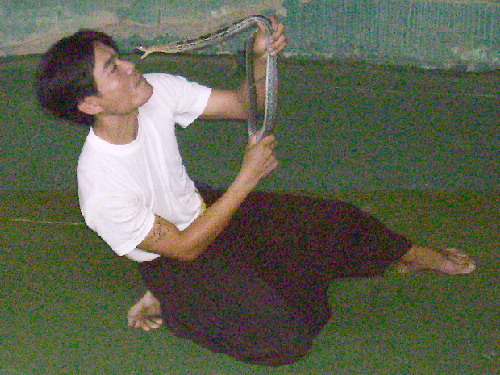
A snake-performer dicing with death
poisonous snake in a box. Opening the box, they used sticks to poke at the snake inside. Suddenly, one of them using his stick flung the snake out of the box and it landed on one of the spectators, a young girl. She jmped up and screamed. All of us were shocked and wondered whether she was bitten by the snake. One of the performers rushed to the victim, picked up the snake from the ground and showed us a long piece of rope instead. When we knew it was a trick, we burst into laughter. The performer apologized to the “victim” profusely. We sympathized with the “victim” as that was a traumatic experience for her.
Snakes in Enclosures After the snake show, we walked to the back of the
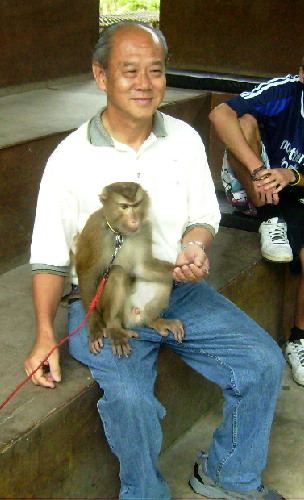
Writer befriending a monkey at the Monkey Centre
farm and saw a variety of snakes in their enclosures. Unfortunately, we could not see them clearly as the holes of the net round each enclosure were small. But we saw some snakes resting in the trees. Then we left and went to the Monkey Centre to watch a monkey performance.
The Monkey Centre The monkey show at the Monkey Centre was our last animal show. It is located near the Mae Sa Snake Farm along the Maerim-Samerng Road.
Monkey Tricks The show was an enjoyable one as those amazing monkeys could do a variety of tricks including plucking coconuts, shooting a basketball, cycling a small tricycle, selling medicine to spectators, looking for a spectator’s watch in a pool of water, pushing a cart of coconuts and picking the correct number which a spectator had asked for.
A Number Game Among all the monkey tricks, there was one that puzzled the
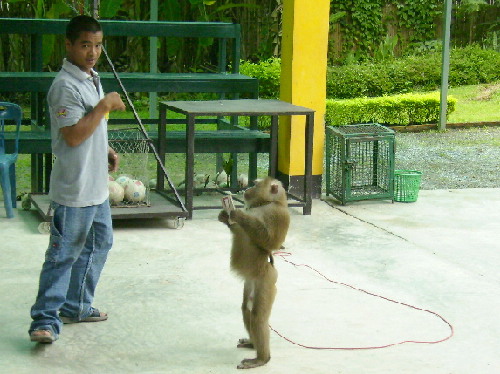
“Is this the number you want?” the monkey seemed to ask showing the little board with number “4” written on it.
spectators and me. In that trick, a monkey master put eight small wooden square boards each with a number on the floor. The numbers were from 1 to 8. He then asked a spectator to turn over all the boards so that the numbers could not be seen and mix them up. After that he asked another spectator for a number he wanted the monkey to pick. When the master told the monkey to pick number “4” which the spectator had asked for, it walked to the row of the overturned boards, thought for awhile, picked up one of them and showed it to the spectators. Unbelievably, it had taken the correct one. We were all amazed.
To convince us that the monkey was smart, the master asked another spectator for a different number which was “7”. After the boards were reshuffled (without the numbers being seen) by another spectator, the master told the monkey to
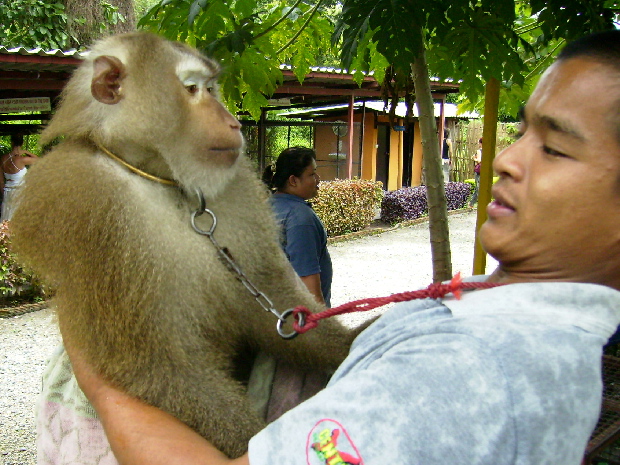
A good bond between a human being and an animal
pick the board with number “7”. Amazingly, the monkey got the right one again. We were all quite impressed and wondered how it did it again.
After the fantastic monkey show, we left for the largest temple in Chiang Mai, Wat Phratat Doi Suthep. It is on top of a high hill known as Doi Suthep overlooking Chiang Mai.
Wat Phratat Doi Suthep Chiang Mai has over 300 temples. They add to its rich cultural heritage. They play an important role in the Thais’ ritual and social life. Many old ones have been restored to their former glories and are now a tourist attraction.
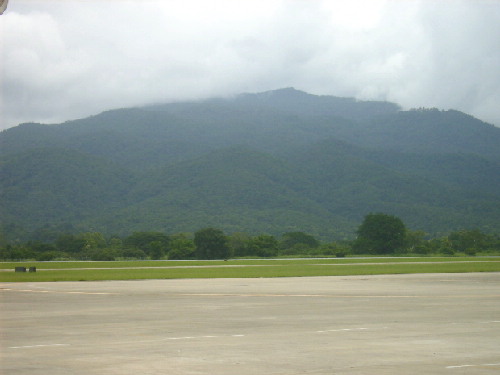
Wat Phratat Doi Suthep is on top of Doi Suthep Mountain
Among all the temples in Chiang Mai, Wat Phratat Doi Suthep is the most famous. It is located on top of a lush green rainforest-covered mountain called Doi Suthep which is about 1066 metres above sea-level.
Kru Ba Sivichai(1878-1938) At the foot of the mountain, there is a monument in memory of a famous Lanna monk, Kru Ba Sivichai, who had supervised the construction of a road up to the top of the mountain in 1935 and the renovation of over 100 local temples.
Future Tourist Development Projects The Thai government has several tourist development projects for the Doi Sutthep area such as a night
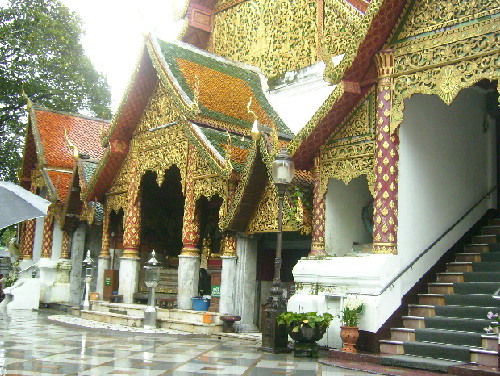
Wat Phratat Doi Suthep
safari park, elephant park, world garden, theme or amusement park and mass transit monorail system. Some of the local people are not happy with the projects as they fear the charm, beauty, tranquility and sacred atmosphere of the place will be gone.
Wat Phratat Doi Suthep It was raining heavily when we reached the foot of the mountain. To go up the mountain to Wat Phratat Doi Suthep, our coach-driver had to drive up a steep, winding and wet road, negotiate sharp bends cautiously and hope there was no landslide on the way.
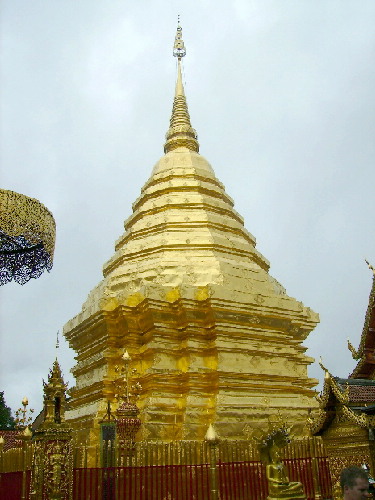
Golden Stupa of Wat Phratat Doi Suthep
When we arrived at the bottom of the temple, it was already shrouded in thick mist. There are two ways of getting to the temple: either one climbs the 306 steps or takes an inclined lift to the temple. A friend of mine and I decided to take the inclined lift to the temple as it was still raining. The rest of them preferred to shop for clothes and souvenirs at the car-park at the bottom of the temple.
Buddha’s Relics On reaching the top, we were charmed by the beauty of Wat Phratat Doi Suthep or Doi Suthep Temple. It has two large golden statues of Buddha in their beautifully and intricately designed buildings, a large golden pagoda-like structure or stupa which enshrines the Buddha’s relics, a large parasol at each corner of the stupa, a chanting house with two legendary crocodiles in front and a white statue of an elephant. The latter is standing in front of the grand temple in memory of the elephant which brought the Buddha’s relics to the top of the mountain during the reign of King Kuena (1355 -1385). Besides, colourful murals
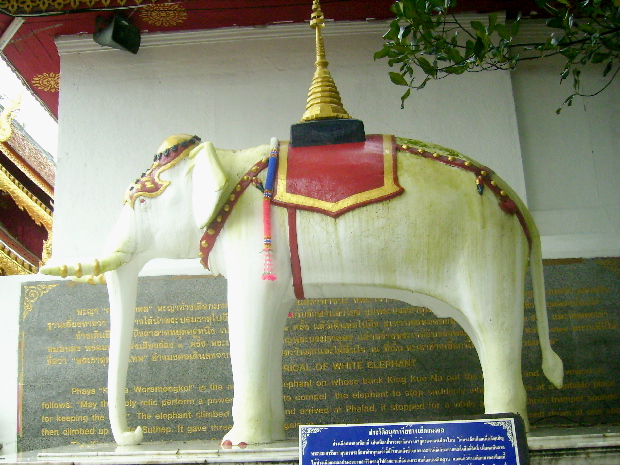
A monument at Wat Phratat Doi Suthep to the elephant that brought the Buddha’s relics to the temple
depicting Lord Buddha’s life, several small Buddha statues and two rows of bronze bells can be seen at the temple. We were surprised to see an old tall Jack- fruit tree with lots of fruits on the left of the temple. That is the oldest Jack-fruit tree I have ever seen.
A View-Point At the back of the temple, there is a view-point where we saw a breathtaking, panoramic view of the Chiang Mai city and its airport. We were lucky to see an aeroplane leaving the airport and climbing steeply to the sky with its engines roaring loudly and later another plane coming down slowly and landing at the airport. Occasionally, the view was blocked by thick passing clouds.
After spending some time at the sacred temple, we decided to walk down the 306 steps to the bottom of the temple. These steps are lined with two long,
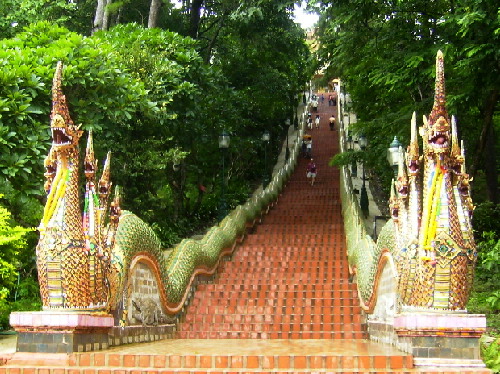
Naga Stairway of 306 steps to Wat Phratat Doi Suthep
colourful and scaly Siamese legendary dragons. Each of them has seven fierce-looking heads. The flight of 306 steps is known as Naga Stairway.
Soon we left Doi Suthep and went to Chiang Mai City to visit a museum known as Chiang Mai City Arts & Cultural Centre.
Chiang Mai City Arts & Cultural Centre This centre is actually the city’s museum which showcases Chiang Mai’s history, economies, customs, traditions, arts and cultures. It is along Prapokklao Road.
Statues of Great Thai Kings The museum is a historic building which was built in a royal architectural style in 1924. It was used for many purposes
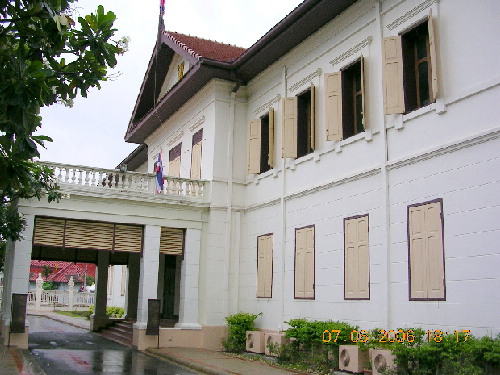
Chiang Mai City Arts and Cultural Centre (Museum)
before the museum took it over in 1997. Standing in front of the museum are three bronze statues of great Thai kings, namely King Mengrai in the middle, King Khum Maung on his right and King Ram Kam on his left. These statues are made in memory of them.
Exhibits in Museum In this museum one learns the development of the northern Thailand region and Chiang Mai city from pre-historical times to the present. To make the tourists understand these better, the museum has models, slides, pictures with explanations, audio and video presentations and graphic displays.
The exhibitions on the ground floor of the building are as follows:
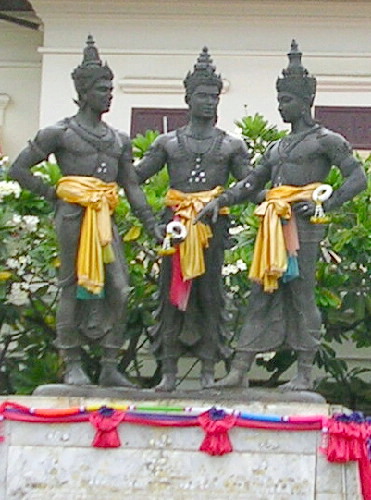
Monument to the Three Great Thai Kings
1 Chiang Mai Today
2 The Prehistory of Chiang Mai
3 The Civilization of the Kok and Ping River Valleys
4 Establishment of the City
5 Environment and Culture
6 The Past 100 Years of the City
7 Good Aspects of the City
Exhibitions on the 1st. Floor :
1 History of the Historical Building
2 The Rulers of Chiang Mai
3 Life on the Ping Riverbank
4 People of the Old City
5 Buddhism in Chiang Mai
6 The Office of the Former Governor
7 The Agricultural Society
8 The Mountain People
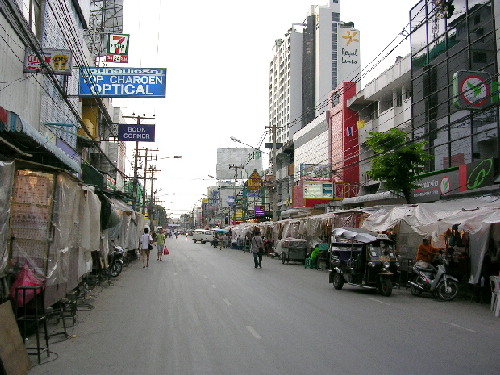
Chan Klan Road Night Bazaar, Chiang Mai
This museum is worth visiting if one wants to learn about Chiang Mai’s past and present.
Having visited the museum, we went to the Night Bazaar for dinner.
Chiang Mai Night Bazaar Located along the entire Chan Klan Road, the Night Bazaar is a shopping paradise for tourists in the evening. Shops along this road sell all kinds of locally and foreign made goods. In the evening, over a hundred street-vendors push their mobile stalls fully loaded with goods like clothing, DVDs, souvenirs, perfumes, accessories, handicrafts and many more to the roadsides.
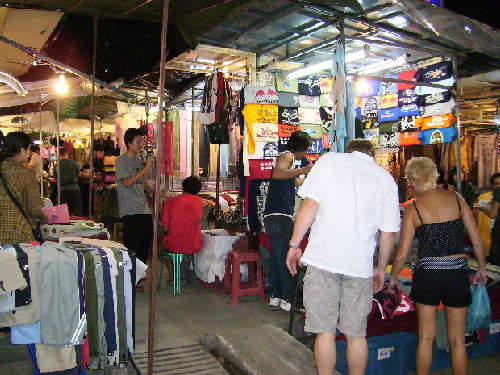
Roadside stalls along Chan Klan Road are opened in the evening
When night falls, this area will be crowded with shoppers and have an ambience of a carnival.
Pavilion Night Bazaar and Chiang Mai Night Bazaar Two large buildings known as Pavilion Night Bazaar and Chiang Mai Night Bazaar are located along Chan Klan Road. They house many stalls which sell all kinds of tourists’ goods such as silk, antiques, clothing, handicrafts, perfumes, watches, CDs, DVDs, shoes, painted umbrellas and many more. At such a place, one is expected to bargain with the vendors until one thinks that the prices are
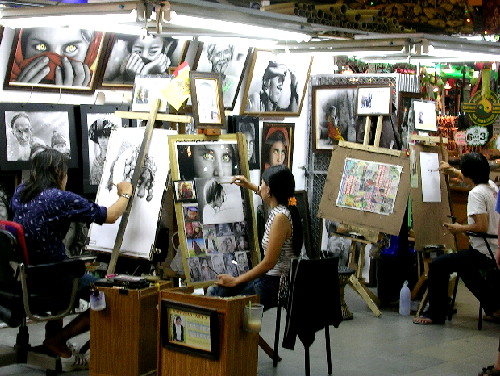
Artists at Chiang Mai Night Bazaar
reasonable.
Chiang Mai Artists At the Chiang Mai Night Bazaar, many artists can be seen busy drawing pictures in black and white or colours from the photos given by their customers. Besides, there are photo studios where one can take a photo in a traditional costume. With a little computer touch-up by the photo studios, customers will look several years younger in their photos.
Anusarn Market A good place to have a meal will be at Anusarn Market where open air restaurants and stalls serve all kinds of Thai, Chinese, and Western food.
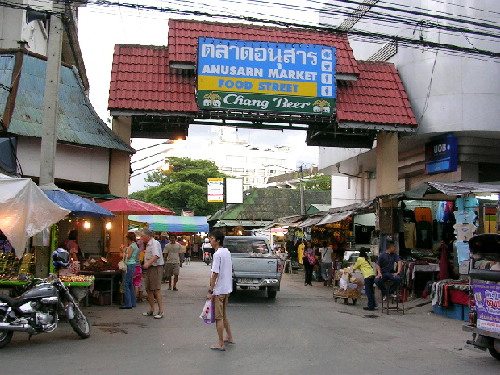
Anusarn Market Entrance to a food-court
Every night while we were in Chiang Mai we went there to taste different types of Chiang Mai food. I found that some of it are not to my liking. Whenever we were there, the place was always crowded and had an atmosphere of festivities.
Day 4: Friday 7 July 2006 Warorot Market
On the last day of our Chiang Mai stay, we decided to go to the largest market in Chiang Mai where local people buy their daily needs in the morning. It is called Warorot Market by the Ping River.
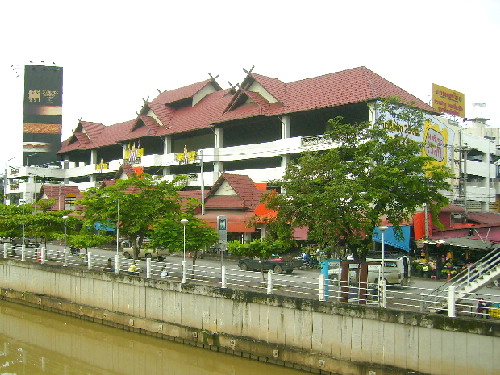
Warorot Market by the Ping River, Chiang Mai
When we arrived at the market, we saw lots of roadside stalls selling things ranging from fresh vegetables and fruits to breakfast food and fresh flowers. Customers who were mostly ladies went there by their own cars, motor-cycles, minibuses, tuk-tuks and trishaws and were busy buying daily needs from the roadside stalls and stalls inside the market.
There are many shops near the market selling goods ranging from handicrafts to shoes and clothes. We went to a few apparel shops to check the prices of some clothes and found that they were cheaper than those we had bought at the Night Bazaar along Chan Klan Road.
The National Anthem of Thailand While we were busy buying some
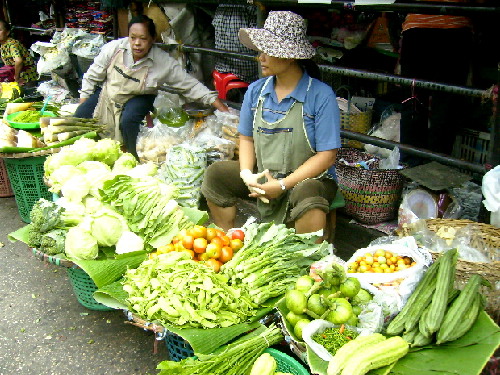
A vegetable seller at Warorot Market, Chiang Mai
snacks from a roadside vendor, we were surprised to see people on the roads and in the shops standing motionless. Then we realized that the national anthem of Thailand was being played loudly from loud-speakers. Quickly, we did the same. When it was over, the people continued doing their own activities. Later, I was told that the Thai national anthem is played twice a day, i.e. 8 a.m. and 6 p.m. and the Thais always respect their national anthem.
After shopping at the market and nearby shops, we went back to our hotel to pack our luggage. We had to catch a flight back to Malaysia at 11.05 a.m.
Departure to Malaysia
Old Chiang Mai City As we had about an hour to wait for a minibus that would bring us to the airport, I alone
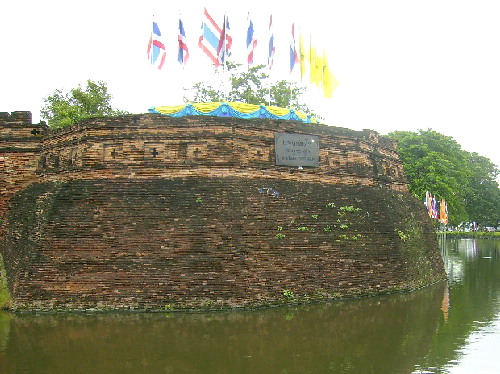
One of the corners of the old city fort knwn as Katam Centre
decided to see the old Chiang Mai City which is just opposite the Lai-Thai Guest House where we had stayed for the last three nights.
The old city was established by King Mengrai and is now 700 years old. To protect the place, the king built a rectangular brick-fortress (1.8 km x 2 km) round it and a moat surrounding the fortress for more protection. Most of the fortress is now gone except the corner walls and the gates. The moat has several fountains which look beautiful at night when coloured lights are switched on.
Wat Chay Mol Muang After walking for a few minutes in the old city, I
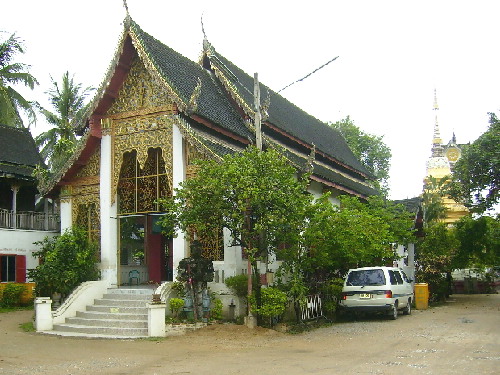
Wat Chay Mol Muang (Phrasing Muang) in the old city of Chiang Mai
came across a small Siamese temple which is known as Wat Chay Mol Muang (Phrasing Muang). It is like any other Siamese temple: a hall that houses a large statue of Buddha, a stupa or chedi at the back, a general purpose hall and living quarters for an abbot and monks.
At 10 a.m. we left the Chiang Mai City for the airport. Then at 11.20 a.m. we flew back to Kuala Lumpur, Malaysia, by Air Asia again.
Why is Chiang Mai a tourists’ favourite destination?
Undoubtedly, Chiang Mai is one of the tourists’ favourite destinations. Its peoples’ friendliness, politeness and hospitality make the tourists feel welcome and happy. Besides, a tourist has no worry of terrorism there as its
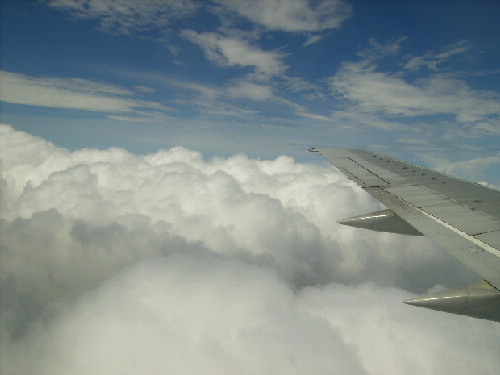
Writer and his tour members flying back to Malaysia from Chiang Mai
people of different ethnic groups and cultures have been living in peaceful coexistence for a long time.
Chiang Mai offers a variety of activities for tourists such as watching animal shows, visiting hill-tribes, rafting, jungle-trekking, shopping at the Night Bazaar, tasting local foods, experiencing the peace and quiet at its beautiful temples and many more. It is not surprising to hear some tourists saying that they have gone to Chiang Mai a few times.
Thank you for reading this travelogue and hope you will make a trip there.
Written by: Choo Chaw, Kluang, Johor, Malaysia
Beijing, Tianjin, Chengde Travel (Part I)
Beijing, Tianjin, Chengde Travel (Part I)
Beijing City
Beijing is the capital of the People’s Republic of China with a large population of 12 million. Located in north-east China, it has a history of 3,000 years and was a capital for six dynasties. Among the dynasties were Jin (1115 – 1234), Yuan (1271 – 1368), Ming (1368 -1644) and Qing (1644 – 1911). They left behind countless historical and cultural sites which are now tourists’ attractions. Beijing is an ideal place to learn about the Chinese ancient imperial past.
Rise in Standard of Living Since China opened its door to foreign investors in the 1980’s, her economy has been growing fast. As a result, wealth has been created and the standard of living of her people has been raised. Now her people can afford to drive expensive cars of local and foreign made, like Toyot
Honda, Mazda, Volvo, etc. Besides, her people can afford to live in high-rise apartments, shop at foreign departmental stores like Carrefour, Giant and Parkson, eat at fast food outlets like Macdonald’s, Pizza Hut and Kentucky Fried Chicken, tour overseas, etc.
The last time I went to China was in June 2005. I went there to see the fast growing economy of Shenzhen City, the beautiful karst landscape near Hezhou City and the spectacular scenery of limestone hills of Quilin City.
From 31 May 2006 to 7 June 2006, I went to China to visit Beijing, Tianjin and Chengde in north-east China and learn their rich histories and cultures.
Below is the itinerary of my travel to some tourist places in China:
Day 1 Air Travel to Beijing City
Day 2 Tiananmen Square,
Forbidden City,
Beijing Underground City
Temple of Heaven
Day 3 Great Wall of China,
Cloisonne Factory
Ming Tombs
Day 4 Beijing Zoo
Summer Palace
Jubao Tang Jewellery Centre
Day 5 Ming City Site Park and Tianjin City
Day 6 Bei Hai Park
Day 7 Mountain Summer Resort of Chengde
Puning Temple
Ya Show Clothing Market
Day 8 Travel Back Air Travel to Beijing
Day 1: Wednesday, 31 May 2006 Air Travel to Beijing City
On the morning of first day of my travel, my wife and I joined eight tourists from my country, Malaysia, and went together with our travel agent to Changi International Airport in Singapore. Then we took a Cathay Pacific Airbus to Hong Kong. On arrival at Hong Kong International Airport, we disembarked and boarded another Cathay Pacific Airbus to continue our journey to our destination, Beijing. We were glad that both flights were smooth.
Chinese Tour Guide and Coach Driver When we arrived at Beijing International Airport in the evening, a young local tour-guide, Mr. Liu. greeted us. Then a coach driven by a local man, Mr. Wu, brought all of us straight to
a brightly-lit Chinese restaurant in the city to taste some Beijing food. As we were very hungry after a long journey we gobbled up the food quickly without any thought for its taste.
Holiday Inn Downtown Beijing After dinner we checked in at a four-star hotel known as Holiday Inn Downtown Beijing. Having taken a shower at the hotel, my wife and I went out and took a walk in a busy street nearby. As we were strolling in the street, we were surprised to see many street-vendors selling pirated VCD’s and DVD’s of the latest American movies such as The Da Vinci Code, X-Men: The Last Stand, The Omen and The Benchwarmers. Later, when we walked back to our hotel, we were surprised to see those vendors standing around without their pirated goods anymore. We guessed some copyright enforcement officers had made their appearance.
Day 2: Thursday, 1 June 2005 Tiananmen Square
After breakfast we headed straight for the largest public square in the world, Tiananmen Square or Gate of Heavenly Peace Square, which is located in the centre of Beijing City.
On the way to the place, we noticed that the quality of the air in the city was poor. The whole city was shrouded in haze and we were worried that the haze would spoil the sceneries of the tourists’ spots in Beijing and other places.
Air Pollution According to Beijing Environment Protection Bureau, air pollution has been a perennial problem in the city. It claims that about 23 % of the city’s pollution is caused by more than 2.6 million vehicles in the streets and the number is growing.
Tiananmen Square Tiananmen Square covers an area of 440,000 sq. metres and can accommodate a million people. It has a political and historical significance to the nation. Many national celebrations and military reviews are held here.
Standing in the centre of the square, one can see the prominent red Tiananmen Gate in the north, both Museum of Chinese History and Museum of Chinese Revolution in the east, Chairman Mao Zedong Mausoleum in the south and Great Hall of the People in the west. In the centre of the square, Monument to the People and Heroes is erected. A large five-star flag, China’s national flag, can be seen flying on a tall staff in the square. It is raised at dawn and lowered at sunset daily.
When we arrived at the Square it was already crowded with both domestic and foreign tourists. Many tour buses could be seen at the Square and countless bicycles near Tiananmen Gate. In tha square there were many peddlers approaching us and other tourists with their goods like kites, maps, postcards and souvenirs.
Chairman Mao Zedong
After snapping a few photos in the Square, we walked to Tiananmen Gate or Gate of Heavenly Peace and saw a large, brightly coloured and almost life-liked portrait of Chairman Mao Zedong hanging high on the Gate.
Chairman Mao was the Chinese communist leader who gained control of China in 1949 from Chinese Nationalist Party (Kuomintang). The latter was forced to retreat to Taiwan Island.
Our tour-guide pointing at the picture of Chairman Mao said, “That portrait is painted by a Chinese professor. He will paint one to replace the old one every year.”
Tiananmen Gate
Tiananmen Gate was built in 1417. It is 3.37 metres high and has a terrace and a tower where one can have a panoramic view of Tiananmen Square. Behind this large Gate is Forbidden City which was the imperial palace of the Ming and Qing Dynasties.
Forbidden City
Forbidden City is the largest and well-preserved palace of ancient wooden architecture in the world. It had been an imperial residence for 24 emperors of the Ming (1368-1644) and Qing (1644-1911) dynasties. It was also a place where the emperors handled the state affairs.
Built in 1406, the 4th. year of the Ming Emperor Yongle’s reign and completed in 1420, it covers an area of 720,000 sq. metres and has 8,707 rooms. It was inaccessible to ordinary people during the emperors’ reigns. In 1925, it was open to public and renamed as “Palace Museum”.
Forbidden City now houses a large collection of fine treasures and about 1 million relics such as arts and crafts, jewelleries, bronze objects, ceramic objects, ancient clocks, furniture, watches and ancient paintings. In 1987, UNESCO designated the place as a World Cultural Heritage.
Tthe Outer Imperial Palace During the emperors’ rule, political activities were held in Hall of Supreme Harmony (Tai He Dian), Hall of Central Harmony (Zhong He Dian) and Hall of Preserved Harmony (Bao He Dian) which are in the outer imperial palace.
Among the three Halls, Hall of Supreme Harmony was the most important one as it was the place where grand ceremonies were held, such as the accession of a new emperor to the throne, the adoption of a new title of a reign, going on an expedition, the emperors’ birthday celebrations, wedding ceremonies and the celebration of the Spring Festival.
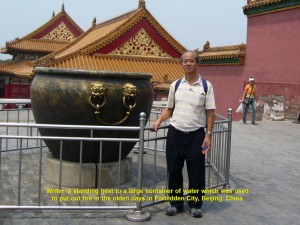
Writer standing next to a large container of water used for putting out fire in Forbidden City, Beijing
The Inner Imperial Palace
The inner palace consists of Hall of Heavenly Purity (Qian Qing Gong), Hall of Union and Peace (Jiao Tai Dian) and Hall of Earthly Tranquility (Kun Ning Gong) where the emperor and his empress resided and handled their daily affairs.
The Imperial Garden
The emperor’s consorts lived in the other six buildings in the east and west of the palace. Located at the back of the palace is the Imperial Garden. In this garden one can see two cypress trees with their branches interlocked symbolizing eternal love. It is said that Puyi and Wanrong, the last emperor and empress of the Qing Dynasty, respectively, had their photo taken in front of the trees after their wedding ceremony and both vowed that “We wish to fly in heaven, two birds with one pair of wings, and to grow together on earth, two trees with branches interlaced.”
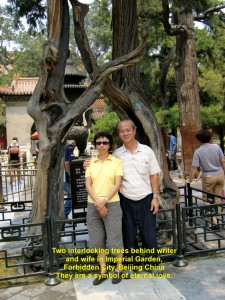
Two interlocking trees(symbol of eternal love) are behind the writer and wife in the Imperial Garden, Forbidden City, Beijing
Pavilion of Imperial Scenery
In the Imperial Garden, stands an artificial hill of rocks which is ten metres high and has a pavilion on its top. It is known as Pavilion of Imperial Scenery (Ju Jing Ting). During the 9th. festival every year, the emperors, empresses and imperial concubines walked up a path to the pavilion to enjoy the surrounding picturesque scenery.
We spent about three hours touring Forbidden City and were all the time being awestruck by its large courtyards and beautiful quaint wooden buildings.
Beijing Underground City
After lunch, we went to a strange place known as Beijing Underground City. This ‘city’ is under a place where old buildings still exist. It has many interconnected underground tunnels. According to our tour guide, the total length of the tunnels is longer than the length of the Great Wall of China. There is a tunnel which runs all the way to Tianjin City. It was supposed to be an escape route for Communist leaders in the event of an attack on Beijing by a foreign country, especially the Russians then.
Underground Bomb-Shelters
When Chairman Mao Zedong had a conflict with Soviet Russia, he ordered underground bomb-shelters to be built in Beijing. Those shelters could accommodate 40% of the population of Beijing and the rest would have to hide in the nearby hills in the event of a Soviet air raid or land attack. The shelters had facilities which included schools, hospitals, theatres, living quarters, factories and stores for arsenal and food. It took twelve years (1967-1979) to complete building the so-called Beijing Underground City.
Qianmen District
To see the ‘underground city, we went to Qianmen District in Beijing and took a short walk along a dirty, dusty and narrow lane to a shop front with a signboard which says “Beijing Underground City” in English and Chinese. The shop front is an entrance to the ‘underground city’.
Dimly-Lit Tunnels
After paying a fee at the entrance, we followed a young guide in a soldier uniform. He brought us round in some of the dimly-lit tunnels which are 8-10 metres below the ground. Each tunnel is about 2.5 metres high and its lower part is between 1.5 and 2 metres wide. It is very cooling but damp inside with a temperature of about 15 degrees Celsius. We had to walk carefully when we came across wet and slippery floor in the tunnel. When we asked the guide about the air-ventilation in the tunnels, he brought us to a place and pointed at a long shaft that went up to the open air outside and could be closed to prevent poisonous gas from entering in the event of an air-raid on Beijing.
Bomb-Shelter Facilities
The guide also showed us an arsenal store, a reading room, a communication room and first aid room. As we were walking behind the guide, we saw old, dirty and blurred black and white pictures of the China Communist military activities of the olden days hanging on the walls of the tunnels. Finally, he brought us to an underground quilt factory where one of our tour members bought a quilt for herself.
Nowadays, many bomb-shelters in Beijing have been converted into shops, theatres, youth hostels, and markets.
Temple of Heaven
After visiting Beijing Underground City, we went south to visit the Temple of Heaven complex. It covers a large area of 2.7 million sq. metres and is the largest temple complex in China. There are 4 main parts of this area: Circular Mound Altar (Yuanqiutan), Echo Wall, Imperial Vault of Heaven (Huangqiongyu) and Hall of Prayer for Good Harvests (Qiniandian). In 1998, UNESCO listed Temple of Heaven as a World Cultural Heritage.
Hall of Prayer for Good Harvests
The most beautiful building in this area is Hall of Prayer for Good Harvests which is a majestic and magnificent ancient temple. It is circular in shape and has three eaves. Its architectural structure is unique. It was built between 1406 and 1420 during the reign of the Ming Emperor Yongle. In this temple, emperors of the Ming and Qing Dynasties offered sacrifices to Heaven and prayed for rain and good harvests.
Inside the temple there are 4 columns in the inner ring that represent 4 seasons, 12 columns in the middle ring that represent 12 months and 12 columns in the outer ring that represent 12 Shichen which is one day. 1 Shichen is equivalent to 2 hours.
Covered Corridor Leading to this stunning temple is a long covered
corridor of 360 metres. While we were walking along this corridor, we were amused to see people involving themselves in a variety of activities such as playing card games, playing Chinese chess, selling souvenirs, singing Chinese folk songs to the accompaniment of ancient musical instruments, drawing, etc.
When we reached Hall of of Prayer for Good Harvests, we looked at it with awe. It is a large, beautiful temple. It looked as though it was new then as it had a new coat of paint. On its wall outside, we were amazed to see thousands of small pictures and intricate designs drawn.
Imperial Vault of Heaven Imperial Vault of Heaven is surrounded by a circular wall known as Echo Wall. If a person whispers close to the latter at any point, his voice can be heard clearly at any other point by another person.
Circular Mound Altar Circular Mound Altar was built in 1530 during the reign of Emperor Jiajing of the Ming Dynasty. It was a place for worshipping Heaven in Winter Solstice, annually. It has 3 layered marble terraces. If a person stands on the Heavenly Centre stone, his voice will sound resonant and sonorous.
Strolling in the Temple of Heaven is quite an awesome experience for me. It was a sacred place for the emperors to worship Heaven which they believed would grant them their wishes.
Acrobatic Show In the evening we went to a Beijing theatre, Spectacular Acrobatic Theatre, and spent an hour watching young men and women performing spectacular acrobatic acts. One of the acts that amazed me was a young man in a horizontal position and being supported by 4 spears. He was a Shaolin disciple.
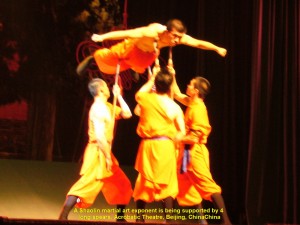
A Shaolin martial art exponent being supported by 4 long spears at Spectacular Acrobatic Theatre, Beijing
Day 3: Friday 2 June 2006 Badaling Great Wall of China
The Great Wall of China After breakfast, we travelled 67 km north of Beijing to Badaling to climb one of the seven wonders of the world, Great Wall of China. In ancient times, it was an important fortress to many kingdoms. According to a Chinese saying, “He who has never been to the Great Wall is not a true man.”
The Great Wall of China was first built in the 7th. Century B.C. by independent kingdoms to keep out the Mongolian invaders in the north. Later, the first emperor of China, Qin Shi Huang, linked many of these walls to protect the northern borders of the states of Qin, Yan and Chao. Subsequently, more walls were built by other emperors. The Great Wall of China now stretches for more than 6,000 km from east to west.
Beijing Jade Carving Factory On the way to Badaling, we
stopped at Beijing Jade Carving Factory. After watching how jade products were painstakingly carved and looking at a variety of readily-made ones which were for sale at the factory, we continued our journey to Badaling in the mountainous region.
The Badaling Great Wall of China When we arrived at Badaling, we were awestriuck to see for the first time in our lives the Great Wall
of China which we had heard so much. It is a brilliant human feat to build such a spectacular long wall of bricks and mortar. It looks like a serpent with a long, slender body moving up and down the mountains. Astronauts claimed that they could see the “serpent” on a clear day from their spacecrafts.
The Great Wall of China at Badaling was built during the Ming Dynasty. It is 7.8m high, 6.5 m thick at the bottom and 5.8 m wide on the top. Five horses or ten people can walk on it abreast. On its top, there are ramparts, embrasures, peep-holes and apertures for archers. Watch-towers for accommodation, storing military equipment and observing enemies’ movements were built at 500 metre intervals.
Climbing the Great Wall
Standing in front of the large Great Wall gate, we noticed that the gradient of the wall on our left was gentle whereas the other one on our right was steep. We all decided to climb the one on our left.
While walking on the wall, we met many tourists from different parts of the world. The wall here was well restored and preserved. Steps were made on steep parts of the wall so that tourists could climb easily. Sometimes, we stopped to see the spectacular, awe-inspiring scenery of the mountains and the long Great Wall.
Stalls on the Wall There were stalls on the Wall selling souvenirs, T-shirts with pictures of the Great Wall and drinks. There were a few other stalls inviting tourists to have their photos taken with their camels or in ancient Chinese clothes for a small fee.
Wall in Disrepair
After walking on the wall for more than a kilometre, we came across a notice that told us not to continue beyond that point. Out of curiosity, I looked beyond it and saw the rest of the Great Wall in bad conditions. Grass and small plants could be seen growing on the ruined wall. So we turned back.
The Steep Climb
When we reached the foot of the mountain, I decided to climb the steeper one. Although it was an arduous climb for me, I was glad that I could make it to the top and felt I was a “true man”.
At 12.30 p.m. we left the Badaling Great Wall for Changping.
Jin Dian Cloisonne Factory, Changping
At Changping which is north-east of Beijing City, we visited a factory known as Jin Dian Cloisonne Factory which manufactured cloisonne products.
Cloisonne is a unique Chinese art. It was originated during the reign of Jintai of Yuan Dynasty. It involves elaborate and complicated processes such as designing, base-hammering, copper-strips in-laying, enamel-filling, enamel-firing, polishing and grilling.
After watching some workers doing the interesting Chinese art and browsing some cloisonne products, we proceeded to a restaurant which is adjacent to the factory for a sumptuous Chinese lunch.
Shi San Ling Crystal Shop We then left the restaurant for
another factory nearby and it is known as Shi San Ling Crystal Shop. It sells crystal products, like spectacles, jewellery, globes and figurines. After spending an hour at the shop, we left for a well-known tourist spot, the Ming Tombs.
The Ming Tombs
The Ming Tombs or the Underground Palace was a burial ground for 13 of the 17 emperors of the Ming Dynasty located in a wide valley of 40 sq. km. to the south of Tianshou Mountain in Changping District, 50 km north-west of Beijing.
Emperor Yongle was the first Ming Emperor to be buried there. So far three tombs, Changling, Dingling and Shaoling have been excavated and Dingling is the only tomb that is open to public.
Dingling was a burial ground for Emperor Shenzong. In the vaulted stone chambers which are about 27 metres below the ground surface, the archaeologists found more than 3,000 artifacts.
When we arrived at the Ming Tombs in the late afternoon, we walked straight to Dingling, where the coffins of Emperor Shenzong and his two wives were found.
When we reached Dingling, we walked down several flights of steps, and went through a short tunnel, the front chamber, the middle chamber and finally to the rear chamber which is 27 metres below the ground.
Box-Like Coffins In the poorly-lit rear chamber, we saw three red, large box-like coffins lying side by side. The middle one which is the biggest belonged to Emperor Shenzong (who died at the age of 58 in 1620) and the other two his wives, Empress Xiaoduan (his first wife) and Empress Xiaojing (his second). We were told that the present coffins are replicas as the original ones were already rotten. Near thr coffins, there were some small boxes containing their belongings. In the middle chamber, there were many displayed cultural artifacts.
We were aware all the time that the underground chambers were poorly-lit. But we were glad that there were many tourists around then, otherwise a few of us would have a cold feeling there.
Bao Su Tang Su-Tech Pharmaceutical Co. Ltd.
In the evening, we gladly left the Ming Tombs and went straight to a pharmaceutical shop known as Bao Su Tang Su-Tech Pharmaceutical Co. Ltd.
When we arrived there, we were invited to a small room where a young and smartly dressed man introduced to us many types of Chinese. He
told us that he would do a demonstration first to prove that Baofuling was an effective cream for treating scorched skin. Before he went for the red hot iron-chain in a corner, we quickly stopped him as we had seen that kind of painful demonstration before in Quilin. He obliged and continued to talk about the usefulness of other types of medicine.
After listening to the talk, a few of us bought some. Then we left the shop for a Chinese restaurant, Da Heng Restaurant, in Beijing City for dinner.
(To continue reading this travelogue, please go to Beijing, Tianjin, Chengde Travel Part II)
Beijing, Tianjin, Chengde Travel (Part II)
Filed under: Chengde Travel II
{(continued from Beijing, Tianjin, Chengde Travel (Part I)}
Beijing, Tianjin, Chengde Travel Part II
Day 4: Saturday, 3 June 2006 Beijing Zoo
On the morning of 3 June 2006, we went to Beijing Zoo. It covers a large area of 86 hectares and claims to have over 7,000 animals from 600 different species, ranging from fish to mammals. The zoo is about 100 years old. Animals from many parts of the world live here, including tigers, polar bears, monkeys, giraffes, rhinos, penguins, kangaroos, elephants, zebras and lions.
On arrival at the zoo in the morning, we went straight to a building to see giant pandas. When we were inside, we felt elated to see three large, dirty giant pandas sitting on the ground in their own enclosures busy eating bamboo plants for their breakfast.
Giant Pandas
Giant pandas are now endangered animals. There are about 1,000 left in the world and half of them are in captivity. Zoo scientists are worried as the population of these animals is decreasing. They are now trying frantically to breed them in the wild and captivity. They have done it with little success as male and female giant pandas are not very cooperative.
After a few minutes of excitement of watching the animals, we left the zoo for a well-known tourist spot in Beijing, Summer Palace.
Summer Palace
Located 15 km north-west of the centre of Beijing, it covers an area of 291 hectares and three quarters of it is lake. It is one of the most charming, splendid and classical gardens in the world.
In the olden days, pleasure-seeking feudal rulers spent their leisure time at the beautiful garden. Later it became an imperial garden during the Ming and Qing Dynasties.
In 1888 Empress Dowager Ci Xi spent a large amount of money which was meant for building a Chinese navy to rebuild the garden. She named it “Park of Nurtured Harmony” but now it is commonly known as “Summer Palace”.
Interesting Attractions
There are many interesting attractions at Summer Palace including the following:
1. Tower of the Fragrance of Buddha sitting on the Hill of Longevity (a three-storeyed octagonal building with a height of 41 metres)
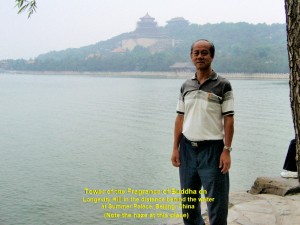
Tower of the Fragrance of Buddha on Longevity Hill in the distance behind the writer, Summer Palace, Beijing, China
2. Hall of Benevolence and Longevity (where Empress Dowager Ci Xi and Emperor Guangxu held court and administered state affairs)
3. The Long Corridor (which is 728 metres long and has 14,000 pictures painted on its ceiling)
4. Seventeen-Arch Bridge (connecting a small island, South Lake Island, in Kunming Lake to the land, 150 metres long and having 544 different small stone lions on its balustrades)
5. Marble Boat (which is 36 metres long and has a hull and upper deck)
6. Wenchang Tower(a two-storeyed building housing the bronze statue of the God of Literary Prosperity)
7. Heralding Spring Pavilion (an ideal place to appreciate the scenic landscape of Kunming Lake and the Longevity Hill)
8. Hall of Happiness in Longevity (Empress Dowager Ci Xi’s residential quarters)
9. Glowing Clouds and Holyland Archway (standing by the Kunming Lake to dispel clouds)
10. Hall of Dispelling Clouds
An Emperors’ Retreat
Summer Palace which has many beautiful buildings, tree-covered hills and a splendid lake (Kunming Lake) was obviously a retreat for the emperors of China who wanted to escape from the scorching summer heat of Beijing.
Now Summer Palace is a popular place for local people who go there for their recreational activities such as folk and modern dancing, singing, playing Chinese ancient musical instruments, using water and big brushes to write Chinese characters on cemented ground, performing tai-chi and qi gong and playing Chinese chess and cards. Others like to spend their time mingling with the tourists.
In 1998, UNESCO designated Summer Palace as a World Cultural Heritage.
A Tour
At Summer Palace, we spent a few hours strolling and enjoying the scenic views of the Kunming Lake, hills, temples and quaint buildings. We took a ride in a colourful boat at Kunming Lake from a jetty near Gate That Dispels The Clouds to a small island known as South Lake Island and then walked across Seventeen Arch Bridge to Heralding Spring Pavilion . At the pavilion, we were entertained by a group of Chinese musicians and singers.
After touring the large, pristine Summer Palace, we left for a pearl-jewellery shop known as Jubao Tang Jewellery Centre in Beijing.
Jubao Tang Jewellery Centre, Beijing
When we arrived at a pearl factory, Jubao Tang Jewellery Centre in Beijing, we were ushered into a room. Then we were shown a tray of live freshwater oysters. As a worker was prising an oyster, she asked us to guess the number of pearls it had produced. We were
astonished when she opened it and counted 28 little pearls in it. None of us got the answer right. Then she told us that pearls can be produced in many colours by giving oysters different kinds of food. After that interesting oyster lesson we moved on to a larger room where all kinds of pearl-jewellery were displayed in showcases. We were persuaded by salesgirls and salesmen to buy them. Some of us bought the inexpensive ones.
Tai Ping Underwater World
The next place we went to was a small aquarium in Hai Dian District known as Tai Ping Underwater World. Arriving at the aquarium, we noticed that it is under a tall telecommunication tower. We went inside to see the fish but were disappointed as there were not many exotic fish there. But we were pleasantly surprised to see a little, pretty lady in red mermaid costume swimming slowly in a large aquarium.
Later, we went into a small crowded room to watch a seal performing an entertaining solo show which lasted for about 10 minutes.
Dr. Tea
After the seal show we left for a tea shop known as Dr. Tea. It is located at No. 1, Min Zu Yuan Road, Chaoyang District, Beijing. In the shop we were introduced to many kinds of tea, such as jasmine tea, ‘The King of Oolong Tea’, wild ‘puer’ tea, ‘tian qi’ flower and black tea. We tasted some of them and were told that each kind of tea could cure a specific ailment.
Garden of Chinese Ethnic Minorities
Near the tea-shop is a large area where 16 Chinese ethnic minorities’ architectural buildings are built in the same scale as the normal ones. This area is known as the Garden of Chinese Ethnic Minorities. It is a showcase of 16 Chinese ethnic minorities’ traditions, customs and cultures. Ethnic festival activities, dancing and singing performances, handicraft-making, cuisine-tasting and many more are held here. Owing to time constraint, we missed that place.
Day 5: Sunday, 4 June 2006 Min City Site Park
On the morning of 4 June 2006, we visited Min City Site Park in the Beijing suburb. At this park, there is a 1.5 km long Beijing City Great Wall. It is the remainder of the 40 km city great wall which was built during the Ming Dynasty to protect the city. This short great wall is 8.2 metres high and has a large tower known as Corner Tower. In this tower, there are four flours. The first and fourth flours house modern paintings and sculptures by outstanding young Chinese artists and sculptors whereas the third floor shows the history, politics, economy and cultures of the Chongmen District since Qin and Han Dynasties.
In 1916, an arch which is 7.4 metres high and 9.5 metres wide was built in the great wall near the tower at the park. It was built for the round-the-capital railway. Now the line is not there anymore.
After visiting the park, we moved on to Tianjin which is 137 km south-east of Beijing.
Tianjin
Tianjin known as “The Diamond of the Bohai Gulf” is the 3rd. largest city in China. It is one of the biggest industrial and port cities in China and the closest seaport to Beijing. It has a population of about 10 million.
The coach journey from Beijing to Tianjin took about two hours as the traffic on the road was heavy. Our purpose of going to Tianjin was to taste the famous Tianjin’s steamed dumplings known as “Gou Bu Li” dumplings and visit Ancient Food Street and Culture Street.
“Gou Bu Li” Dumplings
On arrival at Tianjin, we went straight to a restaurant to taste the famous “Gou Bu Li” dumplings (‘Gou Bu Li’ literally means ‘Dogs Ignore’). They are small white dumplings stuffed with little meat and green leafy vegetables. We ate a few different types but found that there was nothing special about them.
Why are Tianjin’s steamed dumplings called “Gou Bu Li”? We were told that about 120 years ago there was a man selling steamed dumplings. His customers liked to call him “Gou Bu Li”, his childhood’s name. Soon his dumplings were also known as “Gou Bu Li” dumplings. That is how the famous Tianjin’s dumplings get the name.
Ancient Food Street
After a meal of dumplings, we went to Ancient Food Street where there is a large building with its front built in ancient Chinese architectural style and a pair of guardian lions at its entrance. It houses many stalls which sell a variety of snacks, cooked meats, preserved fruits, nuts, souvenirs, arts, handicrafts, etc. on the ground floor and Chinese restaurants on the first flour.
Ancient Culture Street
Later we went to a well-known place in Tianjin called Ancient Culture Street which is located in the north-eastern part of the old city of Tianjin. Two and three storey buildings built in ancient Chinese architectural style line the street. They sell a wide variety of Chinese arts and handicrafts, antiques, souvenirs, Chinese brushes of all sizes, etc.
Tianhou Palace
Situated near Ancient Culture Street is the oldest building in Tianjin known as Tianhou Palace (built in 1326). Local people prayed to the Goddess of the Sea to bless the seafarers of Tianjin at that place. Later, in 1984, it became a museum. Since then it showcases the history, customs and traditions of Tianjin
In the late afternoon, we returned to Beijing.
Day 6: Monday 5 June 2006 Beijing Hutong
On the morning of 5 June 2006, we visited the Hutong in the centre of Beijing City. Literally, “hutong” in Chinese means small lanes or alleys. But the Hutong is actually an old residential place where houses are built around courtyards and has a maze of small lanes. Many hutongs in Beijing have been demolished and replaced by modern high-rise buildings and apartments.
A Hutong Visit
The Hutong we went to is sandwiched between a lake (Hihai, Houhai and Qianhai) in the north and another lake, Beihai, in the south. When we arrived there, we were astonished to see a long row of trishaws parked on one side of a busy road waiting for tourists. My wife and I sat on one them. When all the members of my tour group were seated in their trishaws, the trishawmen started to tour the Hutong. As the Hutong lanes are narrow, trishaws have to move in a single file.
A Bumpy Ride
It was a bumpy ride at the Hutong as the road surface was uneven. Sometimes we were thrown to one side when our trishawman avoided an oncoming trishaw or negotiating a sharp corner. I would say that the ride was very uncomfortable.
Passing through the place, we managed to get quick glimpses at the Hutong where the old, small grey brick-houses were built close to each other. There are a few more interesting attractions in this area, such as the Bell and Drum Tower, Prince Gong’s Residence and Mei Lanfang Memorial Hall.
The trishawmen finally brought us all back to the place where we had started. Then we walked across a busy road, Di’anmen Xi Dajie, to a beautiful garden known as Beihai Park.
Beihai Park
Located in the heart of Beijing, Beihai Park is well-known for its Jade Islet, Beihai Lake and White Dagoba.
White Dagoba
White Dagoba is 35.9 metres high and built on Jade Islet as a memorial to the Dalai Lama’s visit in 1651. Adjacent to White Dagoba is Circular City. It is a ‘small city’ in the city proper of Beijing. Hall of Receiving Light is in the Circular City centre where an 800-year-old pine tree is growing.
Nine Dragon Screen
Beihai Park which is a classical garden with pavilions, halls, temples and covered corridors was an imperial garden. It has a beautiful wall known as Nine Dragon Screen. Both sides of the wall are artistically decorated with 9 large flying dragons chasing fiery large pearls on each side. Besides, the wall has 635 small dragons. It is 5.96 m high, 1.6 m thick and 25.52 m long and was constructed in 1756. It required 4,247 coloured-glazed tiles to make this masterpiece. It is the only kind which has both sides of the wall decorated in China.
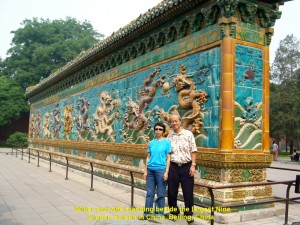
The largest nine-dragon screen or wall behind writer and wife in China is at Beihai Park, Beijing, China
A Recreational Park
Beihai Park is a popular recreational place for local people. They spend their leisure time doing relaxing recreational activities, like folk and modern dances, water-calligraphy on cemented pathway, tai-chi, Chinese chess game, singing and sword practice.
Muslim Food
After strolling at the beautiful pristine Beihai Park, we left for Chengde. On the way, we stopped for lunch at a small Muslim restaurant known as Sai La Ma Can Ting along Ju Xiang Qiao Road. Entering the restaurant, we were surprised to see 28 tourists from our own country, Malaysia, having lunch. “It’s a small world,” we said to each other. After exchanging greetings, we settled down to have our own meals.
Journey to Chengde
Then we continued our journey to Chengde which is 230 km north-east of Beijing . In the middle of the journey, we saw ruined Great Wall of China on the hills in the distance. After travelling for 4 hours on the busy highway, we finally reached the city in the evening. It was covered with haze. We had dinner at a restaurant at Qian Yang Grand Hotel, 18, Pule Road, Chengde. After dinner. we checked in at the three-star hotel, Qian Yang Grand Hotel and looked forward to a tour in Chengde on the following day.
Day 7 : Tuesday 6 June 2006 Chengde
Chengde with a population of 3.4 million is known as “The Pearl Outside the Great Wall”. A wide river, Pule River, flows through the city from north to south. When we were there, we saw little water flowing in the river due to a long period of drought.
Mountain Summer Resort of Chengde
On the morning of 6 June 2006, we had breakfast at the Qiang Yang Great Hotel restaurant. I could not eat much as the dishes given to us were cold.
After breakfast, we went to a famous imperial resort in Chengde known as Mountain Summer Resort. When we arrived there, our local tour-guide, Miss Chang, brought us round to see the important spots of the resort.
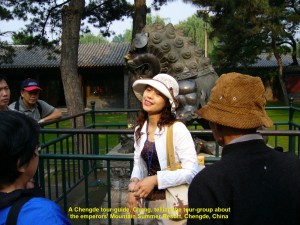
Chengde tour-guide, Chang, talking about the Mountain Summer Palace to the tour-group, Chengde, China
The Largest Imperial Garden
Located in the northern part of Chengde City, Mountain Summer Resort is the largest imperial garden in China. It has 10 km wall round it and covers a large area of 5.64 sq. km. which is twice as big as Summer Palace in Beijing. The Qing emperors, Kangxi and Qianlong, took 89 years (1703-1792) to build the resort.
Grand palaces, temples, pagodas and pavilions were built all over the resort. The resort has a dense forest where lots of animals once roamed in the north and a large grassland where many reindeer once grazed in the north-east. Nowadays, a few tame reindeer can be seen roaming freely in the resort. In the olden days, the forest and the grassland were the emperors’ favourite hunting grounds.
In this resort, a large wooden building known as Hall of Frugality and Simplicity (Dan Bo Jing Cheng) which was built in 1711 was an important place where the emperors handled state affairs and held grand ceremonies during their vacation there. This building is now closed but tourists can peep inside through glass-covered doors and windows. Surprisingly, some Chinese money notes can be seen stuck in the gaps of doors and windows. Some tourists must have done hoping to be blessed by the spirits of the dead emperors.
Treaty of Beijing in 1860
Another large quaint wooden building, Hall of Refreshing Mists and Waves (Yan Bo Zhi Shuang), which was also built in 1711, was the emperors’ residence. It was in that building where Emperor Xianfeng signed the Treaty of Beijing in 1860 which forced China to give up South Kowloon to Britain and a large territory north of Heilongjiang River and east of Wusulijiang River to Russia.
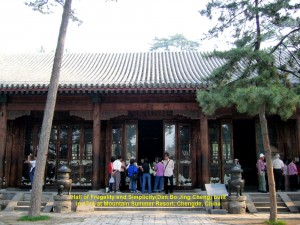
Hall of Frugality and Simplicity where Treaty of Beijing was signed in 1860, Mountain Summer Resort, Chengde, China
The most beautiful and romantic spot in the resort is the scenic lake garden in the south-east. A stroll in the garden where there are buildings and pavilions in splendid ancient Chinese architectural style, stone bridges built across the lake, lotus flowers growing in the lake and coloured fish swimming in the water will definitely
make a tourist feel relaxed and refreshed. No wonder, Emperor Qianlong and Emperor Kangxi liked to stay at the resort during summer for about half a year annually.
To go round the large resort, we took a nine-seater electric-powered vehicle ride. It brought us to a few popular spots in the resort.
After touring the picturesque, pristine resort, we went to another place near Mountain Summer Resort where there is a well-known
temple in Chengde City, Temple of General Peace or commonly known as Puning Temple.
Puning Temple
Puning Temple was built in 1755 by Emperor Qianlong during the Qing Dynasty. It was built in the same architectural style as that of the Tibetan Sanmoye Temple. There are many other buildings in this area of 33,000 sq. metres, such as Bell and Drum Towers, Pavilions, Hall of the Heavenly Kings, Temple of Universal Blessing and Protection and Temple of Universal Peace.
Temple of Universal Peace
Among the buildings, Temple of Universal Peace is the largest. It houses the world’s largest wood-carved Buddha statue. It has a height of 22.3 metres and width 15 metres. Unlike other statues of Buddha, this large one has a thousand hands and a thousand eyes. Ironically, the people of Chengde call the figure “The Goddess of Mercy (Guanyin) with a Thousand hands and Thousand eyes”. We saw many worshippers praying to the deities and Buddha and some lamas playing ancient musical instruments in front of that large temple.
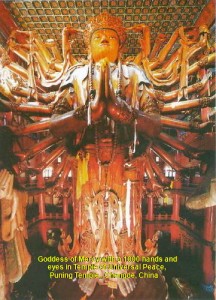
Goddess of Mercy with 1000 hands and eyes in Temple of Universal Peace, Puning Temple, Chengde, China
Hall of the Heavenly Kings houses four large statues of warriors, namely East Chiguo, South Zengshang, West Guangmu and North Duowen.
A tour at this sacred place, Puning Temple, teaches us a significant part of the local tradition and culture.
Life of Lord Buddha
Adjacent to the temple is a wall with colourful pictures depicting the life of Lord Buddha. After this wall is an entrance to a mini cultural village which has a lane with single-storey shops on both sides. The shops built in the Qing architectural style sell all kinds of souvenirs, Chinese paintings, crystal and jade products, post-cards, etc.
Later we left that sacred place and returned to Beijing.
Ya Show Clothing Market
On arrival at Beijing we went straight to a large departmental store known as Ya Show Clothing Market in Gong Ti Bei Street. It is a place where one can buy anything one wants : goods ranging from belts, shoes, clothes and handbags to watches, digital cameras, MP4, thumb-drives and picture-cards of 2 gigabytes.
Most of the vendors here will set their goods at prices that are astronomically high. It is advisible for a buyer to reduce their prices to between one third and one quarter before purchasing them. Buyers are forewarned that most of the goods here are not genuine ones.
After buying some goods at bargain prices, we left for a restaurant where we had Siamese food for dinner. While having dinner, we were entertained by young singers who performed a Siamese and then a native dance on a small stage.
Wangfujing Street (Wangfujing Da Jie)
After dinner we went to a popular tourists’ street known as Wangfujing Da Jie in Beijing City. It is about 1 km long. Along this busy street are several large shopping complexes which (our tour guide claimed) sell genuine branded goods. Among them are Sung Dong An Plaza, Beijing Departmental Store, Beijing Arts and Crafts Shop and Shidu Emporium. The former is the largest shopping mall in Beijing.
Eastern Church or Wang Fujing Catholic Church
While walking down the street to Sung Dong An Plaza, we saw a catholic church known as Eastern Church or Wang Fujing Catholic Church. We were surprised to see it as it was the first church we saw in Beijing after so many days of stay in the city.
Dong Hua Men Night Market Street
Then we walked to another street nearby, Donganmen Da Jie, and were attracted by a row of about 90 small, brightly-lit stalls on its right side. This place is a tourist attraction to both domestic and foreign tourists alike. It is known as Dong Hua Men Night Market and was opened in 1984.
Strange Snacks
As we walked from stall to stall at the night market, we saw, besides noodles, buns and drinks, strange snacks for sale. Among them were dead scorpions, centipedes, grasshoppers, cockroaches, garden snails, sea-horses, star-fish and beetles which were properly skewed. The vendors would grill them if there were buyers.
Looking at those skewed creatures made my stomach churn with nausea. But I was astonished to see some people enjoying eating them.
After visiting the shopping centres and and night market we went back to our hotel.
Day 8: Wednesday 7 June 2006 Travel Back Home (Malaysia)
As we had to catch an early morning flight home we woke up early and left the hotel, Holiday Inn Downtown Beijing, at 5.15 a.m. with a packet of breakfast each given by the hotel. When we arrived at the Beijing International Airport, we sadly bid farewell to our Chinese tour guide, Mr. Liu, and coach-driver, Mr. Wu, who had made our six day tour in Beijing, Tianjin and Chengde an unforgettable one.
After several hours of travel we finally arrived in our country, Malaysia, in the evening. We were glad that the air flight was trouble-free and safe.
Chinese Legendary Creatures
Below are some of the photos of the Chinese legendary creatures I have taken during the Beijing Tour. Each of them has a special meaning to the Chinese beliefs.
Chinese Dragon
This four-legged legendary animal has a long, scaly body and a pair of deer’s antlers.
To the Chinese, the dragon brings wealth, prosperity and good fortune. They are held in high regards for its dignity and power for good.
Chinese Phoenix
It is a feathered creature with a cock’s peak, a swallow’s face, fowl’s forehead, a snake’s neck, goose’s breast, tortoise’s back, stag’s hindquarters and fish’s tail.
It is a symbol of high virtue and grace. The Chinese consider a pair of dragon and phoenix as a symbol of a blissful relationship between husband and wife.
Kylin or Qilin
This bronze statue of a mythical creature known as kylin or qilin was made in the Qianlong’s reign. It is a strange-looking creature as it has a dragon’s head, a pair of deer’s antlers, lion’s tail, scaly body and ox’s hooves.
The Qing believed that it had power to punish the evil and and keep away the wicked.
Chinese Lion
This is another mythical animal which has a face of a dog.
Lion and lioness are commonly found in pair at the entrance to imperial palaces, government buildings, restaurants, banks, temples, and other important buildings in China.
A lion has a sphere under the paw of his right fore-leg while a lioness has a cub under the paw of her left fore-leg. Symbolically, the male guards the building while the female protects the property and people inside. Besides, the Chinese believe that the lions can ward off evil and bring wealth and prosperity to the owners of the buildings.
Thank you for reading my Beijing Travel and hope you have enjoyed it.
Written by: Choo Chaw, Kluang, Johor, Malaysia
Shenzhen, Hezhou, Quilin, Zhaoqing Travel (Part II)
Quilin City Located in the north-east of Guangxi Zhang Autonomous Region, Quilin has a population of
650,000. Its main economic activity revolves around industries including medicine, foodstuff, cars, electronics and many more. It is well connected by roads, railways and air with other cities in China.
Quilin is a famous ancient city with a history of over 2,000 years. It is an enchanting place and known worldwide for its scenic spots like green hills, splendid rivers, grotesque caves and exquisite rocks. Quilin in Chinese means ‘osmanthus forest’ as there are many osmanthus trees around the city. River Li or Lijiang flowing from north to south cuts the city into halves and is joined by another river, River Peach Blossom (River Taohua ), in the middle of the city.
Scenic Spots Quilin’s beautiful scenic spots attract many
dignitaries and tourists from home and abroad. The popular scenic spots are:
Elephant Hill (Xiang Bi Shan), Camel Hill, Tunnel Hill, Folded-Brocade Hill, Wave-Subduing Hill, The Hill of Unique Beauty, The Pierced Hill Park (Chuanshan Hill), Flute Cave, Banyan Lake and Fir Lake, Fubo Park (Whirlpool Hill), Diecai Park, Xishan Park, Nanxi Park Seven Star Park and the list can go on and on.
Besides the landmarks, Quilin offers many activities such as boat cruises on River Li, cycling in the countryside, learning Chinese
painting and taking photographs of beautiful scenery of the countryside, mountain-climbing, canoeing, and many more.
Pierced Hill Park After breakfast at City Garden Hotel in Quilin, we went to Pierced Hill Park (Chuanshan Park) in the south-east of Quilin. The hill has a round hole in its middle and it looks as though it has been pierced, hence its name. The hole resembles a moon if it is seen from a distance. Near this hill is a smaller one called Ta hill (Pagoda Hill). On top of it is a pagoda built in the Ming Dynasty.
Flowing in between these two hills is a small river called Xiaodongjiang (Little Eastern River). The reflection of the two hills in the river is fascinating.
At the foot of Pierced Hill, there is a huge bronze bell which weighs 2,624 kg and has a height of 2.5 metres. It was made in the eighth year of the Kangxi Period of the Qing Dynasty.
Dong (Cave) Nationality We climbed up the steps of the steep Pierced Hill and entered a cave to watch pretty native girls of the
Dong (Cave) nationality performing their traditional dances and at the same time singing their native songs. They even asked some tourists to perform a mock marriage ceremony with them and do the bamboo dance.
Li River (Lijiang) After watching that short and entertaining performance, we climbed to the top of the hill (about 75 metres high). Standing on its top, one can have an absolutely breathtaking 360 degree panoramic view of Quilin City with limestone hills surrounding it and the green Li River (Lijiang) flowing through it.
Then we came down the hill and strolled at the beautiful park by the
Li River. Three black statues of China’s important figures under a tree caught my eyes. I stood with them and asked someone to snap a photo for me.
I saw a man on a bamboo-raft on the Li River using a long net to catch fish. After throwing the net into the water a few times, he did not land in any fish. It was his unlucky day.
More Hills Then we visited two more hills which are nearby: Fubo Hill (Whirlpool Hill) and Xiangbi Hill (Elephant Trunk Hill). One can
walk up to the top of the former and have a good view of Quilin City. Inside its cave, some Buddha statues and frescoes dated from the Tang and Song dynasties can be seen. The Elephant Trunk Hill has a shape of an elephant with its trunk extending into Lijiang River (River Li), hence the name of the hill.
Dibao Silk Products Co. Ltd. The next place we visited was a silk factory called Dibao Silk Products Co. Ltd. in Quilin. Arriving there, we watched female workers making quilts from silk. Besides quilts, this factory sells a variety of silk clothes.
Later we went to Chuanshan Road to visit a famous Chinese tea-shop to taste more than five types of tea. The employees claim that Chinese tea is good for health and longevity. In the shop we were surprised to see, hanging on the wall, big photos of Mr. Clinton (the ex-president of U.S.A.) and his family drinking Chinese tea in the shop.
Banyan Lake (Ronghu) and Fir Lake (Shanhu) After lunch we headed straight for a large garden in the Quilin downtown where two
lakes, Banyan Lake (Ronghu) and Fir Lake (Shanhu) are connected to each other. The lakes were a part of the Quilin city moat during the Tang Dynasty. There are some small islands in the lakes which are linked by zigzag-bridges. One part of a bridge is made of glass and has a beautiful, romantic glass-shelter. Standing tall at Banyan Lake, are two beautiful pagodas, one gold in colour and the other silver. There are many shady trees around the lakes and a few of them are more than 1,000 years old. It is a good place for relaxation and exercise. Local people like to gather here to play card games and Chinese chess under
shady trees. At this park, it is a common sight to see poor boys and girls persistently asking tourists to buy flowers.
This clean and tranquil place and a certain part of Quilin city were once surrounded by a high wall to protect the inhabitants against enemies’ attacks in ancient times. Now, most of the wall has been demolished and cleared for roads and buildings. A gate of the
fortress still remains near the lakes and it is called the Southern City Gate (Gunanmen).
Beijing Baoshutang Pharmacertical Company After strolling round the two lakes in Quilin City, we went to a Chinese medicine company, Beijing Baoshutang Pharmacertical Company, along Long Ying Road. It boasts of many kinds of medicine which can treat health problems ranging from eczemas , rheumatism, impotence to diabetes mellitus and complications of cardio-cranial vascular disease. Quite a mouthful!
Once inside the shop, we were invited to watch a demonstration by a young, pretty lady. Before she touched a red hot iron chain, I could see her frightened facial expression (or was she acting?). When her assistant brought the red hot chain to her, she touched it quickly and there was a cry of horror from all of us. Then she showed us the red patch on her palm and stretched her hand to her assistant who applied a white cream on the scorched area on her palm. After that she introduced the cream, Baofuling, to us. She told us that the cream can also be used for treating other skin problems. After introducing many kinds of medicine to us, she happily raised her
right hand and asked us to look at the palm which had earlier touched the red hot chain. The red patch had surprisingly disappeared. A few tourists who were convinced that the cream was magical bought it.
Dreamlike Lijiang Theatre In the evening after dinner, we went to a big theatre known as Dreamlike Lijiang Theatre to watch “New Ballet Circus Show”. I was surprised to see many busloads of tourists going there to watch the show. When we were inside the large theatre, we could see that it was fully packed.
We were treated to a variety of splendid performances in the theatre. Most of the performers were young. They did ballet, exotic dances, acrobatic acts, rotating saucer dance, some circus acts, silly acts by clowns and many more. The continuous change of coloured lights made the show more colourful and exciting. It was indeed a stunning show.
Night Market along Zhongshan Road At about 9 p.m. I came out of my hotel and walked alone along Zhongshan Road. I was attracted by a brightly-lit spot down the road. When I reached
there, I saw hundreds of temporary stalls selling intricate embroidery works, Chinese paintings, antiques, ornamental stones, apparels, bamboo, wooden and jade sculptures, jewelleries and many more. There were a few stalls where customers’ portraits could be drawn on the spot and done in 15 minutes by male and female artists.
That night-market was purposely organized to attract tourists from home and abroad. After browsing all the stalls, I walked back to the
hotel. On the way, I had an unpleasant encounter. I was stopped a few times by young Chinese men and ladies who told me that they could get me beautiful girls. But I politely declined their offers.
Day 5: Friday 3 June 2005 Quilin City (Last Day)
During our last day in Quilin City, we visited a few more places there. Among them were as follows:
Yushan Park After breakfast, we left City Garden Hotel and
headed for a beautiful park in Quilin City, Yushan Park. It looks like a Victorian garden with beautiful flowers, a big fountain and cascading water. Besides, it has a huge green peacock shaped from a cluster of plants, and a smaller peacock, a big mushroom and a few elephants all made of thousands of small, colourful medicine-bottles. All these figures are fascinating to look at. A big, old banyan tree which is more than 1,000 years old is still growing at the park.
After lunch at 12.30 p.m., we went to visit a famous Chinese painter who works at a Chinese temple-like building . He is very good at calligraphy and Chinese painting. His beautiful works are hung on the walls for sale.
Jingjiang Princes’ City Then we went to visit a historical place, Jingjiang Princes’ City. It was built in A.D. 1372 during the Ming Dynasty. It was occupied by the princes and their families. Some of
them later became emperors like Emperor Zhao Gou, Emperor Shun and Emperor Tuohuan Tiemuer. 14 Jingjiang princes of 11 generations had lived there. It is the best preserved princes’ city in China even though it had been burned down several times.
Western Hill Park (Xishan Park) The last visit in Quilin was Western Hill Park (Xishan Park). The park is located near Li Jun Road. 200 Buddha statues dating from the Tang Dynasty can be found on the hill. On a slope of the hill stands a big rock which is in the shape of a
dragon head. At the foot of the hill, there is a green calm lake, Xishan Lake, which reflects the beautiful surrounding scenery.
By the Xishan Lake, we saw a pretty young lady playing a Chinese classical music on a stringed instrument called ‘guzheng’. We crowded around her and listened with enthusiasm.
Yangshuo Our next destination was the City of Yangshuo, a small city situated 65 km south of Quilin. It has a population of 300,000. Like Quilin, its unique hills, grotesque caves and winding rivers attract many tourists from home and abroad.
When we arrived at Yangshuo in the late afternoon, we checked in at a three-star hotel called Baofeng Hotel.
Day 5: Friday 3 June 2005 Li River Boat Cruise
Li River Cruise Boat In the evening, we went to Li River for a boat cruise. We boarded a long, broad double-decker boat at a jetty. To get a panoramic view of the scenery, most us went up to the upper deck of the boat. Soon the boat moved upstream. After moving for a short distance it stopped in the middle of the river. Then a bamboo raft
rowed by a man in Chinese trditional clothes and carrying a pretty young damsel in her colourful native dress came and stopped near our boat. Then the lady serenaded a few folk songs to us. Our tour guide courageously serenaded to her for awhile.
Animal Figures After that, our boat continued cruising upstream. As it moved, we were brought to the attention of unique hills near and far by the boat-commentator. She told us that some hills resembled figures like a dragon’s head, horses, rams, etc.
Besides the spectacular scenery of the limestone hills, we saw some activities in the river such as children and adults swimming in the big river, and large, black water-buffaloes bathing in the water. Tourists will be surprised to see toilets built above the water of the river.
Cormorants (Fish Catchers) When night fell, our boat stopped in the middle of the river. Then we watched a fisherman in his small boat commanding his black birds, cormorants, to catch fish in the river. He directed a brightly lit lamp onto the water. The obedient
ones dived into the swift-flowing water. The stubborn ones were gently pushed into the water by the man. When the birds surfaced a few times without any fish, we laughed. Minutes passed. Then one after another surfaced with a big fish inside its beak. The owner happily extended a pole to the birds in the water so that they could easily get onto his boat. Holding a bird at a time, he pulled the fish out of the bird’s beak. All of us on the cruise-boat were very impressed. We cheered and applauded the birds for their amazing skill.
Day 5 : Friday 3 June 2005 West Street (Yangshuo)
In the evening, we went downtown of Yangshuo and strolled along the famous street, West Street. It is bustling with life with an ambience of a carnival. It is popular among local residents and foreign tourists. Shops along this narrow street sell all kinds of souvenirs, colourful clothes, Chinese paintings, CDs, DVDs, fruits, native handicrafts, foot-wear, snacks, beer, etc. You name it, they have it.
Our Tour Guide’s Warning We were forewarned by our tour guide to reduce their offered selling prices for goods as much as we can. A
smart lady in our tour group managed to reduce the selling price of a Chinese painting from RMB 280 to RMB 100! A big discount of 64 %!
Shops with Foreign Names Surprisingly, some shops uses foreign names, like Lisa’s Cafe, Hard Rock Cafe and Mickey Mao’s. To keep up to their shops’ names they serve western food and drinks like beef-steak, French fries, apple pies, beer, wines and ice-cream sundaes. One will not feel faraway from home here as there are
shops which provide Internet services. If you have a lot of time on your hand, you may go to a secondhand book shop to rent and read an English, French or other foreign novel. It also buys and sells secondhand books of any languages.
Day 6: Saturday 4 June 2005 Travel to Zhaoqing City
In the morning, we left Yangshuo for Zhaoqing in Quangdong Province. On the way, it was raining slightly. As we were travelling, we saw more limestone hills near and far. With a little bit of
imagination we could see some hills resembling animals, fruits and human beings. There are paddy fields, vegetable farms and orchards along the way to Zhaoqing. The road to Zhaoqing was wet, bumpy and narrow. We could see an expressway to Zhaoqing City under construction. Besides, we saw rivers swollen with yellow water due to heavy rain and erosion in the interior where deforestation had taken place.
West River (Xi Jiang) Before reaching Zhaoqing, we were travelling along a road which is parallel to China’s third largest river, West River (Xi Jiang). Small and big boats carrying sand, stones, logs,
mineral ores and other heavy goods can be seen moving on the river. They are plying between cities along the large river. Finally, we arrived at Zhaoqing City. We checked in at a five-star hotel, Hua Qiao Hotel, along Tian Ning North Road, a busy street in the centre of the city.
Musical Fountains After dinner, we walked in the light rain to Star Lake nearby and watched musical fountains dancing to the tunes of loud musics. The colourful lights made the fountains dance more lively. At the same time, there was a concert on a big stage
near the musical fountains. The place was so crowded that it was difficult for us to enjoy watching either the musical fountains or the concert. So we left the place and went to browse at the brightly-lit shops along a busy street.
Day 7 : Sunday 5 June 2005 Zhaoqing City Tour
Justice Bao Memorial Hall At 8 a.m. we left Hua Qiao Hotel and went to visit Justice Bao Memorial Hall which was built in the style
of a traditional Chinese temple. In 1056 during the Song Dynasty (960 -1729), the Emperor of China appointed a Mr. Bao to be in charge of administering the Emperor’s regulations in Kai Feng Prefecture. The administrator, Bao Gong (Justice Bao) as he was commonly called, was allowed to use a head-cutter to cut off the heads of criminals before reporting to the Emperor. In other words, he was given the authority to make decisions on the spot.
Head-Cutters In the hall, there are three models of head-cutters. The dragon head-cutter was used to execute royal members who
committed crimes, the tiger head-cutter was used to execute corrupt officials and the dog head-cutter was used to execute evil gentry and local tyrants. There are two halls there, each has a big statue of Justice Bao. The place is considered a holy shrine of Justice Bao. People from near and far go there to worship the famous judge.
Star Lake Boat Cruise Later, we went to Star Lake to enjoy a boat cruise on the lake which is shaped like a star; hence its name. Located in the suburb of Zhaoging City and made up of two scenic spots, viz. Seven-Star Stone Hills and Dinghu Mountain, this lake is
a popular place for dragon-boat races. We saw some young people training hard at canoeing for the 2008 Olympic Games which will be held in Beijing.
Day 7: Sunday 5 June 2005 Back to Shenzhen City
Red Forest Park After an early lunch at 11 a.m. in Zhaoqing, we travelled back to Shenzhen City. It was cloudy and hazy all the way. On arrival at Shenzhen City, 3 and a half hours later, we went straight to a park, Red Forest Park, by the sea. It is a clean place where shady trees and grass are well kept there. Breeze from the sea
continuously brings in fresh air to the park. As it was Sunday, many people were strolling and relaxing at the park.
Windows of the World After a few minutes of refreshing and relaxing walk at the Red Forest Park, we went to a famous theme park, Windows of the World, at Overseas Chinese Town in Shenzhen City. It is a large area where one can see more than 100 miniature replicas including seven wonders of the world, world famous monuments, arches, cathedrals, temples, and many more. Some people say that If one can see all these replicas in one day there, one does not have to travel round the world to see the real ones.
“Oriental Dress” Show Having seen some of the replicas at the “Windows of the World” Park, we hurriedly went to Central Theatre to watch a 5 p.m. splendid show called “Oriental Dress”. In the show, the audience was thrilled and excited to see tall, gorgeous Chinese girls showing off colourful, elaborate Chinese national costumes and ancient royal dresses. It was like a fashion show. As poems about romances were expressed the girls appeared on the large stage. The show of five acts was spectacular.
China Folk Culture Villages After the show, we visited some “villages” at the “China Folk Culture Villages” Park. At this park one
can visit 24 villages of China’s 22 minority nationalities ( Uygur, Tibetan, Mongolian, Li, Wa, Mosuo, Dong, Miao, Yi, Dai, etc.) where they showcase their folk arts, customs and architectures.
Splendid China Then we walked to another theme park which is adjacent to the earlier one, “Splendid China”. At this park we took a tour of the “whole” of China. As we walked along a path, we saw China’s scenic wonders which are miniature replicas. There are about 82 of them including Nine-Dragon Screen Wall, Wind and Rain Bridge, Ancient Star-Observatory, Shaolin Temple, Three Gorges of the Yangzi River, Tengwang Tower, Dr. Sun Yat-sen’s Mausoleum, Summer Place, and the Great Wall of China.
Dancing with the Dragon and the Phoenix Later, at 7.30 p.m., we went to a large open air theatre, Phoenix Square, to watch another splendid show called “Dancing with the Dragon and the Phoenix” which was about 5,000 years of China’s history. It was performed by over a hundred actors and actresses. The performers brought ancient China to life through Chinese folk dances, opera, wedding custom, wars and colourful lantern shows. It was a surprise to see real animals such as horses, sheep and buffalos participating in the show. When the final curtain of the spectacular show came down, the whole audience stood up and broke into loud applause.
Day 8: Monday 6 June 2005 Travel Back to Malaysia
On the 8th. day, our tour of South-east China was over and we were preparing to go back to Malaysia.
After breakfast, we sadly left Shenzhen City for Shekou Port Passenger Ferry Terminal and took a ferry to Hong Kong International Airport on Lantau Island. At 12.20 p.m. we left the airport and flew by a smaller China Airline plane back to Changi International Airport in Singapore. At about 4 p.m. we landed safely. A few hours later we were finally back in our hometown in Malaysia.
Although our tour covers a small part of China it has left an indelible impression on all of us. We hope in the near future to go to another part of China to learn more about the unique and splendid country.
We thank you for reading our travelogue and hope you have found it useful. Happy travelling!
Written by: Choo Chaw, Kluang, Johor, Malaysia.
Shenzhen, Hezhou, Quilin, Zhaoqing Travel (Part I)
Shenzhen, Hezhou, Quilin, Zhaoqing Travel (Part I)
China is a large country with the world’s largest population of 1.4 billion. She is rich in history, arts, traditions and cultures of 5,000 years. Besides, China has unrivalled natural physical beauty.
Since China opened her door to foreign investors in 1980, it has transformed from a country of poverty to one of the world’s fastest growing economies.
Early year 2005, my wife and I decided to travel to China for the first time to learn about her people, culture and history. The first two main places we wanted to visit then were Shenzhen City and Quilin.
Below is the itinerary of our travel.
Day 1 Travel to Hong Kong Day 2 Shenzhen City Tour
Travel to Hezhou City I
Day 3 Gu Po Mountain Visit
Silver Cave (Lipu)
Day 4 Quilin City Tour
Day 5 Quilin City Tour (Last Day)
Li River Boat Cruise
West Street (Yangshuo)
Day 6 Travel to Zhaoqing City
Day 7 Zhaoqing City Tour
Back to Shenzhen City
Day 8 Travel Back to Malaysia
Day 1: Monday 30 May 2005 Travel to Hong Kong
Our Tour Group On 30 June 2005, my wife, son and I joined a group of 17 Malaysians for an exciting tour
of some cities in the two China provinces of Quangdong and Quangxi. As summer in Southern China is hot and wet, we decided to bring along light clothing and umbrellas for the trip.
At Changi International Airport in Singapore, we boarded a China plane (A737 300) and at about 5.30 p.m. the plane took off for Hong Kong. After a few minutes of flying, we felt slightly hot in the plane. I was wondering whether the air-con inside was under utilized. During the flight, the plane encountered a few moments of minor turbulence over South China Sea. Although we were asked to be seated and tied ourselves with safety-belts during the turbulence I was surprised to see the air-stewards and air-stewardesses continuously distributing food to the passengers.
Arrival at Hong Kong After 3 1/2 hours of trouble-free flight, the plane landed safely at Hong Kong
International Airport (Chek Lap Kok) on Lantau Island.
Then we passed through the Hong Kong immigration, custom and health checkpoints smoothly. After that we boarded a green coach and were on our way to mainland China.
Before entering mainland China, we had to go through another immigration checkpoint at the border, Shenzhen Checkpoint. We went through the checkpoint fast as there were not many people at the late evening (10 p.m.)
Day 1: Monday 30 May 2005 Arrival at Shenzhen City
After the Shenzhen checkpoint we boarded another coach and began our 7 day-tour in south-east China. At 11.00 p.m. we checked in at Sunon Hotel in a narrow street, Yongxin Street, in Shenzhen. After checking in and leaving our luggage in our room, my wife and I hurriedly went out shopping near the hotel. We were surprised that at such late hour, shops were still open and the brightly-lit streets were crowded with people. It looks as though Shenzhen is a city that never sleeps.
About Shenzhen Shenzhen is a fast growing metropolis with a population of 5 million. It is located in the southern coastal area of Guangdong Province and 35 km north of Hong Kong City. It faces
the South China Sea in the east and high mountains in the south-east and low ones in the north-east. It is commonly known as Hong Kong’s “backyard”.
In 1979, China, under the leadership of Deng Xiao Ping, opened its door to foreign investors. Since then she has transformed from a country of poverty into one of the world’s fastest growing countries. She produces goods ranging from apparel to vehicles. Her goods are sold everywhere in the world as they are produced cheaply by her hardworking people.
Economic Zones Shenzhen is divided into three parts: the Special Economic Zone (SEZ), Shenzhen City and Shenzhen County.
The SEZ attracts many foreign investors as China offers significant tax concessions during the early life of their projects. It now has many industries, including machinery, automobile assemblies, electrical goods, electronics, textiles and foodstuff.
The world demand for goods is so great that Shenzhen has built three harbours for a large number of container-ships which help to export its goods.
Day 2: Tuesday 31 May 2005 Shenzhen City Tour
After breakfast at the Sunon Hotel restaurant, we went on a sightseeing tour of Shenzhen City.
Old Shenzhen City First, we went to the old city. It was once a busy fishing village with a population of 30,000. The streets here are narrow, crowded and jammed with traffic. Quaint buildings are still standing there. It is a popular place among both locals and tourists as it offers myriads of merchandise ranging from apparel to the latest cell-phones as well as a variety of local cuisines.
New Shenzhen City When our coach brought us to the new city, we were amazed to see a complete change. The new city is planned and modern. Here the streets are wide and lined with trees. Multi-storey skyscrapers are mushrooming on both sides of the streets for commercial and financial purposes. The tallest is 356 metres high. They house offices, banks, shops, restaurants, hotels and many more. High-rise residential buildings can be seen in the outskirts of the city.
Cars of Popular Brands It is amazing to see many cars of popular brands on the roads. The people in the city must have benefited from the rapid economic growth in Shenzhen and become affluent. As China’s one-child policy has stopped many from having a second child, more people have much disposable income to buy a car.
Shenzhen City has no interesting historical and cultural sites, but it has some interesting attractions, like the theme and amusement parks, viz. “Splendid China Park”, “China Folk Culture Village” and “Window of the World”.
Lianhua Hill Park (Lotus Hill Park) After the city tour, we went to Lianhua Hill Park (Lotus Hill Park) which is about 2 km from the city. It is a clean, refreshing, open space with carpet grass. The park is on a gentle slope of Lianhua Hill (106 metres high). A small road leads to the top of the hill where a statue of Deng Xiao Ping is
located. Locals bring their families there for fun, relaxation, jogging, hill-climbing and kite-flying.
Xingyu Mineral Museum Then we went to Fu Tian District in Shenzhen to visit Xingyu Mineral Museum. Its exhibits include crystals in their natural shapes and forms, crystal balls of different colours, jade made into jewellery, miniature boats, fruits and animals and intricate embroidery works. Most of the exhibits in the museum are for sale.
‘Pixiu’ The only exhibit that attracted my attention was a figure of an unusual creature known
as Pixiu’ (dubbed as David’s Deer). It is a mythical animal with a dragon’s head, horse’s body, lion’s paws and kylin’s horns. The Chinese believe that if you have a ‘pixiu’, you will have a peaceful and healthy life, good luck, wealth and power.
Day 2 : Tuesday 31 May 2005 Travel to Hezhou City
At 11 a.m. we left Shenzhen City and headed west for a long journey to our next destination, Hezhou City in Quangxi Province.
Expressways Travelling west on the Guan Shen Expressway, we
noticed the scenery changed from urban to rural. The expressway cuts across the Pearl River Delta. The delta is one of China’s most densely cultivated areas as rivers, Xi Jiang, Pei Jiang, Tung Jiang and Pearl River, from all over the provinces flow through this fertile region to the South China Sea. In the countryside, villages of old buildings, fish-ponds, duck-ponds, paddy fields, vegetable farms and orchards are common sights.
The expressway passes by many towns. When the the traffic was approaching Quangzhou City, it started to crawl. Vehicles ranging from smoke-belching heavy ones to the latest model cars choked the expressway. Then our tour guide told us that we were not going to visit Quangzhou City as the traffic jam there would set us back two hours. So we bypassed the city
and travelled along a few more expressways, such as Hua Nan, Guangfo and Guan San. The motorists using these expressways have to pay toll charges which are high.
Lunch-Time At 1.30 p.m. we stopped at a restaurant, Nan Jiang Fishing Port, in the outskirt of Sihui City which is near Sansin City for lunch. The food served here was bland and salty. As we were hungry, we ate it without much complaint. Then we were on our way again to Hezhou City.
Bad Roads This time the journey was uncomfortable as the coach was travelling on narrow, old roads in Quangxi Province. It had to make a detour at places where roads were under repair. While
travelling in the mountainous areas, our coach-driver had to drive cautiously on the narrow, winding and steep roads. There are many heavy vehicles travelling on these roads. Each time a big vehicle passed by, it came too close to our coach making us worried.
Simple Washrooms At 3.30 p.m. our coach stopped at a petrol station, Fan Lin Petrol Station, for refilling. Some of us went to a washroom nearby. When I entered the washroom for gentlemen, I was surprised to see a row of small cubicles with low walls of 1 metre high and without doors.
Out of curiosity, I entered one of them. Then I figured out that if I wanted to do the big ‘business’ I would have to squat over a narrow deep drain which ran under all the cubicles. As there was no water in the cubicle, I would have to leave the
cubicle without flushing away my “deposit”. I was told that it would be flushed away at intervals together with the rest by a large among of water rushing down the drain and making all the ‘things’ disappear down somewhere. I was told by the ladies that their washroom had the same toilet facility as the gents’. Some of them who were shy used umbrellas to hide themselves for privacy!
Quangxi Province Soon we entered Quangxi Province from Quangdong Province. There is a blue arch over the road that marks the border btween the two provinces. Quangxi province is less developed than Quangdong Province. It is a common sight to see
farmlands of paddy, maize and vegetables, orchards of lychees, longans, plums and peaches, fish-ponds and duck-ponds in the rural areas. Along main roads, traditional industries such as stone-cutting, bamboo-collecting and brick-making can be seen.
Hezhou City After about 8 hours of travelling from Shenzhen City, we finally arrived at Hezhou City and checked in at a hotel known as “New Century Hotel” along Gu Po Hill Road.
Hezhou City is in the east of Guangxi Zhang Autonomous Region with a population of 900,000. It has a history of more than 2,000 years. Besides cultural relics and historical sites, it has beautiful landscapes of limestone hills and caves attracting many tourists from home and overseas.
Motorized Tricycles The roads in Hezhou City are wide. Most of the busy crossroads do not have traffic-lights. The most popular means of city transport here is motorized tricycles. On these vehicles, the drivers sit in front of their passengers. It is surprising to see many young women driving these vehicles for a living.
Day 3: Wednesday 1 June 2005 Gu Po Mountain Visit
An International Passport Incident After breakfast at the New Century Hotel restaurant, we were shocked when we learned that one of our tour members had lost his international passport. He was bombarded with a lot of questions about his lost passport. A thorough search in his hotel room paid off. It was found hidden under his comforter. He said he could not remember putting it there the previous night. Anyway, we heaved a sigh of relief when we were told that it was found.
After that incident our tour guide told us to hand over our passports to him every night and he would keep them in the hotel safe deposit box. He added that he would return them in the morning.
Gu Po Mountain At 8.30 a.m. we departed for Gu Po Mountain (Gu Po Shan). The road to the mountain is narrow and bumpy. When we arrived at the foot of the mountain, it was raining heavily. Crystal clear water could be seen rushing down a stream with rocks at its bottom. The place was lush green and scenic and the air there was clean and
refreshing.
Angel Waterfall To go to a beautiful waterfall called Angel Waterfall, we took a 9-seat vehicle. It took a few minutes to reach there. Standing in front of the waterfall we were awestricken by the spectacular sight of water continuously rushing down the steep 30-metre high waterfall.
Legend According to a legend, there was a long drought in the
farms near the mountain. One day, an old lady went to the mountain and spent many days praying to an angel for rain. Finally, the angel answered her prayer and the farmers were happy to see rain falling down for many days. That is how the mountain gets its name, i.e. Old Lady Mountain (Gu Po Shan) and the waterfall, Angel Waterfall.
When we came down the steep mountain, we stopped at a winery where gluttonous rice is made into rice wine. We tasted a few types of wine, each containing different amount of alcohol. A few of us bought it. Then we went to a small tea farm to learn about tea-making. Later we went back to the foot
of the mountain where our coach was waiting to take us to one of the most spectacular karst landforms in the world in Lipu. It is known as Silver Cave.
Day 3: Wednesday 1 June 2005 Silver Cave (Lipu)
On the way to Lipu, we passed through a few towns and villages. We also crossed a long bridge which is over Xijiang river (China’s third longest river) in the mountainous region.
Silver Cave Silver Cave is in Maling Town of Lipu County. It has been opened to tourists since 1999. It is about 2 km long: passing through twelve limestone-hills. It consists of three parts: Lower Part, Grand Hall and Upper Part. It is like a fairyland inside the caves as one can see stunning stalactites and stalagmites of different shapes and sizes resembling “musical curtain”, “preaching Buddha”, “waterfall on snowhill”, “pearl-decorated umbrella”, “twin towels”, “sea corals” and many more. It took us more than an hour to walk from one end of the cave to the other. The beauty of the structures is enhanced by colourful lighting.
Dinner: After the awesome experience in Silver Cave, we had an early dinner at Silver Cave Restaurant nearby. At 6.20 p.m. we left for Quilin which is 85 km north of Silver Cave.
On arrival at Quilin at 8 p.m. we checked in at a three-star hotel, City Garden Hotel, along Zhongshan South Road. Later, all of us went for a foot massage. After that painful and ticklish treatment, we felt fresh and rejuvenated. Then we went shopping in a few streets which were brightly-lit.
Written by: Choo Chaw, Kluang, Johor, Malaysia
Macau Travel
Geography of Macau
Location Macau is in the south-east of China. Located on the west bank of the Pearl River close to its river mouth and 60 km west of Hong Kong, it consists of four parts: a peninsula (Macau), two islands (Taipa, and Coloane) and a reclaimed land (Cotai) which joins the two islands. Taipa island is linked to the peninsula by three long bridges, viz. Friendship Bridge, Macau-Taipa Bridge and Sai Van Bridge.
Population Macau is a tiny territory of 28.2 sq. km. and has a population of about half a million. About 95% of the population is Chinese and the rest Portuguese and other races. Although they belong to different races and practise different religions, traditions and customs, they have co-existed, harmoniously, for many centuries.
Although Chinese and Portuguese are the official languages Cantonese is widely spoken here. English is usually used in trade, tourism and commerce.
Tourism Tourism and gaming industries are the mainstays of its economy. Other industries that contribute, significantly, to its economy are apparels, textiles, electronics, footwear and toys.
Macau is a paradise for night-birds, locals and foreign alike, as it has lots of bars, pubs, karaoke clubs, discos, shops and restaurants as well as casinos that are open all night long.
Transport The common public transport is bus. Scooters are popular vehicles in Macau streets. Trishaws are a common sight in the east of Macau City. They carry tourists for city-sightseeing. There are no trains in Macau.
Most of the names of the roads are in Portuguese and, surprisingly, long. If you do not know Portuguese, it will be difficult for you to pronounce and remember them.
History of Macau
The Arrival of the first European, the Portuguese Before the arrival of the first European, the Portuguese, in the 1550’s, Macau was already a busy Chinese trading port. When the Portuguese came, they established a trading post and later many made it their home.
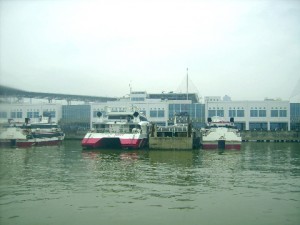
1557 – 1999 Period
In 1557, China allowed Portugal to administer Macau. More than four centuries later, on December 20, 1999, the latter returned the territory to China. Since then Macau has become China’s second Special Administrative Region (SAR) after Hong Kong. It is allowed to enjoy autonomy in all matters except foreign and defence affairs until 2049. On July 16, 2005, ‘The Historic Macau Centre’ was declared as a UNESCO World Heritage Site as it has many architectural legacies, like churches, temples, mansions, fortresses, quaint government buildings and public squares.
Itinerary of Macau Tour
After a three-day tour of Hong Kong my wife and I left Hong Kong for Macau by ferry on 3 May 2007. The ferry ride was rough as the sea was choppy. On arrival at Macau Ferry Terminal, my wife had a slight feeling of nausea. As she could go on we took Bus No. 3 to Macau downtown and checked in at a budget hotel in a street, Rua da Felicidade. Then we left the hotel and began a sightseeing tour of Macau City, immediately.
Below is the itinerary of our memorable Macau tour on 3 May 2007.
1 Macau Roads
2 Senado Square / Holy House of Mercy / Macau Government Tourist Office / St. Dominic’s Church
3 Ruins of St. Paul’s / Crypt and Museum of Sacred Art / Na Tcha Temple
4 Mount Fortress / Macau Sky Tower / Museum of Macau
5 St. Michael’s Chapel / Lou Lim Ieoc Garden / Casinos
6 Macau Fisherman’s Wharf
7 Travel Back to Malaysia
3 May 2007:
Rua da Felicidade (Happiness Road) After checking in at a budget hotel in Rua da Felicidade (Happiness Road), we walked along the road and noticed the old buldings on both sides of the road are small and old. They look like those we saw in Jonker Street in Malacca (Malaysia). Incidentally, Malacca was once a Portuguese territory too. A few of these buildings have become budget hotels for backpackers and restaurants.
Cookie Shop In the same street, there are many shops making and
selling Chinese pastries or cookies, such as almond cakes, egg rolls and cashew-nut cookies as well as red, sweet BBQ thin slices of meat. These cookies shops can also be found in other streets in the Macau Downtown. When we stopped at a shop, a lady-owner generously gave us some small pieces of cookies to try. After tasting a few, we found that we liked the almond cookies the most. They melted slowly in our mouths and the small pieces of almond nuts in them were fresh and crunchy. So my wife bought several boxes of them as presents for our relatives and friends back home in Malaysia.
Avenida Almeida Ribeiro Later, we were in the busiest street in
the city, Avenida Almeida Ribeiro. It is like Orchard Road in Singapore or Nathan Road in Hong Kong. It is difficult to walk on the crowded five-foot ways in the street without being knocked or knocking on somebody, accidentally. On one occasion, I accidentally knocked a man and apologized to him. But he just walked on. I guess it is a common incident in any crowded place and everybody tolerates it.
This street is a tourists’ shopping paradise. Shops sell all kinds of goods like electrical and electronic items, mobile phones,
jewellery, curios, apparels, antiques, traditional Chinese foodstuffs, herbs and medicine, fast food, local and exotic cuisine, watches and Chinese cookies.
Along this road, besides tall, modern buildings, some large quaint ones of fine architectural designs can be seen. A few fine examples are the one that houses the General Post Office, another a bank, China Construction Bank, and another also a bank, Banco Nasional Ultramarino.
Senado Square (Largo do Senado) Near the General Post Office is Macau’s most famous public square known as Senado Square. It is one of the eight squares in Macau. The rest are Barra, Lilau, St. Augustine, Cathedral, St. Dominic, Company of Jesuits and Camoes. Senado Square is surrounded by pastel-coloured neo-classical buildings, creating a Mediterranean ambience. Holy House of Mercy,
the Macau Government Tourist Office and St. Dominic’s Church are some of the quaint buildings located there. The Square has been used for public events and celebrations for centuries. Lots of tourists and locals alike like to visit this beautiful place.
Holy House of Mercy (Santa Casa da Misericordia) This neo-classical style building was founded by the first Bishop of Macau in 1569. It was an institution for western-style medical clinic and other social structures. It is the only white building at Senado Square.
A Museum The House of Mercy houses a museum that was opened in 2001. Its exhibits feature the history of the House itself as well as Macau. They include paintings, manuscripts, a bronze
bell, ivory statues, religious artefacts and Chinese, Japanese and European porcelain pieces.
The Macau Government Tourist Office Opposite Holy House of Mercy is a three-storey yellow building which houses the Macau Government Tourist Office. Free consumer brochures, maps, guidebooks and shopping guidebooks are available here. These are also available at the Ferry Terminal, Airport Arrival Hall, Guia Lighthouse and other places. They provide useful information for tourists like us.
St. Dominic’s Church (Igreja de S. Domingos) Next to the Macau Government Tourist Office is a well-known church, St. Dominic’s Church. This church was built by three Spanish Domincan priests from Mexico in 1587. Its stone facade is yellowish and has white stucco and green-shutted windows.
Inside the church is an altar that has a white statue of Virgin Mary and Child and a painting of Jesus Christ. Some carved ivory and wood saints can be seen inside too.
The Church’s Past History In the past, St. Dominic’s Church had a few violent and dramatic incidents. In 1644, a military Portuguese officer who was a traitor was murdered at the altar during Mass. Then in 1707, the local soldiers tried to enforce an excommunication order on the Dominican friars for supporting the Pope against the Macau’s bishop in the Rites Controversy. But the latter locked themselves in the church for three days, throwing stones at the soldiers. In 1834, when the monastic orders were crushed, the Macau government used the church as a barrack, stable and public works office for a time.
First Portuguese Newspaper It was in this church that the first Portuguese newspaper, A Abelha da China (The China Bee), in the east was printed on 12 September 1822.
There is a museum from the 1st. to 3rd. floor in the church, exhibiting paintings, sculptures and liturgical objects that depict the rich history of the Roman Catholic Church in Asia. It is opened to public since 1997.
Opposite St. Dominic’s Church is a quaint, yellow four-storey building. Its architectural design is similar to the one that houses the Macau Government Tourist Office. It is now a popular place for food lovers who have a choice to savour Chinese cuisine at Chua Lam Gourmet Kitchen or western fast-food at Mcdonalds.
Ruins of St. Paul’s (Ruinas de S. Paulo)
While we were walking on a narrow road, Rua de S. Paulo, from Senado Square to the Ruins of St. Paul’s, we were amazed to see the road crowded with tourists: some going up to the Ruins of St. Paul’s, some coming down to the Senado Square and others stopping by to shop. When we reached the Ruins of Paul’s, we were awestruck to see it still standing majestically on a high ground. This stone facade is all that is left after a church, the Church of Mater Dei (Mother of God), was burnt down in 1835.
The Jesuits The church was built by the Jesuits (members of the Society of Jesus) in 1602-1640. The monumental ruins is now Macau’s icon.
If one stands in front of the magnificent facade and looks closely, one will see carvings and small figures on it. It has statues of Virgin Mary and saints, symbols of the Garden of Eden and the Crucifixion, angels and the devil, a Chinese dragon and a Japanese chrysanthemum, a Portuguese ship and pious warnings in Chinese.
We went behind the facade, climbed up a steel staircase, stood on a high platform, looked through one of the windows in the facade and were captivated by a panoramic view of the Macau Historic Centre below.
The Crypt and Museum of Sacred Art Located behind the
facade is the Crypt where the remains of the martyrs of Japan and Vietnam in urns are displayed. Adjacent to it is a museum, Museum of Sacred Art, where one can see exhibits of paintings, sculptures and liturgical objects of the churches and monasteries of Macau from the 16th. to the 19th. century. These exhibits are testimony to the rich historical past of the active Christian missions in Macau and the Far East.
Na Tcha Temple (Templo de Na Tcha) When we came out of the Ruins of St. Paul’s, we were surprised to see a small Chinese
traditional temple, Na Tcha Temple, on the right-hand side of the Ruins. It was built for a child deity in 1888 by the Chinese who prayed to him for help to contain the plague then. I saw some devotees praying inside. They could be asking the deity for happiness, peace, harmony, prosperity, good health or help to solve their personal problems.
Mount Fortress / Monte Fort (Fortaleza do Monte) We left the Ruins of St. Paul’s and walked up a few fights of steps to a fort, Mount Fortress, nearby. It is a large fortress on the highest hill in the Macau city. It was built
in a trapezoid shape in 1617-1626 and was armed with large cannons pointing in all directions to protect the city in the olden days. Some cannons made in 1860 can be seen on top of the fort and are now a tourist attraction.
A Panoramic View of the Macau City From the top of the fort we had a spectacular panoramic view of the Macau city. We saw many city landmarks such as the Sky Tower in the distance, hospital, high-rise commercial, residential and historical buildings, and churches. Tall buildings are built in the city as land is scarce there.
Macau Sky Tower This tower looks like the one I saw in Auckland in New Zealand in 2003. Its height of about 338 metres is 10 metres shorter than the Auckland Sky Tower. The tower is used for telecommunication and broadcasting and is opened to public since December 19, 2001. It is a popular tourist attraction as it has an observation deck with panoramic views, restaurants, theatres, shopping malls and the skywalk. The skywalk is not for the faint-hearted as the walk is round the outer rim of the tower, 233 metres above the ground. For the thrill-seekers, they can jump off the rim while they are being tethered with a long elastic rope. This is like a
bungee jump. If you have watched an episode in a reality show ‘The Amazing Race: All Stars‘, this tower was used as a roadblock requiring the competitors to do the bungee jump.
Museum of Macau Mount Fortress has a museum known as Museum of Macau. It has three floors of exhibits. The exhibits on the first floor show the historical past of Macau. On the second floor are exhibits that feature different aspects of popular art and traditions of Macau and the third floor shows the modern Macau city.
Chapel of St. Michael After visiting Mount Fortress and Museum of Macau, we walked to Lou Lim Ieoc Garden. On the way, we came across a small green chapel with white stucco and stained glass windows built in a Catholic cemetery. It is known as Chapel of St. Michael and was built in 1875.
Lou Lim Ieoc Garden When we entered Lou Lim Ieoc Garden, we thought it was a beautiful Chinese garden. It is built in the classic Suzhou style with a landscape of flowers, bamboos, rocks, a lake teemed with fish and tortoises and tall plants. It is shady and a
pleasant place to relax and enjoy its charm and beauty. Besides, it has a pavilion, moon gates, a colourful Chinese mural on a wall, an old Chinese house and another new but bigger one, creating an atmosphere of an imperial Chinese garden. Undoubtedly, many local senior citizens like to spend their time there making it as their retreat. When we were in the garden, we saw many of them doing light exercises, playing Chinese chess, catching up on each other’s news and relaxing.
When we entered the new building we were lucky to see an exhibition of Chinese paintings of and calligraphy of a local artist, Gao Lijie (Gao Yin). His 46 exhibits feature animals, human portraits, flowers and landscapes. It was quite an impressive exhibition.
Sands Casino Later, we left Lou Lim Ieoc Garden and took a taxi to Sands Casino. Sands is one of the 28 casinos in Macau. The others are Lisboa, Mandarin Oriental, Fortuna, Galaxy, Rio, President, Babylon, StarWorld, Marina, Grand Waldo, Emperor Palace and Golden Dragon to name a few. Among all the Macau casinos, Sands is the largest so far. It has four floors of many kinds of gambling, like slot
machines, roulettes, dice and card games. A new Macau casino will be ready in August 2007. It is located on a reclaimed land known as Cotai Strip between Taipa Island and Coloane Island. The new casino, The Venetian, will be the largest in Asia and the second in the world.
A Crowded Casino Before entering Sands Casino, we were thoroughly checked for weapons by its security guards. We were not allowed to bring in bottled drinks as they feared that they might be inflammable liquids. When we were inside Sands Casino we were
amazed to see lots of people gambling on all the flours. I noticed most of the gamblers were from Mainland China and Hong Kong. After spending a short time at the casino watching some of them gamble, we headed for a large theme park, Macau Fisherman’s Wharf, which is on the waterfront nearby.
Macau Fisherman’s Wharf At this theme park, there is a 40-metre high man-made black volcano. It belches out smoke and fire with a loud explosion, frequently. It is in an area where there is fun and excitement for children at ‘Vulcania’, ‘Aladdin’s Fort’ and ‘The Underground Amusement Center’.
An International Atmosphere The theme park is unique as it
has many kinds of buildings of different architectural styles, creating an international atmosphere. Each building is given a name of a well-known place where it has the same type of buildings or a famous building that looks similar, like Roman Amphitheatre, Rome, Palace, Italian Riveria, Trinidah, Havana, Amsterdam, Mississippi, New Orleans, Tang Dynasty and Potala Palace. These buildings house restaurants serving local and exotic cuisines, shops selling goods ranging from souvenirs to jewellery, bars, cafes and many more.
At this park, gamblers can try their luck at a large beautiful casino, Babylon, or Flamingo Slot Club which has 285 slot machines. Visitors can stay at a Victorian-style hotel, Rocks Hotel. They may visit a bank which is adjacent to the casino. Since the park has so many facilities, it can be a township itself.
As the park covers a large area (111,500 sq. m.), visitors can hop on to small tour-buses for a free ride.
After visiting a few interesting places in Macau in one day, we went back to our budget hotel.
4 May 2007 Travel Back To Malaysia
On the following morning of 4 May 2007, we left our hotel in the Macau downtown and travelled to Macau Airport. Before entering the immigration checkpoint, we had to leave our drinking bottles behind as they exceeded 100 ml. (Most international airports in the world are now disallowing passengers to carry more than 100 ml. of liquid, gel or cream in a container for security reasons.)
Later, we boarded an Air Asia plane and flew back to our country, Malaysia, bringing along with us fond and memorable memories of the Macau tour as well as the Hong Kong tour. The smooth flight took 3 hrs. and 40 mins.
That’s all about my Macau travel. I hope the information is useful to you.
Written by Choo Chaw, Kl;uang, Johor, Malaysia
Hong Kong Travel / Home / Shenzhen, Hezhou, Quilin, Zhaoqing Travel
Hong Kong Travel (Part II)
{Continued from Hong Kong (Part I)}
Hong Kong Travel (Part II)
Day 2: 1 May 2007
Ocean Park
It is a large theme park covering an area of 87 hectares. It consists of two parts: the Headland on the higher ground and the Lowland on the lower ground. To enter the theme park, visitors can use either the Main Entrance at the Lowland or Tai Shue Wan Entrance at the foot of the Headland. There are covered elevators or cable car to go up to the Headland.
The Park has been in operation for 30 years. It is a place where people, young or old, like to have fun, entertainment and excitement.
With over 40 attractions and rides, the Ocean Park keeps attracting millions of tourists, annually.
At the Ocean Park, thrill-seekers can ride a roller-coaster of The Dragon and Mine Train, drop 60 metres to the ground suddenly made possible by The Abyss, get wet while riding a boat in The Raging River, drive go-karts in Grand Prix, spin in Space Wheel and swing in Flying Swing.
For animal lovers, they can join Animal Close Encounters programs to see animals like foxes, wolves, bull frogs, rabbits, dogs, jelly fish, sea lions, dolphins, fish, pandas, sharks and birds.
Those who enjoy relaxing rides can go for a cable-car ride, Ferris Wheel, Ocean Park Tower and SkyFair Balloon ride.
For show-lovers, they can watch shows performed by dolphins and sea lions at Ocean Theatre, world class ice-skaters at Tai Shue Wan Theatre and birds at Amazing Birds Theatre.
Ocean Park Tower When my wife and I were at Ocean Park, we went for the Ocean Park Tower ride. It rotated as it moved slowly up to a height of 200 metres above sea-level providing a 360 degree aerial view of the South China Sea, Aberdeen and small islands as well as the Headland theme park below. We went up twice as we loved to see the stunning scenery.
Ocean Theatre: A Dolphin and Sea Lion Show
After the enjoyable Ocean Park Tower ride, we went to watch the dolphin and sea lion show at Ocean Theatre which is a stone throw from Ocean Park Tower. Before the show started we were entertained by a group of musicians for half an hour. It was fun to sing along with them.
In the show, three dolphins showed off some stunts, like jumping out of the water to do the twist and turn, and touch a ball high
above the water, giving a trainer a piggy back ride and dancing in the water, while three sea lions made us laughed as they kept teasing their master.
Ocean Park: Lowland After the dolphin and sea lion show, we went to queue outside the cable-car station. It did not take us long to wait for our turn. Sitting in a cable-car and moving down to Lowland, we enjoyed the spectacular, scenic views of Repulse Bay,
the coastline, the lush green terrains, islands and blue South China Sea.
SkyFair Ride On arrival at Lowland, we headed straight for the SkyFair balloon ride. The helium filled balloon took us to a height of 120 metres for bird-eye views of the coastline and South China Sea as well as Lowland below.
The balloon has a diameter of 22 metres, contains 6,000 cubic metres of helium gas and can take 30 passengers in its gondola at a time on a fine day.
After the enjoyable balloon ride, we went to watch an acrobatic show staged by a team of daring young men.
Giant Pandas There are two famous giant pandas, An An and Jia Jia, in their HK$80 million habitat on a higher ground in Lowland. When we were there it was closed to visitors. We were told that it was under renovation.
Later, we went back to Headland by cable-car again to have a last look at the breathtaking scenery. In the evening, we left Ocean Park through Tai Shue Wan Entrance and took a bus, No. 629, to
Central. Arriving at Central, we took another bus, No. 15, to go up the famous Hong Kong peak, Victoria Peak or, simply, The Peak.
The Peak or Victoria Peak The Peak or Victoria Peak is in the south-western part of Hong Kong Island with a height of 552 metres. It is the highest mountain on the island and forms a backdrop of the island city.
The road to the top is narrow, steep and winding. The side of certain parts of the road is almost over the steep slope of the
mountain. While ascending the Peak, our experienced bus-driver, skillfully, negotiated some difficult bends. He, finally, brought us to the top safely in 40 minutes.
The Peak Tower When we reached the height of 395 metres above sea-level on The Peak mountain, we were amazed to see the latest landmark of the island, The Peak Tower, with a height of 33 metres. It is built in a unique modern structure that looks like a large rice-bowl or wok.
The seven floor tower houses restaurants, shops and entertainment areas. It provides a rooftop platform for viewing the breathtaking scenery of the cities on both sides of Victoria Harbour: Hong Kong and Tsim Sha Tsui. The rooftop platform is 428 metres above sea-level.
Peak Galleria Opposite The Peak Tower is a large shopping complex, Peak Galleria. It has lots of shops selling a wide range of goods and restaurants.
The Peak Tower Rooftop In the evening, we went up to the rooftop of The Peak Tower by elevators. When we reached there we
were surprised to see a lot of people there. As it was so crowded we could not get to the edge of the rooftop to have a good view of the skyscrapers of the city below. After waiting, patiently, for a few minutes, we got a good spot. Standing there, we were mesmerized by the awesome panoramic view of the colourfully-lit Hong Kong City below and part of Tsim Sha Tsui City in the distance. It is like a fairyland with a sea of colourful lights.
Fireworks on Labour Day After 8 p.m., fireworks were, suddenly, shot into the air from the city-skyscrapers lighting up the sky, brightly. They were set off, intermittently, to celebrate Labour Day (1 May 2007). The extravaganza lasted for several minutes mesmerizing all of us on The Peak Tower’s observation deck.
Madame Tussauds Hong Kong The Peak Tower has a wax museum known as Madame Tussauds Hong Kong. It houses over 100 stunning life-like wax figures of entertainment, fashion, TV and film celebrities,
historical and national heroes, sports heroes and music icons, like Jackie Chan, Bruce Lee, Leslie Cheung, Andy Lau, Maggie Cheung, Anita Mu, Bae Yong Jun, David Beckham and President Hu Jintao. We did not enter the wax museum as we have visited one in London.
The Peak Tram Visitors can go up or down The Peak by The Peak Tram. It is the world’s steepest funicular railway that brings 120 passengers up the Peak in about 8 minutes each time. It is pulled up along a 1.4 km track by a thick haulage rope. The gradient of the track is between 4 and 27 degrees. When the tram is moving along a steep track, the passengers will think that the nearby buildings are tilting.
The Peak Tram is similar to the one on Penang Hill in my country, Malaysia. It has been in operation since 1888. While riding on the tram, passengers will have panoramic views of the cities on both sides of Victoria Harbour and the harbour itself. (Ticket: HKD30 one way)
The Peak Descend At 8.40 p.m. we came out of The Peak Tower and decided to descend the mountain by The Peak Tram. But we were shocked to see a very long queue outside The Peak Tram terminal. As we were not sure how long we had to wait for the tram, we decided to go down The Peak by bus No. 15 again.
While descending The Peak, we felt the bus jolted a few times along the long, narrow and winding mountain road. But the skilful driver brought us safely to the foot of The Peak in 25 minutes, 15 minutes faster than the ascend!
Day 3: 2 May 2007
A Visit to Lantau Island On the third and last day of our stay in Hong Kong, we decided to go to Ngong Ping Village on Lantau Island to see a giant Buddha statue, known as Tian Tan Buddha. It would be a welcome change for us to visit a countryside.
Lantau Island After breakfast at Mongkok we took an MTR train
to Tung Chung, a small town on Lantau Island. Lantau Island with a small population of 45,000 people is the largest island of Hong Kong. The views of Its pristine terrains of lush green valleys and mountains are spectacular. The island’s highest mountain, Lantau Peak, has a height of 934 metres. Half of the island is now protected for its natural beauty and charm.
Skyrail On arrival at the Tung Chung MTR station, we proceeded to the Skyrail terminus nearby to buy tickets for the cable car ride
to Ngong Ping. Although there was a long queue to the ticketing counters, it was moving fast.
A “Special Day” After 20 minutes of lining up, I finally came to a ticketing counter. I was shocked when the ticket seller told me that I had to pay HKD10 more for a ticket as that day was a “special day”. But I told him that the price of a ticket should be reduced as it was a “special day”. He then explained that “special day” means ” holiday” when there were many visitors and so the
price of a ticket was increased. Having understood what he meant, I paid for the tickets for the Skyrail ride for my wife and myself .
Skyrail was opened on 18 September 2006. It is a 20-25 minute cable-car ride from Tung Chung to Ngong Ping Village as the distance is 5.7 km.
A Scenic Journey to Ngong Ping Village While we were in a Skyrail cable-car moving over Tung Chung Bay towards Hong Kong International Airport, we saw airplanes taking off from the airport one at a time. Then our cable-car turned at an angle at Airport Angle Station and moved away from the airport and over the bay again towards Lantau Island.
As it was gliding high above the island, we had breathtaking views of lush green mountains and valleys of North Lantau Country Park and the South China Sea. Occasionally, we saw nature walking tracks in the protected park.
Soon we saw Ngong Ping Village and a figure, Giant Buddha or Tian Tan Buddha, sitting serenely on top of a hill in the distance. Finally, we arrived at Ngong Ping Village.
Ngong Ping Village The village looks new and has been
designed and landscaped to reflect the Chinese ancient culture and spirituality. The houses look like those we saw in Beijing Hutong.
An Amazing Act Entering the village we were attracted by a small crowd watching a show performed by some Chinese men dressed in red Kung-fu uniforms. They were demonstrating their acrobatic, fighting and other skills on a small stage. One of their acts amazed me. In the act, a man in red stood barefooted on sharp knives without getting hurt in the soles of his bare feet.
“Walking With Buddha” and “Monkey’s Tale” As we strolled through the crowded small village, we passed shops selling food and drinks, souvenirs, antiques, apparels, etc. There is a Chinese traditional building with red walls and yellow roof featuring a multimedia show, “Walking With Buddha”, that traces the Buddha’s path to enlightenment. Another building nearby shows an animation presentation about a monkey learning the importance of humility and kindness. It is called “Monkey’s Tale”. Having seen the village, we entered a large garden known as Tian Tan Garden.
Tian Tan Garden (‘tian tan’ in Chinese means ‘heaven’) We left the Ngong Ping Village and entered a
garden adjacent to it. The garden is known as Tian Tan Buddha Garden which was opened on 10 September 1996. In the middle of the garden stands a large bronze Chinese traditional urn with three large colourful joss-sticks planted in the middle. Near the urn is a circular mound altar which is smaller than the one in front of the Temple of Heaven in Beijing. There is a row of stalls further down selling postcards, hats, fruits, ice-cream, drinks, snacks, etc.
Giant Buddha or Tian Tan Buddha Standing in the middle of the garden, we looked up and saw a huge bronze Buddha statue sitting on a lotus throne atop a hill. Many tourists were walking up the 268 steps to the statue. The statue is known as Giant
Buddha or Tian Tan Buddha which is 34 metres tall. It is the tallest seated outdoor bronze Buddha statue in the world. Completed in 1993, it took the engineers 10 years to construct the large figure. It is an engineering feat.
On the way up the steps, we saw a few large bronze sculptures, like an ancient Chinese urn and lamp, in the middle of them. The climb to the top was slightly difficult, as it was long and steep (about 268 steps). But when we reached the top we totally forgot about our tired legs. It was because we were overwhelmed by the hugeness of the statue. Besides, the panoramic views of the Ngong Ping terrains and the bird’s eye view of Tian Tan Garden and a Buddhist monastery, Po Lin Buddhist Monastery, near the garden, were spectacular. Kneeling down at the base of the Giant Buddha
statue are six bronze statues of beautiful ladies each making an offering to Him.
Po Lin Buddhist Monastery and Wisdom Path Po Lin Buddhist Monastery was built in 1917. (“Po Lin” in Chinese means “Precious Lotus”). Not far from the monastery is a place where tall wooden pillars carrying sacred texts are planted in a figure of the infinity symbol, symbolizing the immeasurable splendour and infinity. This place is known as “Wisdom Path”.
Return to Tung Chung After an enlightened tour of Ngong Ping Village and Tian Tan Buddha Garden, we walked to the Ngong Ping station and boarded a Skyrail cable-car. Then we were on our way back to Tung Chung.
As we were travelling to Tung Chung by Skyrail, we saw an unusual thing on a high hill. It was a lonely white Chinese graveyard. I wonder whose graveyard that is and why it is high up there.
Before reaching Tung Chung, we saw some fishermen in the waist-deep water of the Bay of Tung Chung searching for shellfish.
Tsing Ma Bridge On arrival at Tung Chung, we took a bus to Admiralty. On the way, we crossed a long suspension bridge known as Tsing Ma Bridge. It has two decks carrying road and rail traffic and is part of the Lantau Link which links Lantau Island as well as Hong Kong International Airport to the urban areas in Hong Kong. Opened in 1997, Tsing Ma Bridge is the world’s longest road-and-rail suspension bridge (1.4 km long) but the 6th. longest suspension bridge (2.1 km long).
On arrival at Admiralty, we decided to go to Hong Kong Convention and Exhibition Centre in Wan Chai.
Hong Kong Convention and Exhibition Centre At Hong Kong Convention and Exhibiton Centre, we were surprised to see a multitude of tourists there. The Centre is a large building with the world’s tallest glass wall and a roof that resembles a seagull’s wings in flight. Opened in 1988 and expanded in 1997, the integrated complex houses exhibition halls, theatres, hotels and restaurants.
Golden Bauhinia Square Located in front of Convention and Exhibition Centre is Golden Bauhinia Square. It was at that square that the historic ceremony at which Britain handed over Hong Kong’s sovereignty to China at midnight on 1 June 1997 was held. Erected in the square is a beautiful gold-coloured monument of a flower known as “Forever Blooming Bauhinia” to commemorate the handover in 1997.
Bauhinia trees are common in Hong Kong and produce large beautiful flowers that have become the emblem of the Hong Kong flag.
Star Ferry Having visited Hong Kong Convention and Exhibition Centre,
we went to the Wan Chai ferry pier to board a green-and-white ferry, Star Ferry, to Tsim Sha Tsui in Kowloon. (Fare : HK$2.20).
The ferry began its operation in 1898. As it was crossing Victoria Harbour, we saw spectacular sceneries of the cities on both sides of Victoria Harbour and a large cruise ship known as Star Cruise Pisces berthed at a terminal. This ship reminds me of her sister
ship in Singapore known as Star Cruise Virgo which brought my wife and I on an enjoyable cruise in the Straits of Malacca on 11 September 2001 (American date).
Clock Tower When we arrived at Star Ferry Terminal in Tsim Sha Tsui, we went outside the terminal and saw a tall structure in an open space. It was Clock Tower which was erected in 1915 as part of the former Kowloon-Canton Railway Terminus. When the terminus was demolished in 1978 Clock Tower was left untouched . This 44-metre tall tower, built of red bricks, was declared a historical monument in 1990.
As we were strolling along the Tsim Sha Tsui promenade, we came across a few prominent buildings. Among them were the following:
Hong Kong Cultural Centre
It is a venue for classic performing arts, Western and Asian.
Hong Kong Museum of Arts It features Chinese antiquities, paintings and calligraphy, arts works from around the world and many more.
Hong Kong Space Museum Opened in 1980, it features astronomy exhibits. Besides, its egg-shaped roof houses Stanely Ho Space Theatre where Omnimax and Sky shows are presented. When I was there the museum was advertising three shows, viz. “Small Solar System Bodies”, “Jan Goodall’s Wild Chimpanzees” and “Mystic India”.
In the evening, we left Tsim Sha Tsui for our hostel, Dragon Hostel, in Argyle Road in Mongkok. At the hostel, Stanley, the kind, helpful and friendly hostel owner, allowed us to use his Internet service for free. We took that opportunity to send e-mails to our loved ones in Malaysia and Singapore.
Day 4: 3 may 2007
Departure for Macau In the following morning, we left Hong Kong with fond memories. We travelled by ferry to Macau to have a day tour there before going back to Malaysia.
I hope you have enjoyed reading this travelogue.
Written by Choo Chaw, Kluang, Johor, Malaysia

